AND FREAKY SINCE 1971








FREE AND FREAKY SINCE 1971 | APRIL 28, 2022
14 Garcia | Public Meetings Notes from a recent public safety meeting in Pilsen that turned contentious
18 The TRiiBe Here’s what Black voters should pay attention to in the midterm elections
CITY LIFE
04 Street View Guests serve the best of “dopamine dressing” at EXPO Chicago.
COMMENTARY
06 Isaacs | Culture Chicago’s blessed with a motherlode of stunning churches.
NEWS & POLITICS
08 Photos The Reader editorial union rallied with labor allies, nonunion staff, and supporters
ARTS & CULTURE
21 Art With the exhibition “BIG WORDS,” enterprising multimedia artist Brandon Breaux shows what he’s made of.

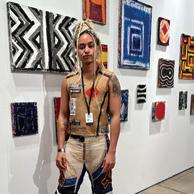
23 Comics Time Zone J marks a welcome return by beloved writer and illustrator Julie Doucet.
THEATER
24 Reid | Gods and Puppets Ross Lipman collaborates with Chicago theater friends in his latest essay/ documentary.
11 Free the Reader Staffers picketed co-owner Leonard C. Goodman’s Lakeview home in support of the city’s oldest free alt-weekly.

26 Plays of Note Intimate Apparel gets an impeccable revival at Northlight; Rasheeda Speaking tackles overt and subtle office racism; and MPAACT’s Pulled Punches delivers twists and turns.
FILM
28 Movies of Note The Bad Guys is Ocean’s Eleven with animals; Dealing with Dad delivers a fresh perspective on one of Hollywood’s most recycled tropes; and The Unbearable Weight of Massive Talent is intermittently awesome.
30 Small Screen Actor and writer Langston Kerman showcases the absurdity of the midwest on South Side and Bust Down
32 Review Robert Eggers’s The Northman leans too much on Viking nostalgia and the male power fantasy.
MUSIC & NIGHTLIFE
34 Chicagoans of Note Celia Rose, cofounder of music agency What Up Pitches
36 The Secret History of Chicago Music Prog rockers Apocalypse debut with a dazzling 46-year-old demo.
CHICAGO READER | APRIL 28, 2022 | VOLUME 51, NUMBER 15
Negro, and more, plus reviews of releases by Congotronics International, Defcee & BoatHouse, and Supa Bwe 48 Early Warnings Rescheduled concerts and other updated listings
Gossip Wolf Indie-pop goo alls Baby Teeth ratchet up their reunion with another single, Spread Joy celebrate a new album of nervy postpunk at the Hideout, and Terra Squad Footwork Company honor a fallen comrade in South Shore.

SAVAGE LOVE
Dan Savage offers advice to a man whose wife wakes up at 3 AM to masturbate.
TO CONTACT ANY READER EMPLOYEE, E-MAIL: (FIRST INITIAL)(LAST NAME) @CHICAGOREADER.COM
PUBLISHER AND PRESIDENT TRACY BAIM
PUBLISHER AND EDITOR IN CHIEF KAREN HAWKINS
PRODUCTION MANAGER KIRK WILLIAMSON
SENIOR GRAPHIC DESIGNER AMBER HUFF
STORY EDITOR SUJAY KUMAR
CULTURE EDITOR SALEM COLLO-JULIN
NEWS EDITOR JIM DALEY
THEATER AND DANCE EDITOR KERRY REID

MUSIC EDITOR PHILIP MONTORO
ASSOCIATE EDITORS JAMIE LUDWIG, TARYN ALLEN
SENIOR WRITERS LEOR GALIL, DEANNA ISAACS, BEN JORAVSKY, MIKE SULA
STAFF WRITERS KATIE PROUT, KELLY GARCIA
AUDIENCE ENGAGEMENT MANAGER YASMIN ZACARIA MIKHAIEL
EDITORIAL ASSOCIATE JANAYA GREENE
LISTINGS COORDINATOR MICCO CAPORALE
VICE PRESIDENT OF OPERATIONS ANN SCHOLHAMER
DIRECTOR OF DIGITAL JOHN DUNLEVY
DIRECTOR OF DEVELOPMENT JT NEWMAN DEVELOPMENT ASSOCIATE DJEMANESH ANETENEH
DIRECTOR OF MARKETING VIVIAN GONZALEZ
SPECIAL PROJECTS ASSOCIATE SHAWNEE DAY MEDIA PARTNERSHIPS COORDINATOR YAZMIN DOMINGUEZ
CIMA SUPPORT SPECIALIST SAVANNAH HUGUELEY EXECUTIVE ASSISTANT SANDRA L. KLEIN
ADVERTISING
312-392-2970, ADS@CHICAGOREADER.COM CLASSIFIEDS: CLASSIFIED-ADS@CHICAGOREADER.COM
VP OF SALES AND BUSINESS DEVELOPMENT AMBER NETTLES
40 Obituary Cynthia Plaster Caster broke the mold.
42 Shows and Records of Note Previews of concerts by Vijay Iyer and friends, Juana Molina, Helado
VICE PRESIDENT OF SALES AMY MATHENY SALES TEAM VANESSA FLEMING, LENI MANAA-HOPPENWORTH, TIM OGDEN, TED PIEKARZ, WILL ROGERS, LISA SOLOMON DIGITAL SALES ASSOCIATE AYANA ROLLING
NATIONAL ADVERTISING VOICE MEDIA GROUP 1-888-278-9866 VMGADVERTISING.COM JOE LARKIN AND SUE BELAIR
2 CHICAGO READER - APRIL 28, 2022 ll
48
50
CLASSIFIEDS 52 Jobs 52 Apartments
Spaces 52 Matches THIS WEEK
Quickies
&
THIS WEEK ON CHICAGOREADER.COM
The Chicago Reader is free— again—and still freaky
ON THE COVER: ILLUSTRATION BY KIRK WILLIAMSON.
CONCERNS distributionissues@chicagoreader.com
1096-6919) IS PUBLISHED BIWEEKLY BY CHICAGO READER L3C
© 2022 CHICAGO READER PERIODICAL POSTAGE PAID
ALL RIGHTS RESERVED. CHICAGO READER, READER, AND REVERSED R: REGISTERED TRADEMARKS
IN THIS ISSUE Reader co-owner Leonard C. Goodman has reportedly dropped his opposition to the newspaper’s transition to a full nonprofit.
DISTRIBUTION
312-392-2970 READER (ISSN
2930 S. MICHIGAN, SUITE 102 CHICAGO, IL 60616 312-392-2934, CHICAGOREADER.COM COPYRIGHT
AT CHICAGO, IL
®












APRIL 28, 2022 - CHICAGO READER 3 The ReaderDaily Get our free daily newsletter delivered straight to your inbox Monday through Friday! Dive into our most recent stories and exclusive insights from our co-publishers, editors, and staff writers. LLOYD DEGRANE chicagoreader.com/newsletters
CITY LIFE
Street View
Style comes back with a vengeance at EXPO







Guests serve the best of “dopamine dressing” at the annual art fair.
 By ISA GIALLORENZO
By ISA GIALLORENZO
Whoever says people don’t have much style in Chicago has no idea what they’re talking about.
I’ve been photographing street style here for over ten years and I know better. When Chicagoans decide to bring it, they bring it with gusto, authenticity, and a very midwestern ease.
That’s the kind of style that could be
seen at EXPO Chicago this year: the best of the best, from Chicago and beyond. After a long hiatus, the art crowd was ready to display their happiest garments. Be it flashy or demure, maximal or minimal, in color or in neutral tones: the joy of dressing could be seen all around. The photos are here to show it. v
@chicagolooks
4 CHICAGO READER - APRIL 28, 2022 ll
EXPO CHICAGO
More photos from the art fair at Navy Pier are viewable at chicagoreader.com. The next fair is scheduled for April 2023 ; see expochicago.com for details.
Artists, curators, and patrons attended EXPO’s opening night on April 13 at Navy Pier’s Festival Hall. ISA GIALLORENZO




















































































APRIL 28, 2022 - CHICAGO READER 5 SOMETHING READER FOR EVERYONE! store.chicagoreader.com PLAY TODAY! pleaserecyclethispaper
Chicago’s blessed with a motherlode of stunning churches
Fire is not their greatest danger.
By DEANNA ISAACS
What kind of God allows a church to burn down on Good Friday?
That’s the question that came to mind when the 130-year-old Antioch Missionary Baptist Church at Stewart and 63rd Street went up in flames earlier this month, followed by a familiar answer: the same god that has allowed slavery, Holocaust, plague, war, and the whole human history of disaster.
Antioch’s pastor, the Reverend Gerald Dew, had a di erent, more positive take on it. Faced with an inferno, he saw opportunity.
On Easter Sunday, according to news reports, Dew told his flock (meeting in a nearby funeral home) that, just as Jesus rose from the dead, resurrection will be possible for Antioch Baptist. He vowed that the congregation will raise money to rebuild on the same Englewood site.
Turned out that this fire, like the one that took down Adler and Sullivan’s Pilgrim Baptist Church in Bronzeville in 2006 (and, possibly, the conflagration that engulfed Paris’s Notre-Dame Cathedral in 2019), was caused
by maintenance work. In this case, a roofer’s torch gone awry. The damage to Antioch’s imposing Romanesque building, designed by Bell & Swift for a previous Baptist congregation and home to the current one since 1958, was so severe that the city ordered that the massive structure be taken down immediately.

Not an easy task: the place was built for the ages. Anyone who happened by toward the end of last week isn’t likely to forget the sight of the roofless but still fortress-like shell, open to the elements.
The fire led me to tune in on Easter Sunday, when WTTW aired a one-hour documentary, Secrets of Sacred Architecture (still available for streaming with station membership). A primer on the design of religious institutions, mostly churches, it surveyed the origins and reasons for such staples as pointed arches, stained glass windows, towering steeples, organs, and gargoyles (and included this piece of trivia: when the Chicago Customs House and Post O ce was to be razed in 1896, it was, essentially, dismantled and shipped to Milwaukee, where its stones were used to construct that city’s landmark Basilica of St. Josaphat).
A couple of Chicagoans are featured in the documentary: architect RaMona Westbrook, talking briefly about the Black history depicted in stained glass windows at Chicago’s Trinity United Church of Christ, and Illinois Tech College of Architecture dean Reed Krolo , who notes, among many other things, that the idea of a single national church representing everyone—as in the Washington National Cathedral, a Gothic Revival masterpiece that took 83 years to complete—is an irony in a country founded on plural religious expression.
In an interview after the broadcast, Krolo said the thing that sets religious architecture of any kind apart is that, “When done well, it’s a physical expression of our search for meaning.”
Krolo , a relative newcomer to Chicago (he moved here in 2018), says we’re unusually
blessed with religious buildings, “so many that are worth a visit.” I wondered which he thinks shouldn’t be missed; his o -the-cu list included Bahá’í House of Worship, Unity Temple, First Church of Deliverance, Fourth Presbyterian, and the only one I hadn’t seen, the Church of the Holy Family on Roosevelt Road. I’ve seen it since we spoke: the second oldest Catholic church in Chicago and a survivor of the Great Fire, it’s a stunner that narrowly escaped demolition as recently as 1990.
Preservation Chicago’s 2022 list of the city’s seven “Most Endangered” buildings includes just one church, the former St. Martin du Tours (more recently Chicago Embassy Church). Perched just west of the Dan Ryan at 59th Street, it’s a delicate German Gothic completed in 1895 and closed for most of the last 30 years.
But in 2019 and 2021, alarmed by the Archdiocese of Chicago’s euphemistically titled “Renew My Church” program, Preservation Chicago included Roman Catholic churches throughout the city on the endangered list, spotlighting “the consolidation, deconsecrating, combining, closure and sale of many of our city’s finest religious structures.”
“These immensely beautiful structures were constructed at great cost, and often at significant sacrifice, with pennies, nickels, and dimes, by the faithful of the community. They are often the very cornerstones of our communities and neighborhoods . . . [and] are also community centers, providing everything from food pantries [and] shelter services to counseling and child care,” is what they wrote then.
“It’s heartbreaking,” to lose them, especially when they could be repurposed if necessary, Preservation Chicago executive director Ward Miller told me last week. Among the many he hopes can be saved: St. Michael the Archangel on South Shore Drive, where his great-grandparents were married in 1895, and the shuttered and much-mourned St. Adalbert in Pilsen, with its perilous, sca olded—but not yet landmarked—twin towers.
At 63rd and Stewart last Friday, as a rainstorm pelted the remains of Antioch Missionary Baptist, a blown-out window o ered a glimpse of the kind of miracle such grand-scale preservation might require. On a huge, drenched interior mural, Jesus was still rising above his disciples, floating up from the ruined church into an impossibly serene blue sky. v
6 CHICAGO READER - APRIL 28, 2022 ll
COMMENTARY
Antioch Missionary Baptist Church a er the April 15 fi re DEANNA ISAACS CULTURE
@DeannaIsaacs
ATTENTION
ATTENTION ALL HCV PROGRAM PARTICIPANTS, PUBLIC HOUSING RESIDENTS, & RAD PBV RESIDENTS
If you listed Lawndale Complex or the Lawndale Community Area on your Housing Choice Survey as a place you would like to permanently live, please read the information listed below.
Proposed Updates to the Housing Choice Voucher (HCV) Administrative (Admin) Plan, Admissions and Continued Occupancy Policy (ACOP), & Lease
The Chicago Housing Authority (CHA) is releasing proposed updates to the FY2022 HCV Admin Plan, ACOP & Lease for public comment.

The 30-day public comment period begins April 29 and ends May 31, 2022. While CHA encourages and welcomes all program participants, residents, and the community-at-large to review the proposed updates to the FY2022 HCV Admin Plan, ACOP & Lease you are not required to attend the public comment hearings in order to submit comments. Your presence or absence at the hearing does not a ect your housing.
The Draft Tenant Selection Plan (TSP) and Lease for Ogden Commons, a mixed-income community is available for review. The Chicago Housing Authority (CHA) has worked with its development partner to develop a Draft TSP and Lease for use at the private development known as Ogden Commons (previous site of the Lawndale Complex). The units within this development will be used as replacement public housing units for Lawndale Complex and the Lawndale Community area. If you listed Lawndale Complex/Lawndale Community area on your Housing Choice Survey as a place you want to live or maintain a right to return to new CHA replacement housing per the Relocation Rights Contract (RRC), you can comment on the Draft TSP and Lease during the 30-day public comment period.
The 30-day public comment period will be held for CHA to receive written comments starting April 7 through May 7, 2021. The Tenant Selection Plans (TSP) will be available on CHA’s website beginning April 7, 2021.

CHA will host two public comment hearings, livestream, and in-person: Wed, May 11, 2022 at 6:00 pm, FIC 4859 S Wabash (Sign and Spanish interpreters will be present.) and Mon, May 16, 2022 at 11:00 am, https://youtu.be/PgGi1HWFytM or go to www.thecha.org click HCV-ACOP Public Hearing button (A recording of the livestream session will be available following the hearing. Sign and Spanish interpreters will be present.)
Due to COVID-19, CHA has suspended all in person public meetings and instead, CHA will livestream one public comment hearing. The date and time of the public comment livestream hearing is as follows:
Tue, April 20, 10:00am: https://youtu.be/QBGG47BHXMg
We ask that comments pertaining to the HCV Admin Plan, ACOP & Lease be submitted electronically to commentontheplan@thecha.org prior to the livestream session or submitted in the chat during the livestream. All comments will be added to the comment grid and receive a response during the livestream and/or in writing in the comment grid.
We ask that comments pertaining to the TSP & Lease be submitted electronically to commentontheplan@thecha.org at least 48-hours prior to the comment hearing. Comments will be read live during the time outlined above. Comments received after the hearing will be added to the comment grid.
A summary and the full Proposed FY2022 HCV Admin Plan, ACOP & Lease will be available on CHA’s website at www.thecha.org April 29. You may also mail or fax comments for the Proposed FY2022 HCV Admin Plan, ACOP & Lease. All comments must be postmarked and received by May 31, 2022.

If you require translation services, please read the attached notice or check with your property manager for more details. Do not mail comments to CHA.
Mail, E-mail or Fax comments to:


Chicago Housing Authority
E-mail or Fax comments to: commentontheplan@thecha.org Fax 312. 913.7837
Attention: Proposed FY2022 HCV Admin Plan, ACOP & Lease 60 E. Van Buren Street, 12th Floor Chicago, IL 60605
Email: commentontheplan@thecha.org | Fax: 312. 913.7837
Ifyouhaveaquestionaboutthisnotice,pleasecalltheCHAat312.913-7300.
Torequestareasonableaccommodation,pleasecall312.913.7062.
If you have a question about this notice, please call 312.913-7300. To request a reasonable accommodation, please call 312.913.7062. TTY 866.331.3603
TTY 866.331.3603
APRIL 28, 2022 - CHICAGO READER 7
All $ spent on any resale items benefits the environment. By slowing virgin resource extraction, you help birds, bees, butterflies, and ALL WILDLIFE HABITAT!
Sun and solidarity
TEXT BY JIM DALEY; PHOTOS BY LENI MANAA-HOPPENWORTH
On April 21, the Reader editorial union rallied with labor allies, nonunion sta , and supporters outside the Lakeview mansion of the newspaper’s co-owner, Leonard C. Goodman, to demand he allow its longplanned transition to a nonprofit to proceed. The demonstration attracted national media attention, and helped break a four-month stalemate between opposing factions on the Reader’s board. On Tuesday, Goodman announced he and three board members allied with him were stepping down. v

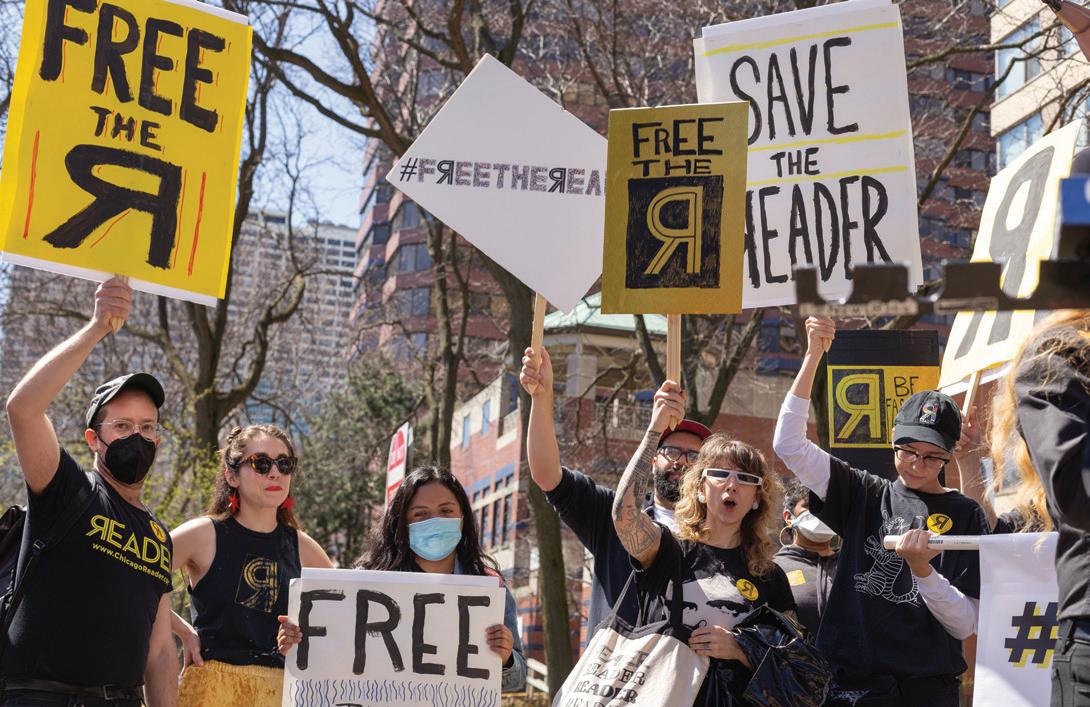
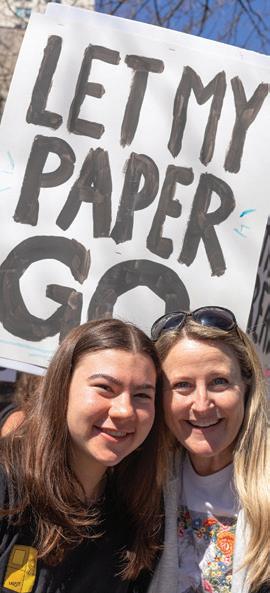

8 CHICAGO READER - APRIL 28, 2022 ll
NEWS & POLITICS
LABOR
LENI MANAA-HOPPENWORTH
A Reader union rally drew labor leaders, politicians, and supporters.

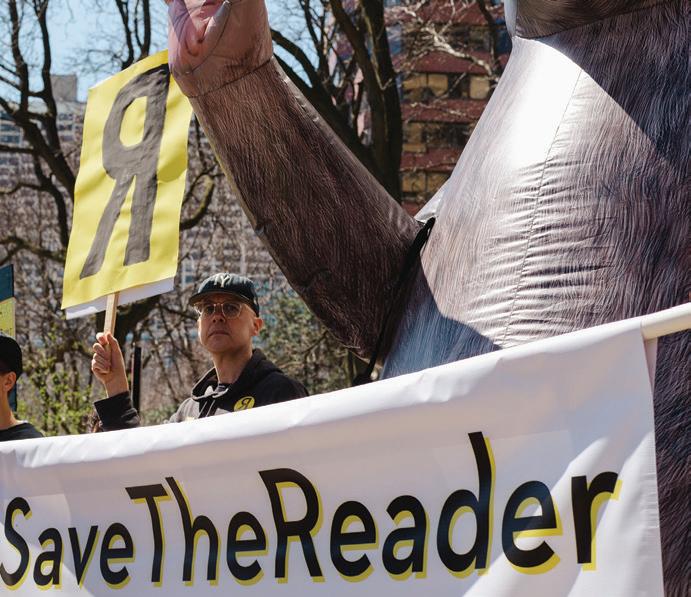
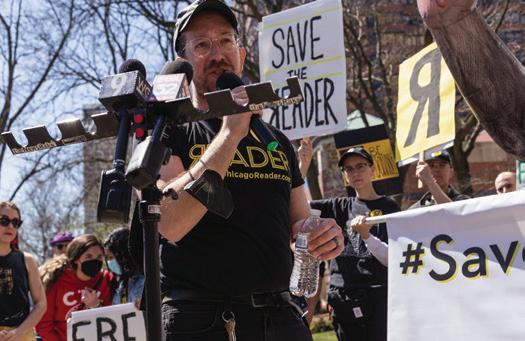
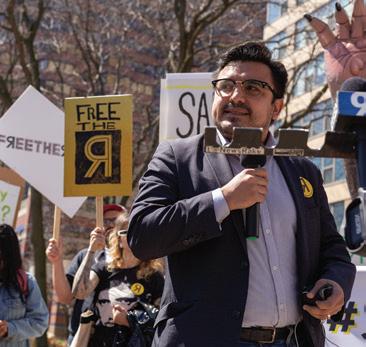




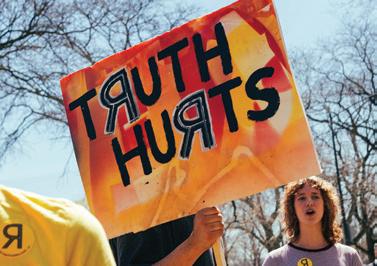
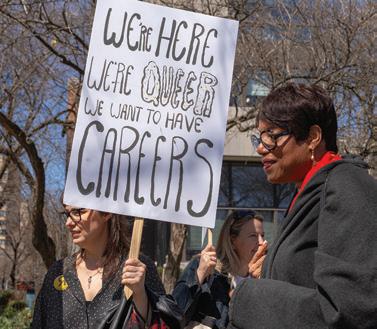
APRIL 28, 2022 - CHICAGO READER 9 NEWS & POLITICS
LENI MANAA-HOPPENWORTH
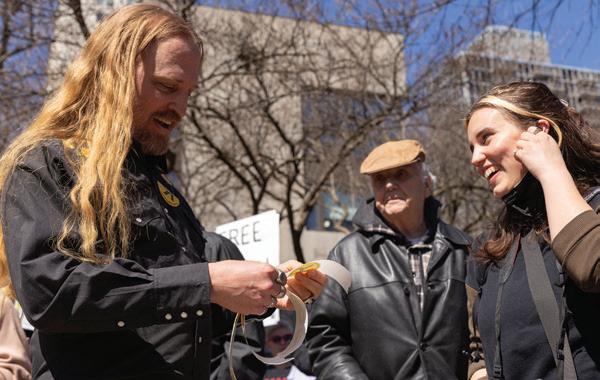


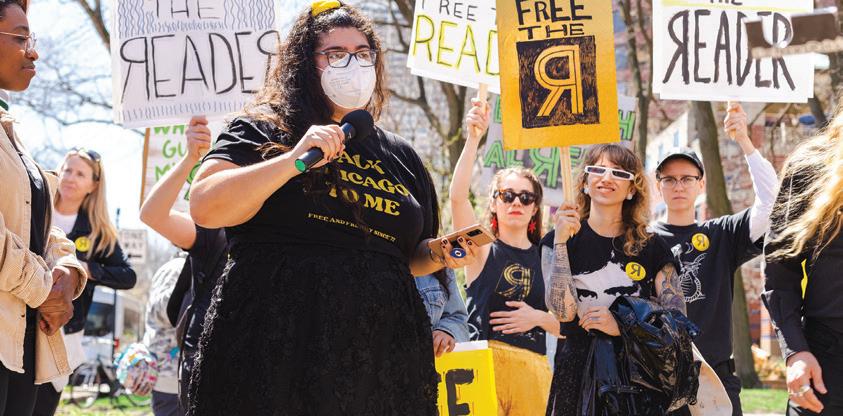


10 CHICAGO READER - APRIL 28, 2022 ll
& POLITICS
NEWS
LENI MANAA-HOPPENWORTH
LABOR
“Free the Reader!”
Staffers picketed Reader co-owner Leonard C. Goodman’s Lakeview home in support of the city’s oldest free alt-weekly.
By ELLY BOES & GRACE DEL VECCHIO, 14 EAST MAGAZINE
sta members received their last guaranteed paycheck, launching the 35-plus sta ers into further uncertainty.
The Reader and its editorial union are close to a much-anticipated transition from its for-profit company to a new nonprofit organization called the Reader Institute for Community Journalism (RICJ).

public and Goodman’s column remains online as published.
Because the for-profit company is running out of payroll funds, the Reader union decided to call attention to the stalemate with the public demonstration.
Mikhaiel, whose job description includes strategizing around the newspaper’s future growth. They said that for many of those employed by the Reader, their roles have turned into ones of advocacy.
As we went to press with this issue, the Tribune reported that Reader co-owner Leonard C. Goodman, as well as board members Dorothy Leavell, Sladjana Vuckovic, and Carol Bell stepped down on Tuesday. The move will allow the transition to a nonprofit to proceed.
On April 21—an unseasonably warm day—the Reader’s editorial union, staff, and supporters held a rally outside co-owner Leonard C. Goodman’s home, with signs that read: “Len Goodman, Local Bad Man,” “Let My Paper Go,” and “Save the Reader,” among many others. The rally was held a day before the Reader
However, the process stalled in December after the Reader published a column by Goodman, who began writing for the paper after he acquired it with developer Elzie Higginbottom in 2018 for a dollar; the pair assumed the paper’s debts and kept it alive.
In the November column, Goodman questioned the efficacy of COVID-19 vaccines for children. After its publication, Reader staffers and readers raised concerns that the column presented misinformation, and management pushed to publish an independent fact-check of the column. Goodman disagreed, and Reader board members Dorothy Leavell and Sladjana Vuckovic introduced resolutions to force the newspaper to adopt an anti-censorship mission statement.
The nonprofit transition has stalled since then. The fact-check has not yet been made
Several days before the rally, Goodman tweeted that the Reader is unable to see “opposing points of view.”
Goodman did not respond to the Reader’s request for comment by the time of publication.
Yasmin Zacaria Mikhaiel, an adjunct theater professor at DePaul University who has a background in dramaturgy, didn’t realize their position of audience engagement manager at the Reader was their dream job until they were o ered it. Hired in September 2021 for the newly created position, Mikhaiel said it speaks to the growth period that the Reader had recently begun despite “untenable conditions” created by COVID-19.
In speeches at the rally, Reader staffers noted the increased di culty of completing their jobs while the fate of their jobs hangs in the balance. This is especially the case with
“Since the situation started in November, it’s been handling a lot of some of those crisis communications that have swirled around the Reader and doing a lot of advocacy work internally and ensuring that our writers— [and] that our writing still matters, and that we have audiences that believe in us and that we can still be doing our jobs even if we’re very burned out and understa ed,” Mikhaiel said.
As chants of “Free the Reader ” died down at the rally, Reader union chair Philip Montoro led a press conference with staff, supporters, and journalists from all over the city.
The TRiiBE’s cofounder and editor-in-chief Tiffany Walden, 25th Ward alderperson Byron Sigcho-Lopez, 35th Ward alderperson
Carlos Ramirez-Rosa, Chicago Teachers Union president Jesse Sharkey, and representatives from the Chicago Federation of Labor also spoke.
“If I wasn’t here, I’d be writing about tor-
APRIL 28, 2022 - CHICAGO READER 11
HELEN WARGO
NEWS & POLITICS
tilleria workers in Brighton Park organizing against their greedy employers,” sta writer Kelly Garcia said during the press conference. “But instead here I am doing the same.”
Garcia works in the Reader’s Racial Justice Reporting Hub and Writers Room, a team that freelance Reader contributor Taylor Moore said is “hanging in the balance because of Len Goodman.”
After the press conference, Brandon Pope, the president of the National Association of Black Journalists Chicago Chapter, chatted with colleagues near Goodman’s home.
“The Reader has been a pivotal voice for diverse communities, but specifically, the Black community and Black voices of all types, especially Black queer voices throughout our city,” he said. “By cutting the Reader ’s ability to become a nonprofit, or stalling when it comes to it, it hurts the ability of these amazing writers to do what they’re here to do. And that’s [to] advocate for our communities and be there for our communities.”
Of the dozens of people gathered outside of Goodman’s home were those who signed an “Open letter to Len Goodman from Chicago journalists,” published by the Reader Union on April 20. As of Monday, the letter had garnered nearly 400 signatures from fellow journalists,

writers, and creatives from across the country.
Among the signees was Chicago-born filmmaker Lilly Wachowski, who also attended the rally. A self-proclaimed lifelong lover of the Reader, Wachowski has come out in full support of the paper and its sta and thinks that Goodman’s actions are, in a word, hypocritical.
“I’m standing with folks who are just trying to make their way in the world and for somebody who is, like, purporting to be all about free speech. That doesn’t seem like it’s their main motivation,” she said of Goodman.
“When you think about this newspaper on the brink of collapse, that does so much in the name of free speech and journalism, I think that Len Goodman’s motives are highly questionable.”
Beyond that, Wachowski’s connection to the Reader is personal. In 2016, Wachowski went to Reader publisher and president Tracy Baim to publish her public statement in the Windy City Times, in which she came out as transgender after other media outlets threatened to out her.
“I knew that were I to let the sort of media nature take its course, it would have been an extremely traumatic experience for me, and so I went to Tracy because I knew, or I have a pretty good idea of how much integrity she
has, as a journalist and as a human being,” Wachowski said.
“I couldn’t have really asked for a better person to help me get that media statement out into the world.”
Her criticism of Goodman is rooted in her love for the Reader and also comes from her experience as a board member of Brave Space Alliance, Chicago’s fi rst Black and trans-led LGBTQ+ center.
“In terms of being a board member on an organization like Brave Space, as a board member, my job is to support Brave Space as much as possible, not the other way around,” she said. “I am not Brave Space Alliance. I am a support structure, I advise, I do my best to center the voices of Brave Space Alliance, the leadership there.”
Another signee was DePaul adjunct journalism professor Evan F. Moore, a former Sun-Times reporter. Raised on the Reader, the South Shore native said it felt only right when he began contributing to it in 2016.
For Moore, the Reader had been a place where he could take ideas that are di erent, that other publications may not be willing to publish or take a chance on.
Growing up, he saw a kind of hyperlocal representation in the Reader that he didn’t see in other major publications. Coming
from a family that included members of the Nation of Islam and Black Panthers, he grew up seeing a reflection of his experience that he didn’t see elsewhere.
“I was always interested in what they’re talking about. And you saw things you didn’t see in the Tribune or the Sun-Times and other places,” he said.
But his support goes beyond his admiration and appreciation for the Reader—it extends to a belief in nonprofit news. He compared the current battle with Goodman to that of DNAinfo’s shuttering by its billionaire owner (and Cubs owner) Joe Ricketts over four years prior.
He vividly remembers the day when Ricketts shut down the publication’s website and he saw his stories vanish from the Internet— records of all the times he spent with sources, completely gone.
“[This is] what happens . . . where you allow the folks who are millionaires and billionaires, who aren’t news people, who just kind of look at it like it’s a play thing or a record or something, treat it like a pair of shoes or something like that,” he said.
ation
12 CHICAGO READER - APRIL 28, 2022 ll
&
continued
Bob Reiter, president of the Chicago Feder-
of Labor, said he was appointed to the for-profit company’s board by Reader
NEWS
POLITICS
from 11
Reader staff writer Kelly Garcia speaks at a press conference outside the home of Leonard C. Goodman, the newspaper’s co-owner. GRACE DEL VECCHIO
co-owner Elzie Higginbottom, and elected to the nonprofit board via a majority 5-3 vote. According to Reiter, nine out of 11 board members, including himself and its chair, have already been elected to RICJ’s board.
“The issue that they’ve raised in negotiations that they want to arbitrate is whether I was properly nominated to the nonprofit board. So that’s really an issue for the nonprofit board,” Reiter said of Goodman and his lawyer, Larry Byrne.

Neither Higginbottom nor Goodman currently holds a position on the nonprofit board. However, two of the board members Goodman appointed to the for-profit board also serve on the board of the nonprofit. Those members voted on a for-profit board resolution last December to allow Goodman “an equal number of appointees” to RICJ, a move Goodman has backed.
Reiter said he believes that Goodman wants to pick not two but three new members to the nonprofit board to ensure more editorial control by appointing representatives who might vote in his interests.

The Washington Post reported on April 22 that Goodman was set to meet with Higginbottom on Saturday morning to discuss the publication’s fate. Reiter said he was invited by Higginbottom, but received an email Fri-
day night that Byrne declined the meeting on Goodman’s behalf because Reiter, a labor attorney and negotiator, would be there.
Over the weekend, Byrne, Goodman, and Reiter traded barbs on Twitter over who was at fault for torpedoing the planned rapprochement.
“This is a heartbreaking situation that all these folks have been put in,” Wachowski said. “That the Reader had found a path forward out of the for-profit model, there was a sustainable path forward. I can see that it’s about to fold again, it just makes me sick to my stomach.
“And I’m just an outsider, I can’t imagine how people feel, people who work at the Reader. My heart goes out to them.”
Before the rally, Mikhaiel was feeling similar emotions, but they said that action provided them with a sense of empowerment.
“We had really great union support getting us here and it’s just been a wonderful feeling of support from the community and listening about the legacy that’s happening,” they said. “But we still are going to capitalize on the momentum that we’ve really showed up for today.” v
AMERICAN FRAMING

MAY 6 - JULY 16

APRIL 28, 2022 - CHICAGO READER 13 NEWS & POLITICS
Experience wide-ranging and thoughtprovoking new exhibitions in the uniquely intimate space of Wrightwood 659. wrightwood659.org IMAGE CREDITS TOP TO BOTTOM: American Framing Addition to the Pavilion of the United States at the 17th International Architecture Exhibition at La Biennale di Venezia. Photography by Co-Curators Paul Andersen and Paul Preissner. Installation view of Rirkrit Tiravanija: (who’s afraid of red, yellow, and green) Hirshhorn Museum and Sculpture Garden, 2019. Photo: Shannon Finney. Courtesy Hirshhorn Museum and Sculpture Garden. Moga: Modern Women & Daughters in 1930s Japan Ito Shinsui, Untitled Early Shōwa Period, Four Panel Screen, 108 x 75 in, Private Collection of Naomi Pollock and David Sneider, USA SUPPORT FOR THESE EXHIBITIONS IS PROVIDED BY ALPHAWOOD FOUNDATION CHICAGO American Framing is presented at Wrightwood 659 by Alphawood Exhibitions in cooperation with the University of Illinois at Chicago (UIC). Rirkrit Tiravanija: (who’s afraid of red, yellow, and green) is organized by the Hirshhorn Museum and Sculpture Garden, Smithsonian Institution, Washington, DC.
The U.S. Pavilion for the 17th International Architecture Exhibition
of La Biennale di Venezia
RIRKRIT TIRAVANIJA: (who’s afraid of red, yellow, and green )
POWERFUL. TRANSPORTING.
MOGA: Modern Women & Daughters in 1930s Japan
INSPIRED.
@elly_baes @delvecchiograce
Current and former Reader staffers posed together a er the rally. GRACE DEL VECCHIO
PUBLIC MEETINGS
The elephant in the room
Notes from a recent public safety meeting in Pilsen that turned contentious
By KELLY GARCIA
On a gloomy Thursday evening at the end of March, dozens of people gathered inside a film studio in Pilsen to talk about crime in the neighborhood. For the past few months, residents had been complaining about carjackings, catalytic converter thefts, and the slow response from police. Byron Sigcho-Lopez, the 25th Ward alderperson, had organized monthly community meetings to come up with solutions.
Near the entrance, sta ers from the 25th Ward o ce invited people to fi ll out a sign-in sheet before taking a seat. The wide-open space was fi lled with rows of plastic chairs. At the front of the room, a cell phone a xed to a tripod and ring light sat atop a folding table. Speaking to the phone, a sta er reassured those watching through a Facebook livestream that the meeting would begin shortly.
By 6 PM the room was packed; about 50 people were in attendance. Soft chatter echoed throughout, occasionally broken by
the excited outburst of neighbors recognizing each other. To the far left of the room three police officers sat with their arms crossed, talking to one another.
The meeting began with ward updates: upcoming block club events, new garbage bins, more cops assigned to the neighborhood. Sigcho -Lopez listened attentively from the back. A clinical psychologist from Mount Sinai Hospital talked about mental health services for children experiencing trauma, followed by a representative from Big Brothers Big Sisters who shared information about youth mentoring programs. The audience asked few questions.
Then it was time to hear updates from local police. Hands shot up almost immediately.
“How successful are you in deterring and solving crimes?” one person asked.
O cer James Olszanski from the 12th district dodged the question and instead pointed to staffing issues; just a few days before the Chicago Tribune reported that the number of police o cers who retired in 2021 more
than doubled from three years ago because of low morale. But, according to the 25th Ward o ce, more cops were assigned to Pilsen in February in response to increased violence.
Olszanski also pointed his finger to Cook County state’s attorney Kim Foxx, who campaigned on the promise of prosecuting less cases of low-level o enses. The o cers, however, couldn’t give an estimate on how many cases they typically solve. Last year, the citywide clearance rate dropped to 24 percent.
“What’s the procedure if the CPD doesn’t show up after a call is made?” another person asked. In the neighborhood Facebook group, residents complained about the long wait times. One person said the average wait time for cops to respond was 30 minutes. Someone else said they waited four hours.
“Again, there’s just not enough police officers,” Olszanski replied. Officer Osvaldo Caraballo added that sometimes unmarked police cars will respond to incidents, but that residents might not notice them.
A man in the audience asked why the relationship between police and the community had been worsening over the years. “I remember being a young kid in Little Village and knowing all the beat o cers by name,” the man said. “Now young kids are telling us how afraid they are of the police.”
The officers insisted the problems were related to staffing issues—a shortage of beat o cers on foot patrol meant residents only interact with police during stressful incidents.
Then the meeting took a turn.
“With all due respect to the alderman, it doesn’t seem like there’s any e ort to include the police in these meetings,” local realtor Miguel Chacon said. “The community has said that we want the police to be involved in our neighborhood.”
During a community meeting in December, residents raised concerns that police o cers weren’t being invited to community meetings, but Sigcho-Lopez, who had made his way to the front of the room, said they were. The officers clarified that the alderman did invite them to the previous meetings, but
that—for reasons related to sta ng issues— they couldn’t always attend.
“I feel like we should name the elephant in the room,” said Aida Flores, former 2019 aldermanic candidate for the 25th Ward. She sat in the second row with pages of notes in hand. The elephant being that Sigcho-Lopez is a vocal critic of the police and speaks regularly about reallocating the department’s almost $2 billion budget to fund more community resources, which puts him at odds with residents, like Chacon, who want to see more immediate solutions to crime in the neighborhood in the form of increased police presence.
Behind Chacon were two men in their 30s or 40s wearing dark clothing who didn’t identify themselves. One of them asked Sigcho -Lopez why he was reluctant to work with the police to come up with solutions for crime in the neighborhood.
“That’s what this meeting is about,” Sigcho -Lopez replied. “We’re trying to form these relationships here.”
Questions were still pouring in, but not many answers came in response. The meeting had lasted well over an hour. “We should start wrapping up soon,” Olszanski suggested, right before he was interrupted by a woman sitting in the third row.
“This happens every single time!” Tanya Lozano yelled. She wore a white and teal plaid coat with matching Jordans, as well as red stop-sign earrings that read “Stop Killing Black People.”

Lozano is the daughter of Emma Lozano, a local community activist and pastor of the Lincoln United Methodist Church, and niece to Rudy Lozano, a union organizer and former 25th Ward aldermanic candidate who was murdered in his kitchen in 1983 for reasons yet unknown. She runs Healthy Hood Chicago, a dance and fitness studio based in Pilsen.
“The police always take up 45 minutes of the meeting while the rest of us get the tail end,” she said fiercely as she stood up from her seat and walked to the front. Three young men accompanied her. The police officers made their way back to their seats.
“Now that you’ve heard from the police and why they’re not the solution, let’s talk about how the community needs to come together,” she said. There were murmurs from the older people in the audience. Chacon and the two men behind him began chuckling.
“Keep rolling your eyes at me,” Lozano said, looking in the direction of the two men. She then accused them of being off-duty
14 CHICAGO READER - APRIL 28, 2022 ll
Community activist Tanya Lozano (center) addresses the crowd at a Pilsen public safety meeting. 25TH WARD OFFICE
NEWS & POLITICS
police officers whom she recognized from previous community meetings.
“That’s none of your business!” Chacon yelled. A staffer reminded Chacon that he needed to respect Lozano, as he had done so for the previous speakers.
Lozano spoke at length about opportunities for residents to get involved in the community, like participating in peace marches throughout the neighborhood. Next to her was photographer William Guerrero, otherwise known as “The Kid from Pilsen,” who urged more young people to get involved at these meetings.
Two other men spoke, including a local pastor who talked about interfaith dialogue within the community, and another man who talked about local gangs keeping the peace. After another 15 minutes, the meeting ended, almost an hour after it was expected to.
Afterwards, Lozano said the two men whom she suspected of being o -duty police o cers approached her outside the building in an intimidating manner. In an email to the Reader, Chacon disputed Lozano’s allegation
that the men were police officers, and said Lozano approached him and another man after the meeting, not the other way around.
“I told them it was really disrespectful to interrupt me, a woman who’s on the ground doing the work, while I’m presenting,” she told the Reader. “And then one of them said, ‘What does being a woman have to do with any of that?’”

After their conversation, Lozano said the men jumped into a pickup truck with two other men and drove away.
“I believe, as a community member and activist, that [the meeting] was strategically planned out by the police,” Lozano said.
Michelle Gaona, a Chicago police o cer who works in the sixth district and lives in Pilsen, also called the Reader after the story appeared online. Gaona said she hadn’t read the article but had seen an email exchange between the Reader and Chacon, who she “knows on a personal level.”
Gaona confirmed her attendance at the public safety meeting, adding that she has
attended “all the meetings” to date. She said she did not identify herself as an o -duty police o cer because she was not representing the department there.
Departmental rules require every member “whether on or o duty, to correctly identify himself by giving his name, rank and star number when so requested by other members of the Department or by a private citizen.” A CPD spokesperson confirmed the rule is in e ect whether an o cer is on or o duty.


On March 4, Sigcho-Lopez fi led a complaint with the Civilian O ce of Police Accountability (COPA) against the o -duty police o cers for failing to identify themselves at the previous public safety meetings. COPA referred the complaint to the CPD Bureau of Internal A airs.
Gaona said she knows she has a “duty to identify” herself as a police o cer, but that she felt unsafe doing so in “a room full of anti-police people.”
She said the off-duty police who have attended public safety meetings are part of the community. She added that her ex-brother-in-
law, Raul Antar Mosqueda, a current Chicago Fire Department EMT and former CPD o cer, also attended. Mosqueda did not respond to emails from the Reader by press time.
She said she asked the tenth and 12th districts’ aldermanic liaisons if they were invited to the public safety meeting and they said they hadn’t been. She also said she emailed notes she took at the meeting to CAPS o cers at the 10th and 12th districts.
As a property owner in Pilsen, Gaona said she is “torn about gentrification” and that “we’re seeing 1990s kind of crime.” She said she wants public safety meetings to be “effective” and for police o cers to play a more active role in the community.
Gaona added that not everything activist Lozano says is accurate. “Nobody is trying to assault or attack her,” she said.
The next 25th Ward public safety community meeting will be held on April 28 at 6 PM at Lincoln United Methodist Church, 2242 S. Damen. v
 @Kelly__Garcia
@Kelly__Garcia
APRIL 28, 2022 - CHICAGO READER 15
NEWS & POLITICS
CROSSINGS MAPPING AMERICAN JOURNEYS Exhibition on view at the Newberry Library 60 West Walton Street February 25 through June 25 Free and open to all Any views, ndings, conclusions, or recommendations expressed in this exhibition do not necessarily represent those of the National Endowment for the Humanities.
REUNIÓNES DE LA COMUNIDAD
La verdad que nadie quiere enfrentar
Las notas de una reunión sobre la seguridad pública en Pilsen que resultó polémica
By KELLY GARCIA
En un sombrío jueves por la noche en marzo, docenas de personas se reunieron en un estudio de cine en Pilsen para hablar sobre el crimen en la comunidad. Durante los últimos meses, los residentes de la comunidad se han quejado de robos de vehículos, robos de convertidores catalíticos, y la lenta respuesta de la policía. Byron Sigcho-López, el concejal del distrito 25, ha organizado reuniones mensuales en la comunidad para crear soluciones. Cerca de la entrada, el personal de SighoLopez invitó a la gente a rellenar una hoja de registro antes de tomar asiento. La sala rápidamente se llenó de sillas de plástico. En la parte delantera de la sala, había un celular colocado en un trípode y una luz redonda estaba puesta encima de una mesa. Aseguró a los espectadores, a través de una transmisión en vivo de Facebook, que la reunión se empezaría en breve.
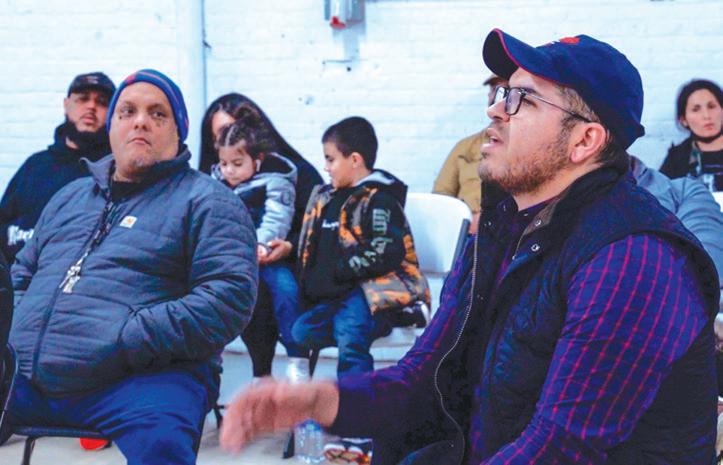
A las 6 de la tarde el salón estaba lleno; asistieron cerca de 50 personas. Los murmullos hacían eco, de vez en cuando interrumpidos por el sonido de vecinos emocionados por reconocerse otra vez. En el lado izquierdo de la sala tres policías estaban sentados con los brazos cruzados, hablaban entre ellos.
La reunión se inició con actualizaciones: eventos del distrito, nuevos contenedores de basura, más policías asignados en la comunidad. Sigcho-López escuchó atentamente desde la parte de atrás. Un psicólogo del Hospital Mount Sinaí habló de los servicios de salud mental para niños que sufren traumas, seguido de un representante de Big Brothers
Big Sisters que compartió información sobre programas de tutoría para jóvenes. El público hizo pocas preguntas.
Luego llegó el momento de escuchar las actualizaciones de la policía local. Las manos se alzaron casi inmediatamente.
“¿Qué tan exitosos son en la disuasión y la solución de los crímenes?” una persona preguntó.
El agente de policía James Olszanski del distrito 12 eludió la pregunta y señaló a problemas de personal; sólo unos días antes, el Chicago Tribune informó que el número de agentes de policía que se retiraron en 2021 se duplicó desde hace tres años a causa de la baja moral. Pero, de acuerdo con la oficina del distrito 25, más policías fueron asignados a Pilsen en febrero en respuesta a un aumento de violencia.
Olszanski también culpó al fi scal del estado del condado de Cook, Kim Foxx, quien hizo campaña con la promesa de procesar menos casos de delitos de bajo nivel. Los agentes, sin embargo, no pudieron dar una estimación sobre la cantidad de casos que resuelven. El año pasado, la tasa de resolución en toda la ciudad cayó al 24 por ciento.
“¿Cuál es el procedimiento si el Departamento de Policía de Chicago (CPD) no aparece después de llamar al 911?”, preguntó otra persona. En un grupo de Facebook, los residentes se quejaron de los largos tiempos de espera. Una persona dijo que el medio tiempo de espera para que la policía respondiera fue media hora. Alguien más dijo que esperaron cuatro horas.
“De nuevo, simplemente no hay suficientes
agentes de policía,” respondió Olszanski. El policía Osvaldo Caraballo agregó que los carros de policía sin marcas a veces responden a los incidentes, pero que es posible que los residentes no se den cuenta.
Un hombre preguntó por qué la relación entre la policía y la comunidad ha empeorado en los últimos años. “Yo recuerdo siendo un joven en La Villita y conociendo a todos los policías por su nombre”, dijo el hombre. “Ahora los jóvenes nos dicen que están asustados de la policía”.
Los policías insistieron que los problemas estaban relacionados con la dotación de personal— escasez de policía en la comunidad significan que los residentes sólo interactúan con la policía durante incidentes estresantes.
Entonces, la reunión dio un giro.
“Con el debido respeto al concejal, a mi no me parece que haya ningún esfuerzo para incluir a la policía en estas reuniones”, dijo Miguel Chacon, un corredor de propiedades local. “La comunidad ha dicho que queremos que la policía se involucre en nuestra comunidad.”
Durante una reunión de la comunidad en diciembre, los residentes expresaron su preocupación de que los policías no fueron invitados a las reuniones de la comunidad, pero Sigcho-López, que en ese momento caminó hacia el frente de la sala, dijo que sí fueron invitados. Los policías aclararon que el concejal sí los había invitado a las reuniones anteriores, pero que, por razones relacionadas con la dotación de personal, no podían atender.
“Siento que hay que nombrar el elefante en
la sala”, o el asunto obvio que la gente evita reconocer, dijo Aida Flores, ex candidata a concejal del distrito 25. Estaba sentada en la segunda fi la con páginas de notas en la mano.
El elefante siendo que Sigcho-López es un crítico de la policía y habla regularmente sobre la reasignación del presupuesto de casi dos millones del departamento de policía para fi nanciar más recursos de la comunidad, lo que lo pone en desacuerdo con residentes, como Chacon, que quieren ver soluciones más inmediatas al crimen en el barrio en forma de aumento de la presencia policial.
Detrás de Chacon estaban dos hombres de 30 o 40 años que vestían ropa oscura y no se identificaron. Uno de ellos le preguntó a Sigcho-López por qué se mostraba reacio a trabajar con la policía para llegar a soluciones sobre el crimen en el vecindario.
“De eso se trata esta reunión,” respondió Sigcho-López. “Estamos tratando de formar estas relaciones aquí.”
Preguntas seguían llegando, pero había pocas respuestas. La reunión duró más de una hora. “Debemos terminar pronto”, sugirió Olszanski, justo antes de ser interrumpido por una mujer sentada en la tercera fi la.
“Esto sucede cada vez!” Tanya Lozano gritó. Llevaba un abrigo blanco y verde que daba juego con sus Jordans. También llevaba pendientes como paradas de señal de stop que decían “Stop killing Black people”.
Lozano es la hija de Emma Lozano, una activista de la comunidad y pastora de la Iglesia Unida Metodista Lincoln, y sobrina de Rudy Lozano, un organizador y ex candidato de concejal para el distrito 25 que fue asesinado en su cocina en 1983 por razones aún desconocidas. Ella lanzó Healthy Hood Chicago, un estudio de danza y fitness en Pilsen.
“La policía siempre ocupa 45 minutos de la reunión, mientras el resto de nosotros nos dan los minutos fi nales”, ella dijo con ferocidad mientras se levantaba de su asiento y se dirigía a la parte delantera. Tres jóvenes la acompañaron. Los policías volvieron a sus asientos.
“Ya que escucharon de la policía y por qué no son es solución, hablemos de cómo la comunidad se debe unir”, dijo Lozano. Hubo murmullos entre las personas mayores en la audiencia. Chacon y los dos hombres detrás
16 CHICAGO READER - APRIL 28, 2022 ll
C orredor de propiedades local M iguel Chacon (derecha) habla a reunión 25TH WARD
NEWS & POLITICS
de él comenzaron a reírse.



“Siguen torciendo sus ojos”, dijo Lozano, mirando en la dirección de los dos hombres. Luego, los acusó de ser policías en turno libre que ella reconoció de reuniones anteriores.
“¡No es asunto tuyo!” Chacon gritó. Un miembro de la oficina del distrito le recordó a Chacon que tenía que respetar a Lozano, como lo había hecho a los demás.
Lozano habló sobre las oportunidades para que los residentes se involucren en la comunidad, incluyendo marchas por la paz. Junto a ella estaba el fotógrafo William Guerrero, también conocido como “el chico de Pilsen”, quien insistió que los jóvenes necesitan participar más.
Otros dos hombres hablaron, incluyendo un pastor que habló sobre la importancia de que haiga diálogo entre las diferentes iglesias dentro de la comunidad, y otro hombre que habló sobre mantener la paz entre las pandillas. Después de otros 15 minutos, la reunión terminó, casi una hora después de cuando debió haber terminado.
Después de la reunión, Lozano dijo que los dos hombres, de los que sospecha de ser
policías fuera de servicio, se acercaron a ella fuera del edificio de una manera intimidante. Días después de que esta historia fue publicada por web, en un correo electrónico al Reader, Chacon cuestionó las acusaciones de Lozano, y dijo que ella se acercó a él y al otro hombre después de la reunión, no al revés.
“Les dije que era una falta de respeto interrumpirme, una mujer que está en la comunidad haciendo el trabajo, mientras que estoy presentando,” le dijo al Reader. “Y entonces uno de ellos dijo: “¿Y eso que tiene que ver?’”


Después de la conversación, Lozano dijó que los hombres subieron a una camioneta con otros dos hombres y se fueron.
“Creo que como miembro de la comunidad y activista, que [la reunión] fue planeada estratégicamente por la policía”, dijó Lozano.
Michelle Gaona, una residente de Pilsen y policía del sexto distrito, también habló con el Reader después que se publicó la historia en línea. Gaona dijo que no había leído la historia pero que había visto un intercambio de correos electrónicos entre Chacon, a quien “conoce personalmente”, y el
Reader

Gaona confirmó que ella asistió a la reunión y agregó que ha ido a “todas las reuniones” desde que empezaron. Ella dijo que no se identificó como policía fuera de servicio porque no estaba representando al departamento.
Las reglas departamentales requieren que cada miembro “ya sea en servicio o no, se identifique correctamente dando su nombre, nivel y número de estrella cuando otros miembros del departamento o un ciudadano” lo solicite. Un representante de CPD confi rmó que la regla pertenece a cada oficial que esté en servicio o libre de turno.




El cuatro de marzo, el concejal SigchoLopez presentó una queja a La Oficina Civil de Responsabilidad Policia (COPA por sus siglas en inglés) sobre los policías fuera de servicio que no se identificaron en las reuniones anteriores. COPA remitió la queja al departamento de asuntos internos de CPD.
Gaona dijo que ella sabe que tiene el “deber de identificarse” como policía, pero que se siente insegura hacerlo en “una habitación llena de gente anti-policía”.
Ella dijo que los policías fuera de servicio que han asistido a las reuniones son parte de la comunidad. Agregó que también su ex cuñado, Raúl Antar Mosqueda, un paramédico del Departamento de Bomberos de Chicago y ex oficial de CPD, también fue a la reunión. Ella dijo que le preguntó a los oficiales de los distritos 10 y 12 de CPD si fueron invitados a la reunión y dijeron que no.
Gaona dijo que envió sus notas personales de la reunión por correo electrónico a los policías de CAPS en los distritos 10 y 12.
Como dueña de propiedad en Pilsen, dijo que está “dividida por la gentrificación” y que “estamos viendo el tipo de crimen de los 1990s”. Dijo que quiere que las reuniones sean “eficaces” y que los policías sean más activos en la comunidad.
Gaona agregó que no todo lo que dice la activista Lozano es exacto. “Nadie está tratando de agredirla o atacarla”, dijo Gaona.
La próxima reunión será el 28 de abril a las 6 de la tarde en la Iglesia Unida Metodista Lincoln, 2242 sur de la avenida Damen. v

APRIL 28, 2022 - CHICAGO READER 17
NEWS & POLITICS
CITY COLLEGES OF CHICAGO ccc.edu/ItsYourFuture Apply Now CCC has no-cost IT college-credit programs online and in your community to help you find in-demand jobs. Get connected to our network. Dream Big, Go Local
@Kelly__Garcia
Here’s what Black voters should pay attention to in the midterms
In the past, politicians have co-opted progressive language from organizers in the Black liberation movement for their campaigns, hoping to win the Black vote.
By TONIA HILL AND THE TRIIBE
This article was originally published on The TRiiBE, a digital media platform that is reshaping the narrative of Black Chicago.
For a moment in the summer of 2020, it felt like the U.S. was on the brink of a revolution. Mass unemployment, coupled with the global coronavirus pandemic and the fatal police shootings of Breonna Taylor and George Floyd, had the streets hot nationwide.
Politicians co-opted progressive language from organizers in the Black liberation move-
ment for their campaigns, hoping to win over Black and Brown voters—and did. The issues they championed to get those votes are now an afterthought.
Now nearly two years removed from that moment, President Joe Biden put the notion of a revolution to rest with his fi rst State of the Union Address on March 1. Student loan debt forgiveness was noticeably absent from his address despite Biden campaigning to forgive $10,000 for all borrowers.
Biden also emboldened law-and-order politicians with his speech. “We should all agree
the answer is not to defund the police,” he said. “It’s to fund the police. Fund them. Fund them. Fund them with the resources and training—resources and training they need to protect our communities.”
Cities across the country pulled an aboutface on their stances to defund the police in 2021. In fact, leaders in Chicago, New York, and Los Angeles have upped the funding for police departments.
March 7 marked the start of the 2022 midterm election season in Illinois. It was the fi rst day for political candidates to fi le their
petitions to run in the 2022 Illinois primary on June 28. In Chicago, the fi rst day to apply to vote by mail for the June primary was March 30. The 2022 midterm election will take place on November 8.
As political advertisements ramp up between now and November, it’s important to keep an eye on the talking points of each candidate, their campaign promises, and how their campaign promises align with their speeches and actions. Historically, midterm elections have had low voter turnout, but in 2018, voter turnout was 60 percent in Cook

18 CHICAGO READER - APRIL 28, 2022 ll
Residents cast their votes at the United Center during the 2020 general election.
KAYODIDTHAT FOR THE TRIIBE
ELECTIONS
NEWS & POLITICS
County, an increase from 49 percent in 2014, and statewide turnout was a little over 57 percent, up from 49 percent in 2014.
According to Westside Justice Center executive director Tanya Woods, the midterms have consequences, and the ripple e ects of every midterm election are felt on every level of government across the U.S.
“We have got to stop looking at midterm and presidential races as independent, siloed election cycles. One season feeds the other. Judicial races inform state legislative races, congressional races inform gubernatorial races,” Woods wrote in an email to The TRiiBE.
The 2022 midterm election ballots will include state constitutional o ces, including governor, lieutenant governor, secretary of state, comptroller, treasurer, all Illinois General Assembly seats (state senators and state representatives), U.S. representatives in Congress and the U.S. Senate, and all judges statewide. These same seats will also be open in other states’ midterm elections this November.
In Cook County, there will be elections for the president of the board of commissioners, county clerk, treasurer, sheriff, assessor, all county commissioners, all county board of review members, water reclamation district commissioners, and township committeepersons.
“What goes down in Georgia will directly impact what happens in Illinois. Who gets elected in Virginia will impact what happens in California. They all work together,” Woods continued.
With so much at stake, what are some of the issues Black voters should pay close attention to during the 2022 midterm elections?
The TRiiBE reached out to Chicago residents on this topic. Each person pointed to crime, employment, education, infrastructure, investment in Black communities, and affordable housing as areas that should be considered this election cycle.
Below, we take a deeper look at each of those issues.
CRIME
Since the start of the 2020 summer uprisings, there’s been a strong political focus on crime. According to a 2021 report from the FBI, the estimated number of violent crimes increased. In 2020, violent crime was up 5.6 percent from 2019. In Chicago alone, there were more than 1,000 homicides in 2021, according to the
Chicago Police Department (CPD). That’s the highest number of homicides on record for the city since 1994.
Mayor Lori Lightfoot and CPD Superintendent David Brown believe that people charged with violent crimes should not be released on electronic monitoring. They’ve placed blame for ongoing violent crimes in Chicago on Cook County state’s attorney Kim Foxx and her support of bail reform.
“There’s a relationship between the outbursts [referring to crime] and the increase in crime and poverty. I think the two of them go together and that would include, of course, poor housing, horrible education in the public schools in the city of Chicago, and across Illinois,” said Robert Starks, professor emeritus of political science and the director of the Harold Washington Institute for Research and Policy Studies at Northeastern Illinois University’s Center for Inner City Studies.
As evidenced by Biden’s State of the Union speech, many politicians and Americans alike see police as the answer to the increase in crime. The tide is shifting from the 2020 #DefundThePolice campaign to pouring more dollars into police departments. In Chicago last year, Lightfoot increased the police budget to $1.9 billion, up from $1.7 billion in 2021 despite calls from organizers and activists to defund the police.
However, activists and organizers within the ongoing Black liberation movement are still advocating for disinvestment in policing, and instead investing those dollars in uplifting communities hardest hit by violence and poverty. Many cite that police don’t prevent or solve crimes. During an end-of-year CPD press conference, Superintendent Brown said the homicide clearance rate was around 50 percent in 2021.
“How do we effectively address rising crime without necessarily hiring more police,” asked Lionel Kimble, an associate professor of history at Chicago State University. “We all know that hiring more police won’t necessarily help solve the problem. [The solution is] providing resources for our young people so they get an alternative to do things that are more positive and productive to do to make them feel like they’re valuable members of society.”
For example, GoodKids MadCity (GKMC) has been organizing support for its Peacebook Ordinance for the past two years. The ordinance would allocate 2 percent of CPD’s police budget to community-run services such as violence interruption, education,
mental health programs, and more.
The ordinance still hasn’t been introduced to the Chicago city council. In a separate story about a police shooting in Hyde Park published by The TRiiBE on January 20, GKMC member Miracle Boyd told the TRiiBE that the ordinance has the support of Alderpersons Pat Dowell (3rd), Sophia King (4th), Leslie Hairston (5th), Roderick Sawyer (6th), Jeanette Taylor (20th), Byron Sigcho-Lopez (25th), Rossana Rodriguez Sanchez (33rd), and Andre Vasquez Jr. (40th).
EMPLOYMENT
The COVID-19 pandemic hit Black Chicago hard. After the first month of the pandemic, Black Chicagoans accounted for 72 percent of the city’s death toll despite making up only 30 percent of the city’s population. Additionally, the unemployment rate among Black Illinoisians has risen since the start of the pandemic. In 2018, the unemployment rate for Black people statewide was 9.1 percent; by January 2021, it was 11.3 percent.
“In our communities, there’s always been this need for high-paying, entry-level jobs with a livable wage. That’s always been the big thing with Chicago, this is a very expensive city,” Kimble said. He added that gentrification is pushing Black people out of the city, but said access to jobs with livable wages is one solution to improve economic conditions made possible through infrastructure projects.
Alongside other states in the nation, Illinois got a big boost from the federal government in 2021 to fund infrastructure projects, such as repairing and rebuilding roads and bridges, improving public transportation, broadband Internet access, and more. In November 2021, Congress passed the $1.2 trillion Bipartisan Infrastructure Deal. Illinois will receive nearly $18 billion from the federal government.
This year, Illinois will begin receiving $1.4 billion over five years to repair bridges in poor condition made possible through the Bipartisan Infrastructure Deal. The federal investment adds to Governor J.B. Pritzker’s major infrastructure bill that he signed into law in August 2021. The Rebuild Illinois capital plan will invest $45 billion in the state’s roads, bridges, and railways, along with other critical projects over the next six years.
“Those infrastructure projects have to and must include African American workers. We can no longer have cases where infrastruc-
ture [and] construction jobs are open to every ethnic group, but African Americans,” Starks said. “When you go throughout Chicago, in an African American neighborhood, the people that are working on those sites are non-African Americans.”
Some communities across the city lack access to reliable Internet, yet another area of inequity that the COVID-19 pandemic brought to light. A 2020 report by Kids First Chicago and the Metropolitan Planning Council found that “one in five children under the age of 18 lack access to broadband and are primarily Black or Latinx.”
In June 2020, Lightfoot introduced Chicago Connected, which o ered free broadband to 100,000 homes of Chicago Public School students.
EDUCATION
The COVID-19 pandemic, coupled with the 2020 summer uprisings, exposed inequities within public education in Chicago and across the U.S. Not only did some students lack access to the Internet day-to-day, but there was also concern about the presence of police and health safety in schools.
Catlyn Savado is a 14-year-old freshman at Percy L. Julian High School on the far south side. Although she isn’t old enough to vote, she’s been very vocal in expressing concerns around Chicago Public Schools (CPS) officials’ handling of the pandemic and police in schools.
Savado is immunocompromised and is worried about the direction the school district, city, and state are taking as they relax COVID-19 mitigations. She said she doesn’t expect the district to keep students safe. She believes that her individual school community will ensure that everyone remains safe.
“Honestly, I don’t wanna see anything from the district as I don’t expect institutions and systems to take care of us, or keep us safe. I believe community keeps us safe and cared for,” she wrote in a text message to The TRiiBE.
On March 14, CPS schools shifted to mask-optional for schools and staff. This news came just a week after Lightfoot lifted the city’s mask and vaccination mandates on February 28.
Back in January, there was a conflict between the Chicago Teachers Union (CTU) and CPS leadership over students and sta members returning to in-person learning after winter break as COVID-19 cases were spiking
APRIL 28, 2022 - CHICAGO READER 19
NEWS & POLITICS
The souls of black people
Here I am, Dreams blossomed
With the help of a green thumb
Everything I touched turned to gold, But it couldn’t soften hearts in stone Locusts swarmed, on the land I was born The universe took me on tour, After a cloud started pouring I wiped blood across my door, To survive life on shore Secure the smile of my first born I stared out my peephole, At the souls of black people Doing the same, securing their names I caught a glimpse, I wrote a poem below my lips
A gift and a curse, These words I carried like candy In a mother’s purse I stared out my peephole, I admired the souls of black people
Messejah
By Messejah Washington
NEWS & POLITICS

continued from 19
due to the Omicron variant.
On January 4, 73 percent of the CTU’s 25,000-plus membership voted to temporarily switch from in-person to remote learning, resulting in the cancellation of in-person learning for four days. Finally, both sides came to an agreement on January 12 and adopted a health and safety agreement.
One part of the agreement was to keep mask-wearing in place for the remainder of the school year. CTU said CPS’s move to mask-optional goes against that agreement. The union filed an unfair labor practice charge against the city on March 8. Last week, the Illinois Educational Labor Relations Board rejected CTU’s move to temporarily block the district’s optional mask mandate.
Savado led the CPS student walkout in January where students demanded better options for learning during the COVID-19 pandemic amid the confl ict between CTU and CPS.
safety was like in the building, whether that’s COVID-19 safety, or whether that’s physical safety, you need to talk about police and policing and how we undo those structures, or we talk about what are alternatives to those,” Savado said.
Savado said that she’s been thinking of other alternatives to SROs, such as having mental health care practitioners available in schools.
“Many predominantly Black CPS schools still have police at our schools. But we don’t have nurses and social workers that CTU has been fi ghting [for],” she added.
AFFORDABLE HOUSING
memories through painting poetic, photographic, reinterpretations of children in Bronzeville inspired by his family photo archive.
Washington has shown work throughout the Chicagoland area and is preparing for an upcoming solo exhibition this summer at Elephant Gallery.
Poem curated by Jada-Amina. Jada-Amina is a South Side Chicago born and based, Black Indigenous American singer, writer, and cultural worker.
A biweekly series curated by the Chicago Reader and sponsored by the Poetry Foundation.
Free Spring Programming from the Poetry Foundation!





Hours
Wednesday and Friday: 11:00 AM– 4:00 PM Thursday: 11:00 AM–8:00 PM
The Zafa Collective: I Did, Did I? (In Person)
A live performance of a libretto by Liza Sobel and Gina Elia Thursday, May 5, 2022, 7:00 PM
Poetry & Theatre: A Day with Aimé Césaire (In-Person)
A robust discussion on Césaire’s play, The Tragedy of King Christophe Saturday, May 7, 2022, 2:00 PM
Monica Ong: Planetaria
An exhibition of visual poems that leverage the visual language of astronomy
Learn more at PoetryFoundation.org
“As a student, the way that I learned and the way that I sit in classrooms now is definitely di erent than the way that I did before the pandemic,” said Savado, who was in sixth grade when the pandemic began in 2020.
“I’m still stuck in, like, my sixth-grade self. I haven’t learned anything since, like, sixth grade [to be] completely honest,” she said. “So with the learning structures, are we accommodating the needs of young people? Are we treating people like humans, specifically Black young people?”
During the summer 2020 uprisings, Savado participated in the #CopsOutCPS campaign, where youth organizers in CPS demanded that CPD o cers—who served as School Resource O cers (SROs)—be removed from school campuses.
Northside College Prep in North Park was the first Local School Council (LSC) in the district to vote to remove SROs from its school on July 7, 2020. In the end, more than 70 high-school LSCs voted, but only 17 LSCs approved ousting their SROs, according to Chalkbeat Chicago.
Percy L. Julian High School’s LSC voted to keep SROs on its campus in 2020, according to CPS data. However, the LSC at Julian did not have the minimum number of LSC members to conduct the vote. The district required schools without a quorum to poll the local school community to weigh in on the decision too.
“When we talk about safety and what the
Another important issue for Black voters to pay attention to is affordable housing. The COVID-19 pandemic knocked the housing market into shambles. A 2020 report from Housing Action Illinois found that minimum wage workers can’t a ord to rent a home at a fair market rate without spending more than 30 percent of their income doing so.
A household would need to earn more than $44,000 annually to a ord the average fair market rent for a two-bedroom apartment in 2020, which was $1,108 in Illinois. As of December 2021, the average rent for a one-bedroom in Chicago was $2,180, a 3.3 percent increase from 2020. The price for a two-bedroom Chicago apartment was $3,242, a 7.3 percent increase from 2020, according to data from Rent.com.
“Because of the pandemic, the market is infl ated. There is not a shortage of units for people to live in. How they are priced and who gets them is the problem. Housing is of particular concern for the housing insecure and people returning home from incarceration,” Woods wrote in an email to The TRiiBE.
Access to a ordable housing has long been an issue for Black and Brown residents in Chicago, and the pandemic magnified it. In early 2020 Pritzker ordered a moratorium on evictions due to the COVID-19 pandemic. He lifted the moratorium in October 2021.
“So many of our neighbors on the south and west sides are undergoing gentrification block by block, and we’re being—by and large—priced out of the city,” Kimble said. “I think that jobs and housing costs go hand in hand. Without adequate jobs, we can’t a ord to pay the rent. We can’t buy homes. We can’t create generational wealth.” v
20 CHICAGO READER - APRIL 28, 2022 ll
@_ToniaHill
Washington is a multidisciplinary artist born on the South Side of Chicago. At an early age he was exposed to the arts by his father, visual artist Dale Washington. Washington’s work is centered around his ancestral journey from the American South and life in Chicago. He works with the intent to archive personal
Through 5/27: Sat-Sun, noon- 4 PM; free reception and artist talk Sat 5/7, 1 PM. Blanc Gallery, 4445 S. King Dr., 773 373 4320, blancchicago.com.
ARTS & CULTURE
influenced your art and the person you’ve become, and what are some of the ways they are depicted in your show?
There are many. Public school, where I developed my personality. My grandmother’s passing, when I was a teenager. Hip-hop and breakdancing were a huge influence. Traveling to Japan was a huge influence for my spirituality and belief system, my philosophy for how I anchor myself in the world. This show is a lot about family and how I grew up so it is personal and has a lot of things or images from home. My experience in Japan influenced how I spaced out and visualized the show as well as my sense of craft, building my own canvases and things like that.
When and why did you become interested in art? In a video produced by Rebuild Foundation where you talk about your 28 Days of Greatness project, I heard you say you only had one Black art teacher, Ms. Jackson. How did this teacher impact you?
ART
The big world of Brandon Breaux
With the exhibition “BIG WORDS,” the enterprising multimedia artist shows what he’s made of.
 BY ISA GIALLORENZO
BY ISA GIALLORENZO
Yes, Chance the Rapper did give a big push to artist Brandon Breaux’s career when Breaux designed the covers for three of the singer’s mixtapes: 10 Day , Acid Rap, and Coloring Book. Breaux also recently landed two high-profile commissions—the February 2022 Ebony cover honoring editor André Leon Talley, and the cover of Carry On: Reflections for a New Generation , a book by the late Congressman John Lewis.
But in his paintings, the Chicago-based Breaux also pays homage to the nonfamous people who made an impact in his life, with a touching sense of gratitude. Those portraits and much more can be seen at “BIG WORDS,” his first solo exhibition, on view at Blanc Art Gallery in Bronzeville through May 27. The show was curated by Anna Cerniglia of Johalla Projects and Alison Cuddy, formerly of WBEZ and the Chicago Humanities Festival. Editor’s note: Cuddy and Blanc co-owner Eileen Rhodes
both currently serve on the board of the Reader Institute for Community Journalism.
Breaux’s ever-expanding universe includes fashion, graphic design, mental health advocacy, kids’ TV shows, video game design . . . you name it. What permeates his work is a sense of beauty, kindness, and intelligent simplicity. With “BIG WORDS,” Breaux brings language to the foreground among other themes— language as a means of connection but also separation.
The Reader interviewed Breaux via email shortly before “BIG WORDS” opened. In his responses to our questions, as in his art, Breaux found a way of bringing language and connection to the forefront—making sure he was truly getting the message across.
Isa Giallorenzo: Could you tell me a bit about your history growing up? Were you born and raised here in Chicago? What was
growing up here like for you?
Brandon Breaux: South side! Chatham and Grand Crossing. Growing up was interesting. It was isolated because of segregation and gang boundaries, so I needed permission from my mom or grandmother to go anywhere. But still it was fun, very creative, very midwestern, you know, kind of the small community [in a] big city. And very tight as far as everyone knowing everyone’s business!
In the press release for “BIG WORDS,” it says that “this multidisciplinary exhibition is a journey through some of the touchstones—people, places, and artifacts—that have shaped how Breaux has come to see the world, and is a meditation on the way identity evolves through an ongoing dialogue with public events and personal histories.” What occurrences in your life have
I’ve been doing art since before I can remember. My mom says I was around three, maybe five when I started doing portraits of her: her face, her teeth, the glasses around her face— which I didn’t know how to do so I drew them curved around the head—kind of flat and 3D at the same time!
Ms. Jackson was one of the coolest, most laid-back relationships I had with a teacher. I didn’t have an art teacher until seventh grade. We had an “art cart’’ but it wasn’t consistent. With Ms. Jackson, it was the first time we had an art room and work space to hang out. So I would go there and eat my lunch and finish up work, and just hang out. She was very kind, and called us all baby, like “Hey baby, how you doin’?” She was an artist and a sculptor and still is.
The invitation to your exhibition also says that in your work “the juxtaposition of painterly images with graphic lettering invites a connection—or confrontation—with the way language can be both a passageway or barrier between worlds.” Could you explain that a little more? Is that related to the “BIG WORDS” of the title? How do you think language can be better used as a
APRIL 28, 2022 - CHICAGO READER 21
Recent paintings from Brandon Breaux populate part of the exhibition at Blanc. COURTESY BRANDON BREAUX
WORDS”
“BIG
ARTS & CULTURE
means of connection as opposed to a means of conflict? What kinds of attitudes can foster better communication in your opinion?
“BIG WORDS” generally relates to dense or inaccessible language and how language can be used to express status, value, or money. Class is at the heart of it, in terms of which people can a ord the education to learn that vocabulary. In the show there are no big words in that sense. They are very common terms, SEEN or LORD. But they are physically big to address the elephant in the room—class or gatekeeping in the art world—and to pose the question “How am I expected to talk about my art?”
Language can divide or connect equally well. Connecting is about really listening to people while also questioning how you personally receive the world. It happens through empathy and truly being curious.
Do you have any direct influences on your paintings? Your work is evocative of Kerry James Marshall and Kehinde Wiley. What are some similarities and differences you see between your work and theirs?
I think all art is about being influenced in some way by the things around us and what we gravitate toward. At the same time I have been doing portraiture since I was a kid so it comes from my personal influences. With Kerry James Marshall, there is a similarity in the focus on the Black figure and the exaggeration of color and tone, although I didn’t get why that was important at first, until I heard him talk about it. His consistent investigation of the color black and the endless variety within that caused me to look deeper at people and the things and colors I do see and why I see them that way.
The plants are inspired by George Washington Carver’s work and ideas about permaculture—I took a class in that and became interested in plants as intelligent life forms. So I kind of wanted to make them the costars of my artwork or center them at times. Respecting all life forms is important and for me painting is a way to show respect and gratitude.
How do you choose the subjects in your portraits?
Lately I have been trying to be better about pouring into the people who pour into me and reciprocating the generosity they give me. The 28 Days of Greatness portraits were like gifts
to people who inspire me. Often portraits are about celebrities or exalted figures and these are not about that, they are about ordinary people who are special to me and are about showing what love or gratitude looks like.
What are some materials and techniques you like to use?
Oil painting for sure and garments as a medium of expression. I am interested in repurposing objects to make new uses out of old things, and creatively reapplying old materials.
What was it like working with Chance the Rapper?
It was pretty life-changing because of the impact it had. To collaborate with someone as committed as he is was amazing. It brought me opportunities and trust in my ability, my eye, and my capacity to make e ective art over and over again. Through it I realized my work had value and could travel far, I just didn’t know how far.
What other highlights in your career are you particularly proud of? By the way, I’d like to congratulate you for the Ebony cover honoring André Leon Talley, and the book cover for Congressman John Lewis’s Carry On.
My collaboration with the MCA store. When I first started designing T-shirts one of my goals was to have them in museum gift shops, to have them seen in that way and context.
Also, the digital miniseries What’s Good , which I directed with a friend for PBS. That was great because PBS has done so much for kids. It impacted me as a child so it was great to do something for kids on that platform.
What are some other areas besides visual arts you’ve branched into? I see you promote a shop called “The Invisible Space.” Do you own it? What’s the idea behind it? Do you design some of the featured products? I particularly love the sold-out Breaking Bread necklace (a collaboration with the artist Secret of Manna). Do you plan on restocking it? Asking for a friend . . .
Yes there are some of those necklaces at “BIG WORDS!” I own the brand Invisible Space and the concept is to acknowledge some of the places people don’t recognize enough. I wanted to shine a light on them and the peo-

ple that make them, especially on the south side. It is also a way of talking about spiritual things, like yoga and meditation. I have always been really interested in multimedia, but since visual art and graphic design are the mediums I have stuck with the most, that’s what people know me for. But I am also into sound, video games, and fashion—lots of things.
I’d love to know more about your meditation workshops and lectures. Why did you decide to go into this line of work? How does it relate to your visual art?
Meditation became a focus during COVID because it offered a good space for people to find a way to calm down. There weren’t a lot of resources for that. Prayer is more of a solo experience so I wanted to do something where people could be with their breath and each other, because not having that space and connection impacts our mental health. It was needed and I wanted to take some responsibility for making it happen. Lectures: important that people heard me speak about the work because speaking is a great and immediate way to communicate your passion and ideas. That realization and knowing how important storytelling is to my practice, since I think of myself as a visual storyteller in a way.
You recently hosted a men’s mental health and conversation workshop promoted by Babes Only at Lululemon. What do you think is specifically important for men to know about mental health? Additionally, I noticed you commented on the Will Smith Oscar incident on your Twitter account— what’s your take on what happened? What counsel would you give to both Will Smith and Chris Rock, from a mental health perspective?
It is OK to not be perfect and not carry all the groceries yourself, so to speak. Sometimes the world thinks that’s what it is to be a man, to take on the weight of the world, to take it on the chin.
What we saw at the Oscars had that going on. It didn’t feel as if it was about that single moment, but had been building up and hit a breaking point. They both have an impossible task sometimes, to appear perfect while being so surveilled. There is healing for both of them to do.
Could you tell me a bit about your “Seeing Futures” project at the MCA? What
was that experience like for you and the participants?
For me it was very fulfilling to really have that conversation, to lead that meditation and to incorporate it as art. It was the first time I incorporated one of my wellness practices or anything in my life as a performance. So it was great. We didn’t have permission to do it, we just did it. And then the MCA posted it. I thought it was a good time for people to come out and meditate on how things could be more inclusive. There was lots of focus on what was wrong and what we don’t want to see. Sometimes the work of ideating and talking about what we do want to see doesn’t get done.
I see you have an artist residency coming up at the Kennedy Center in D.C.—what do you plan on showcasing there?
[The residency program] is called O ce Hours and you have six days to do what you like, just show up and do your thing. Don’t know yet what I am going to do but I’m looking forward to it!
What do you envision for your career and life in the future? And where can we find out about it?
Making more art, creating more experiences, and telling more stories. I have a new site coming this summer but for now go to brandonbreaux.com. v
22 CHICAGO READER - APRIL 28, 2022 ll
@chicagolooks
continued from 21
Brandon Breaux NOLIS ANDERSON
ARTS & CULTURE
COMICS
Julie Doucet is back
 By MEGAN KIRBY
By MEGAN KIRBY
In 2018, the Reader ran a cover story: “Julie Doucet is done making comics.” The underground artist famously abandoned the scene in 2006, leaving fans of her cult-classic series Dirty Plotte and graphic novels like My New York Diary bereft. Through the years, her autobiographical comics became renowned in the canon. She explored other art forms like poetry and collage. But fans didn’t dare to hope for her comics return.
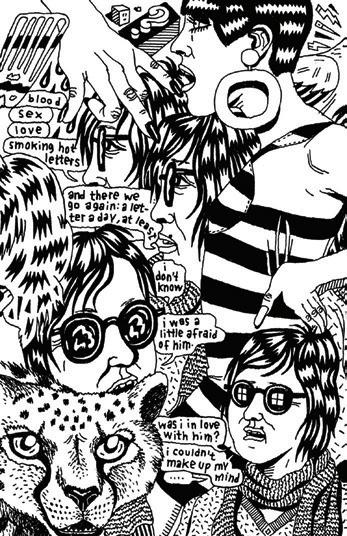
Which makes her 2022 graphic novel release even sweeter. After our long wait, Julie Doucet is back! On April 19, publisher Drawn & Quarterly released Time Zone J. Through densely illustrated pages and a stream-of-conscious monologue, 52-year-old Julie dredges through the chaos of her memories—focusing specifically on a frighteningly intense love a air from her early twenties. The book feels like sifting through the junk drawer of Doucet’s mind: the random phrases, patterns, dreams, and faces she’s squirreled away over the years, ready to be examined in stark black-and-white.
The book does not crumble under the pressures of a 16-year-long break. Time Zone J is a triumph of nostalgia and memory. It’s the ideal follow-up to a long hiatus: a new work that builds on her past, while simultaneously elevating her entire (already very impressive) oeuvre.

The first page begins with a remembered promise: “I had vowed to never ever draw myself again.” She immediately, spectacularly, breaks this vow. Every page compulsively fea-
tures her face drawn as she appears today—in her fifties, with thick-framed glasses and sideswept hair. From this vantage point of middle age, she dissects the complicated memories of her twenties.
Narrator Julie recently reread her diaries. She’s been dreaming of old friends. The fullbleed pages crowd with black-and-white illustrations, every inch packed with chaos. It feels like she sawed the top o of her skull and dumped the contents across the page. The French fold binding allows the illustrations to flow from one page to the next. If you could lay them out side by side, they would form one continuous image. This feat imbues every spread with wild momentum, but the drawings don’t necessarily tie to Julie’s written narrative. There are no sequential comics frames, no recurring characters besides Julie herself. Instead, the drawings feel like organic additions to her written word, figurative connections rather than literal representations.
From her tangle of memories, a central plot emerges. The postal service played a huge part in the 90s underground comics world. During the Dirty Plotte heyday, Julie becomes pen pals with a young French soldier called the Hussar, and their overseas correspondence quickly turns romantic. When Julie visits Paris the two meet and fall into a months-long grappling between lust and violence, romance and obsession. She never draws a human version of the Hussar. Instead, he appears as a bird, word bubbles spilling from his beak as he flits
from page to page.
In one of the book’s most memorable scenes, Julie and the Hussar sneak into Père Lachaise Cemetery after hours and cut themselves with a razor blade. But Julie cuts too deeply into her arm by accident. Instead of drawing the actual scene, she draws a flurry of bugs, fish, crabs, and disconnected faces. The only visual tie to the narrative is a single razor blade, drawn to span the split between two pages.
At the apex of this anecdote, Julie interrupts herself. “While we were at it we made a blood pact, right in the AIDS epidemic,” she writes. “Super good idea!” This interjection gets to the heart of the book. Middle-aged Julie tries desperately to make sense of her past decisions, judging her younger self, jostled at all sides by the flurry of her past. Some of her recollections are muddy. Some are overtly omitted. (“It’s too intimate.”) The scattered drawings begin to feel like permission, one leading to the next as she feels her way along the story.
The book’s one misstep comes in its reading directives. Pages are meant to be read from top to bottom, but even in following these directions, the speech bubbles become convoluted. Maybe the disordered text was meant to enhance the confusion of the narrative, but in action, it feels annoying. You’re often scrambling to find your place on the page. It’s a real barrier to entry—one that is well worth surpassing, but could have been avoided in the first place.
Memories can grow claustrophobic. The more you delve into them, the more connected they become, until you’re surrounded by a mishmash of images and phrases, words sharply recalled and faces half-remembered. The disconnect between Doucet’s words and illustrations captures this feeling perfectly. As you read, your brain must process the words and images on separate levels. This results in a dreamy frame of mind, a willingness to follow Julie wherever her thoughts take her.
The book’s end pages show a stark line of dots in a row. They feel like ellipses bookending the story—and connecting Time Zone J to the rest of Doucet’s career. It’s an exciting promise: not just an opportunity to appreciate what came before, but to anticipate what she still has to tell us. v
APRIL 28, 2022 - CHICAGO READER 23
Time Zone J marks a welcome return by the beloved writer and illustrator.
The cover (le ) and a panel from Time Zone J COURTESY DRAWN & QUARTERLY
TIME ZONE J
$29 95, Drawn & Quarterly,
R
BY JULIE DOUCET
drawnandquarterly.com and independent booksellers
THE ODYSSEY PROJECT Free College Courses Art History, History, Literature, Writing, Critical Thinking, and Philosophy ILHUMANITIES.ORG/OP-CR APPLY NOW Application deadline: June 15, 2022 Odyssey Project Find hundreds of Reader-recommended restaurants at chicagoreader.com/food.
@megankirb
GODS AND PUPPETS
Ventriloquism and Oobleck
By KERRY REID
When I think of ventriloquism in film, my thoughts flash to the commercials for 1978’s Magic that creeped me out as a kid. I wasn’t alone; according to the IMDb trivia page, the original trailer for this psychological horror film was pulled from broadcast after parents complained. (“Fats,” the murderous dummy who seemingly possesses Anthony Hopkins’s ventriloquist/magician, is seen in close-up, intoning, “Abracadabra, I sit on his knee. Presto, change-o, and now he’s me! Hocus Pocus, we take her to bed. Magic is fun; we’re dead.”)
For celebrated filmmaker, restorationist, and film essayist Ross Lipman, ventriloquism is a source of fascination for many reasons. “I’ve long been haunted by some of the great ventriloquism films, and also by the mysteriousness of it,” he says. “There’s a lot going on at a psychological level—the relationship between the ventriloquist and what’s called the dummy, or the figure. I wanted to explore that.”
In his latest film, The Case of the Vanishing Gods , Lipman delves into that dynamic through a fictional/documentary hybrid. A ventriloquist’s figure (Lipman notes that that’s the preferred nomenclature, over “dummy”) named Hugo has lost his memory. Under hypnosis, his memories are recovered in the form of a history of ventriloquism, from “prophetic tradition to the modern horror film.” In addition to Magic , Lipman cites the 1945 British film Dead of Night, an anthology of stories that concludes with the tale of Michael Redgrave’s mentally imbalanced ventriloquist Maxwell Frere (whose figure is named Hugo), as one of the inspirations.
For this project, Lipman called on the talents of members of Chicago’s Theater Oobleck, with whom he’s been friends since their college days at the University of Michigan in the 1980s. (Lipman worked for a short time with Ann Arbor’s Streetlight Theater, Oobleck’s predecessor; he calls himself “Oobleck-
adjacent.”) David Isaacson plays the hypnotist Doctor Labyrinth, with Jeff Dorchen as the voice of Hugo. (Isaacson still lives in Chicago; Lipman, Dorchen, and Oobleck vet Lisa Black, who also has a small voice role in the film, are all based in LA.)
“I always like working with friends, and it’s very helpful when they’re coincidentally as talented as this group,” says Lipman with a laugh. “So one thing led to another. Once the roles became apparent, David is just such a great host and moderator that I quickly envisioned him in the role. The film’s in part a love letter to the classic 1950s horror comic books, with David as the demented host inviting you into his lair. And then—if you need somebody to play a psychotic ventriloquist’s dummy— well, Jeff Dorchen’s your man. I’m not sure what this says about either of them. I’ll leave that to their analysts.”
Isaacson too has used ventriloquism as a metaphor for mind control in his work for Oobleck. In 1991’s The Spy Threw His Voice: A Plagiarism in Two Acts, a CIA agent/ventriloquist, Secret Agent Man (Dorchen), narrated the show while also messing with texts by two survivors of the cold war: Czech dissident/ playwright/president Václav Havel’s black comedy The Memorandum and conservative pundit William F. Buckley Jr.’s spy thriller Stained Glass . (Isaacson wrote a sequel in 1996, The Spy Was in Stitches, also featuring Secret Agent Man.)
“At the center of the film to me is Ross’s restoration work and his interest in the history of film,” says Isaacson. (Lipman, who worked for many years at the UCLA Film & Television Archive, has won accolades for his restoration work on films by John Sayles, John Cassavetes, and Charles Burnett, as well as on Barbara Loden’s sole feature film, the indie classic Wanda.) “And in this case, the history of ventriloquism on television and on film.
“Ross is very successful as a film essayist. His masterwork is Notfilm , which is his film
essay about the Samuel Beckett film titled Film . [Lipman’s 2015 feature-length documentary/essay on Beckett’s 1965 experimental short, starring Buster Keaton, incorporated lost footage he discovered.] His more recent essay film is called Between Two Cinemas. So he’s a master of that form, and I think that for this he was interested in taking on the new challenge of: how do you take archival material from the film world, as he does in Notfilm and Between Two Cinemas , and how do you put that within a fictional framing device that
THE CASE OF THE VANISHING GODS
Sat 4/30, 1:15 PM, Music Box Theatre, 3733 N. Southport, 773 -871- 6604, musicboxtheatre.com, $13.
is analytical, funny, and true to the source material you’re working from?”
Isaacson describes Doctor Labyrinth as “the framing device for a deeper analysis of the meaning of ventriloquism and puppetry and the strange aspect of ‘Why would you put ventriloquism on film?’ The entire e ect that the ventriloquist is trying to achieve, the live performance is necessary for that e ect to happen. And yet there’s this entire history of very creepy films with ventriloquist dummies.”
The screening of The Case of the Vanishing Gods this Saturday afternoon at the Music Box provides even more opportunities for an Oo-

bleck reunion/celebration. A new short play by Oobleck member Mickle Maher, Break Room, will precede the screening (Maher also just released a new anthology of his work, 6 Plays, with Agate Publishing), and former Reader film critic Jonathan Rosenbaum, a longtime Oobleck fan (and someone whose connection to Lipman stretches back to the latter’s time as a film clerk at Facets in the 1980s) will moderate a post-screening Q and A.
Most poignantly, the film is dedicated to the memory of Danny Thompson, a founding member of Theater Oobleck who died in 2019. Thompson won acclaim with his series of shows featuring “Danny and His Things,” in which he performed his own ventriloquism of sorts by using common household objects as puppets to embody a series of characters, often as satirical stand-ins for politicians or other leaders. (Memorably, in the Clinton-era Newt on a Hot Tin Roof, former House speaker Newt Gingrich was represented by a handful of biscuit dough.)
The Case of the Vanishing Gods already premiered at the 2021 Locarno Film Festival in Switzerland, and at Los Angeles Filmforum a couple weeks ago. But bringing it to Chicago has special meaning for Lipman, and the dedication to Thompson feels entirely apropos.
“A lot of my associations with Oobleck are invested in this film,” says Lipman. “And Danny was such a dear and important part of that. We’d been friends for so many years, since my late teens. He had an encyclopedic knowledge of film and theater history, and he was just such a great source of information, contributing in so many ways before his passing. I would call him up and ask, ‘What do you know about this or that?’ and he’d say, ‘Oh, that.’ Then he’d give a long list of things that I should delve into that I didn’t even know about—film clips, arcana, techniques, you name it.”
Isaacson adds, “He was an influence on Ross and really on everybody who was part of our little artistic group that started together in college. Danny’s visual brilliance, his ability to tell a story through a very quick visual image is something that was really remarkable.” v
@kerryreid
24 CHICAGO READER - APRIL 28, 2022 ll THEATER
COURTESY CORPUS FLUXUS
Ross Lipman collaborates with Chicago theater friends in his latest fiction/ documentary hybrid.
R READER RECOMMENDED b ALL AGES F











APRIL 28, 2022 - CHICAGO READER 25 TICKETS START AT $ 15 –Chicago Tribune PERFORMING AT CHICAGO SHAKESPEARE THEATER NOW PLAYING “ The web of our life is of a mingled yarn, good and ill together ” written by WILLIAM SHAKESPEARE directed by SHANA COOPER TICKETS START AT $ 35 THROUGH MAY 13 Ray and Judy McCaskey LEAD PRODUCTION SPONSOR Carl and Marilynn oma Donna Van Eekeren e Harold and Mimi Steinberg Charitable Trust Peter and Alicia Pond Burton X. and Sheli Z. Rosenberg MAJOR SEASON SUPPORTERS Lindy and Mike Keiser e Jentes Family e Kenneth C. Gri n Charitable Fund Rita and John Canning
OPENING
R Birthday dreams
Carmela Full of Wishes is a vibrant family show.
The world premiere of Carmela Full of Wishes at the Chicago Children’s Theatre offers young audiences a vibrant story of hope, family, and community.
Directed by Michelle Lopez-Rios and adapted by Alvaro Saar Rios from the children’s book by author Matt de la Peña and illustrator Christian Robinson, the play tells the story of Carmela (Maria Clara Ospina), an exuberant seven-year-old. On the morning of her birthday, she is thrilled to finally be old enough to join her reluctant big brother (Juan Gonzalez Machain) on his errands around town. On their way, she finds a lone dandelion growing on the pavement. As she follows her brother’s lead through their community, she considers the perfect wish she can make on it.
Sparks), is having an affair, and Henry feels supplanted by Jean’s fierce devotion to Robin.
At heart, Emma’s Child isn’t about the ethics of adoption (though those questions are implicit). It’s about opening up to love even when you can see mortality standing in the road ahead. Though City Lit’s production has some first-act hiccups, when it settles into the groove, it’s a bittersweet journey. —KERRY REID EMMA’S CHILD Through 5/29: Fri-Sat 7:30 PM, Sun 3 PM, also Mon 5/16 and 5/23, 7:30 PM; City Lit Theater, 1020 W. Bryn Mawr, 773-293-3682, citylit. org, $34 ($29 seniors, $12 students/military).
RGossamer wars
The Plagiarists deliver an epic poetic scifi allegory.
“Robot”: from robota, Czech for “forced labor,” coined in 1920 in Karel Čapek’s play Rossumovi Univerzální Roboti (Rossum’s Universal Robots), meaning not machines made of metal, gears, wheels, and bolts, but artificial life forms of manmade flesh and blood, indistinguishable from us though of alternative origin, usage, and intention. But the idea of inventions that assist and annihilate dates back millennia, mythically and metaphorically to Promethean fire—surely more ancient still our fear and fascination with what human hands can build or break.
POWERS
Carmela’s world is bright and optimistic, but her story is ultimately one of resilience. She and her migrant family are troubled by the absence of her beloved Papi, who she anticipates a call from on her birthday. Ospina thoughtfully leads the audience on Carmela’s journey to find the right wish and does a superb job balancing her joyful spirit and the vulnerabilities that her family’s situation has created for her. Lopez-Rios and the ensemble explore the scenario and the cultural context surrounding it in a digestible way but never underestimate its young audience’s intelligence and empathy. During the show’s final scene, audience members are invited to take part in a moving visual that serves as a catharsis and signal of hope for Carmela and her family. —KATIE
CARMELA FULL OF WISHES Through 5/22: Sat-Sun 10:30 AM and 12:30 PM; Sat 5/14 sensory-friendly performances (open captioning 12:30 PM); Sun 5/15, 10:30 AM ASL interpretation, 12:30 PM open captioning; Chicago Children’s Theatre, 100 S. Racine, 312-374-8835, chicagochildrenstheatre.org, $32. Recommended for all ages, especially 5-10.
R Special needs
Emma’s Child is about more than adoption.
Kristine Thatcher’s drama about a couple adopting (or not adopting, as it turns out) a child born with profound disabilities kickstarted Thatcher’s profile as a playwright in its 1996 Victory Gardens premiere. It’s back at City Lit, once again under Terry McCabe’s direction. And while some parts don’t hold up well, the production builds to a poignant conclusion, studded with hard relationship truths along the way.
Jean (Kat Evans) and Henry (James Sparling) are a couple edging into middle age, desperate to adopt. Well, Jean more than Henry, whose list of preferences (white, a girl, no disabilities) seems almost designed to stop the process cold. That happens anyway when single mom Emma (Katie MacLauchlan) delivers Robin, who is born with profound hydrocephalus and a very poor prognosis. Emma, a working-class woman with another young child at home, leaves Robin in the hospital with a DNR and the adoption is off the table.
But Jean in particular finds herself drawn more and more to the tiny boy, and with the help of acerbic but kind nurse Laurence (Lee Wichman), she takes on the role of mother-without-portfolio. Meantime, Henry and his best friend Sam (Jamie Black) spend a camping trip lamenting the ways their relationships with the women in their lives have shi ed. Sam’s wife, Franny (Rebecca
I Build Giants, written by Ryan Stevens, directed by Christina Casano, with movement and intimacy direction by Maureen Yasko, reimagines the problem with stunning force in an epic poetic feminist science-fiction allegory with the Plagiarists. The Engineer (Song Marshall) invents “Gossamer”: modeled on her own body, it merges human with machine on a gargantuan scale, capable of discovery and humanitarian maneuvers, piloted by an Astronaut (Nicolette de Guia), who serves as the “seam” between skin and steel. No creation emerges without exploitation, unanticipated consequences, and destruction—how the world welcomes Gossamer is not in the Engineer’s hands alone. Down descends an oily Executive (Carina Lastimosa), determined to co-opt the situation for cash and conquest. Drawn in is a Technician (Madison Hill), whose distrust of institutions drives them underground for experiments executed upon a willing Volunteer (Julia Stemper), whose body becomes a territory for further dispute. And up comes an Ace (Lexy Hope Weixel), a child, a killing machine. What unfolds never lets us forget that most mortal material, ourselves.
—IRENE HSIAO I BUILD GIANTS Through 5/8: Thu-Sat 8 PM, Sun 2 PM; also Mon 5/2, 8 PM; The Edge Off Broadway, 1133 W. Catalpa, theplagiarists.org, pay what you can ($15 suggested).
RThe fabric of romance
Intimate Apparel gets an impeccable revival at Northlight.

In Tasia A. Jones’s impeccable production, Lynn Nottage’s Intimate Apparel is as beautiful as the title garments, and its characters as fragile. Set in 1905, the play follows the efforts of seamstress Esther (the perfect Mildred Marie Langford) to reconcile her desire for love and marriage with her ambition to open her own business. Whether she’s communing over fine fabric with the Orthodox dry-goods salesman (Sean Fortunato, adorable as always) or persuading herself to marry the laborer she knows only by his letters, Esther is true north in the play—pure, serious, realistic with one terrible exception—as costume designer Raquel Adorno emphasizes by dressing her in white. By contrast, everyone around her is compromised: the landlady whose
own marriage was purely for financial gain; the wealthy white woman whose friendship with Esther barely masks her desire to compensate for a neglectful husband; the prostitute who is her friend until a man comes between them; and most of all her stranger-husband who turns out to be thoughtless to the point of abuse. With a nod to A Raisin in the Sun the husband makes sure to ruin Esther before he disappears, leaving her with no choice but to start over. Her doing so is inspiring but heartbreaking: there was no chance she’d end up with the dry-goods man, but when Langford and Fortunato gaze at each other over silk and cashmere, it’s amazing the set doesn’t catch on fire. A treat for the romantic as well as for the student of the ways race and creed keep kindred souls apart. —KELLY KLEIMAN INTIMATE APPAREL Through 5/15: Wed 1 and 7:30 PM, Thu 7:30 PM, Fri 8 PM, Sat 2:30 and 8 PM, Sun 2:30 PM; also Tue 5/3, 7:30 PM and Sun 5/15, 7 PM; Northlight Theatre, North Shore Center for the Performing Arts, 9501 Skokie Blvd., Skokie, 847-673-6300, northlight.org, $30-$89 ($15 students, pending availability).
R Magic wars
Sean Masterson unites magic and showbiz history in Message in a Bottle
Sean Masterson is cut in the mold of the classic Chicago close-up magician, with a puckish demeanor and a donnish interest in the history of the art form. Those qualities all appear in his new show at Chicago Magic Lounge, Message in a Bottle
The backstory comes from a 1912 memoir by impresario Michael B. Leavitt, which Masterson acquired in an online auction. Leavitt outlines the battle for dominance as America’s best magician over a century ago between Alexander Herrmann and Harry Kellar.
“Magicians are insanely jealous of one another,” Masterson notes. But the rivalry between Herrmann, the continental Frenchman set to conquer the American continent, and Kellar, the sturdy Pennsylvania Dutch illusionist who relies on “mechanical tricks,” rather than the seemingly more elegant sleight-of-hand popularized by Herrmann, feels like a metaphor for our still-ongoing conflict between Eurocentric elites vs. salt-of-the-earth, think-big American types.
In reality, neither Herrmann nor Kellar had it easy as kids, but they weren’t inclined to take it easy on
each other. Through a series of tricks that also show off Masterson’s ease with the members of the audience he enlists as his volunteers, we see the grit and sweat and grim determination underpinning their careers. It culminates in a fabulously macabre “Dance of the Seven Fools,” involving cordial glasses and playing cards. As always, get to the Magic Lounge early to see other performers work the room. —KERRY REID MESSAGE IN A BOTTLE Through 6/29: Wed 7 PM; Chicago Magic Lounge, 5050 N. Clark, 312-366-4500, chicagomagiclounge.com, $45-$50.
A cluttered Passage
Charles Johnson’s novel gets lost in translation at Lifeline.
Though it has some of Lifeline’s patented how-do-theydo-that effects, like a completely persuasive storm at sea achieved with nothing but video, some noise, and actors purporting to be blown around, Middle Passage is too cluttered to be satisfying. Rutherford Calhoun’s misadventures on the high seas include a captain mad enough to compete with Ahab, participation in the slave trade, magic-realist interactions with an African god, blackmail, a lost father, and a love story, all crammed into two hours. The adaptation, by David Barr III and director/Lifeline artistic director Ilesa Duncan, probably reflects Charles Johnson’s original novel, but a book can sustain a higher level of complexity than a play. Ajax Dontavius is charming as Calhoun, a free Black man in the 1820s who goes to sea to escape debt and the prospect of marriage, and the rest of the company ably handles multiple roles with only a change of shirt or hat. MarieAnge Louis-Jean is a particular standout as both a graceful child and a dancing god. But the moral quandary at the center of the story—a Black American’s collaboration in the enslavement of Black Africans—is nearly drowned out by the multiple plots, and the resolution seems facile. Barry Bennett’s sound design is excellent in presenting sea shanties and thunderstorms, but muddies much of the dialogue, which is presented in a babel of accents including Creole, Irish, Caribbean, and an approximation of West African dialect. —KELLY KLEIMAN MIDDLE PASSAGE Through 6/5: Thu-Fri 7:30 PM, Sat 4 and 8 PM, Sun 4 PM; open captioning Sat 5/7, 4 PM and Fri 5/27; Sun 4/22, touch tour at 2:30 PM and audio
26 CHICAGO READER - APRIL 28, 2022 ll
THEATER
Intimate Apparel at Northlight Theatre LIZ LAUREN
description; Lifeline Theatre, 6912 N. Glenwood, 773-761-4477, lifelinetheatre.com, $45 ($35 seniors, $20 students, active and retired military, and rush).
RThe red windmills of your mind
Moulin Rouge goes over the top.
Full disclosure: I don’t think I’m the target audience for Moulin Rouge, inasmuch as the 2001 film on which it’s based mostly le me feeling like I had a case of the bends, what with all the swooping and zooming camera action. But if you’re a fan, then you’ll probably want to see the current touring Broadway in Chicago production, which is filled with enough glitz, glitter, pop, and histrionic passion to satisfy dedicated Baz Luhrmann fans.
The book is by onetime Chicago playwright John Logan, but that hardly matters, since the story was already derivative by the time Luhrmann got his mitts on it. Poor Ohio songwriter Christian (Conor Ryan) falls in love with Parisian actress/courtesan Satine (Courtney Reed) in the City of Lights. But a rich horny Duke (David Harris) tries to control her with threats to close down the Moulin Rouge, because threatening to blow it all up if they don’t get their way is what rich guys do sometimes. But of course art and love conquer all. Except consumption. (Ask Mimi from La bohème, the ur-Satine.)
It’s a jukebox musical where the jukebox mostly plays snippets of popular songs, rather than whole numbers. The aural menu ranges from Katy Perry’s “Firework” to Eurythmics’s “Sweet Dreams (Are Made of This)” to Outkast’s “Hey Ya!” and probably any song you heard regularly during the aughts. Alex Timbers’s direction isn’t going for subtle, and Sonya Tayeh’s choreography knows subtle ain’t what sells in Montmartre. The set and costumes by Derek McLane and Catherine Zuber, respectively, are decadent eye candy, like a Valentine’s Ball set in a belle epoque bordello. And though the runny-brie cheesiness of the story made me roll my eyes, the soaring feverish vocals of Reed and Ryan are what you’re paying for, and they deliver. André Ward’s deliciously sardonic Toulouse-Lautrec provides a much-needed dose of astringent vinegar. —KERRY REID MOULIN ROUGE Through 5/14: Tue-Fri 7:30 PM, Sat 2 and 8 PM, Sun 2 and 7:30 PM; also Wed-Thu 5/11-5/12, 2 PM; James M. Nederlander Theatre, 24 W. Randolph, 800-775-2000, broadwayinchicago. com, $55-$149.
Evergreen grief
On the Greenbelt follows the rocky road of loss.
When my mother was nearing the end of her battle with stage four cancer, she opened Google on the family computer one day, keyed in “assisted suicide,” and hit search. Scared, selfish, and in my early 20s, I pretended to have never stumbled across the phrase in the browser history and tried to keep it out of mind, even as her painful decline accelerated. I wouldn’t understand until her death weeks later, but she—like everyone—deserved at the very least to have had that difficult and pragmatic conversation with her family, and honoring the sanctity of life involves more than just wringing out every last agonizing and horrifying second of it.
End-of-life autonomy is just one of the sobering realities crashing down on perpetually drunk Jules (a vulnerable and acerbic Kathryn Acosta) in Karissa Murrell Myers’s new coming-of-belated-age family dramedy.
A tenuously-employed, quasi-out pansexual barista with a full voicemail box and a shouting-only relationship with her apartment neighbors, Jules’s grasp on her life slips further when it becomes clear her devoutly religious mother (Lynne Baker) will soon die. It’s an inevitability understood by her concerned and caring brother (Dan Lin), her sweet and quietly resilient father (Jamie Vann), her loving if overstepping nurse sister-in-law (Jessica Ervin), and her partner (Alexis Ward), but Jules clings to implausible theories for hope.
Presented as part of Strawdog Theatre Company’s A ermath-themed season, On The Greenbelt flashes between the days before and a er Jules’s mother’s funeral and explores the reasons behind the ri s between grieving survivors. Veteran director Jonathan Berry’s production leans into the pendulum-sized tonal swings of Myers’s story, which juxtaposes hard drama with multicam comedic sensibilities. Sugar helps the medicine go down, but the distinct styles don’t always make for complementary bedfellows. On one hand, it’s the sort of play that opens scenes with a somber woosh sound effect culminating in a single piano key; on the other, it’s one where supporting characters barge in without invitation, wrestle on futons, and exchange Oh brother! glances followed by synchronized shot swigs in the sort of performance beats you expect from sitcoms. Strawdog’s Links Hall performance space also poses basic blocking challenges, with critical action o en being kept at a distance from audiences on a mostly static set.
And yet, when Strawdog’s production lands, it really lands. There’s tangible warmth and compassion in Jules’s family, both blood and chosen, and each character feels modernly devised and realistically imperfect. And though the road to it can be bumpy and tangential, the final image of Berry’s production is a profound synthesis of the altered relationships families who grieve together endure. —DAN JAKES ON THE GREENBELT Through 5/28: Thu-Sun 7 PM; also Wed 5/18, 7 PM (understudy performance); Links Hall, 3111 N. Western, strawdog.org, free.
R Space and race on the Chicago Metra
MPAACT’s Pulled Punches delivers twists and turns.
Tina Fakhrid-Deen’s latest play, Pulled Punches, gives audiences a close-up of a developing relationship between two characters, Isis (Melanie Victoria) and Charles (Brad Harbaugh), over the course of their 90-minute Metra ride. As Isis, a Black woman, eagerly looks forward to returning home to watch Scandal Charles, a white adjunct African American studies professor from Northwestern and self-proclaimed “ally” to the revolution, continuously disrupts her evening.
What starts as not-so-subtle flirting and cringeworthy comments from Charles about being “down with the swirl” begins to morph into something much darker. It doesn’t take long for Charles’s biases to be revealed as he fervently denies his white privilege and targets Isis with a series of micro- and macro-level aggressions. So for Isis, the question remains: How long will she pull punches before finally striking back?
Victoria and Harbaugh display electric chemistry on stage, which is only elevated by the play’s intimate Metra-inspired set design. The contained nature of the set, along with Fakhrid-Deen’s engaging script (there are deliberate echoes of Amiri Baraka’s 1964 play, Dutchman), emphasize the political nature of taking up
(and invading) space. Some moments of comedic relief occasionally come off as off-putting when following heated scenes between Isis and Charles. (Although words can do no justice to Harbaugh’s breaking skills.)
Pulled Punches raises big questions and provides sharp commentary on issues such as reparations, affirmative action, and the stakes of vulnerability. But at the heart of this story is Isis, whose evening on the Metra is a clear representation of the danger of simply existing as a Black woman in this country. —MELISSA PERRY PULLED PUNCHES Through 5/29: Thu-Sat 8 PM, Sun 3 PM; Greenhouse Theater Center, 2257 N. Lincoln, 773-404-7336, mpaact.org, $20-$40.
R Check yourself
Rasheeda Speaking tackles overt and subtle office racism.
Every once in a while you encounter a show that makes you laugh so much it hurts. But rarely do you get a show that, sometimes seconds later, causes painful silence in the crowd. The fact that the late Joel Drake Johnson’s Rasheeda Speaking first premiered in 2014 (at Rivendell Theatre Ensemble) is an all-too-pointed reminder that we are not closer to racial equity in this country—let alone in our workplaces. Even so, Shattered Globe Theatre’s production of Rasheeda Speaking is an incredible piece of social commentary.
Jaclyn Spaulding is a receptionist at Dr. David Williams’s surgical clinic. Along with fellow receptionist Ileen Van Meter, the two ensure that the doctor’s practice runs smoothly. Though that isn’t without its own sets of problems—namely the discreet and overt racism that Jaclyn (as a Black woman) has to put up with from her colleague, boss, and even patients. What unfolds is a dramedy of sorts that reminds some members of the audience (hint: white people) how insidious racism is. And how painfully ridiculous, albeit dangerous, white women’s tears are.
Deanna Reed-Foster as Jaclyn lights up the stage brighter than the beaming fluorescent lights of the clinic. Her trapeze of dialogue keeps the audience oscillating between uproarious laughter, sighs, and silence. AmBer D. Montgomery’s direction here is spot-on, giving the ensemble the tools to work with Reed-Foster’s incredible voracity. While the performances of Daria Harper, Barbara Roeder Harris, and Drew Schad are similarly strong, Reed-Foster is undoubtedly the star of this show. —AMANDA FINN RASHEEDA SPEAKING
Through 6/4: Thu-Sat 8 PM, Sun 3 PM; also Mon 5/16, 8 PM (industry night) and Sat 6/4, 2:30 PM; no show Thu 5/19; Sat 5/6 performance offers 6:45 touch tour and audio description; Theater Wit, 1229 W. Belmont, 773-975-8150, sgtheatre.org, $45 ($35 seniors, $15 students, $25 under 30).
R Some favorite things
Marriott’s The Sound of Music enchants.
Banish all thoughts of Julie Andrews and the classic film The Sound of Music and take in the stage version at Marriott Theatre in Lincolnshire.
From top to bottom, from eldest to first-grader Reese Bella, the voices are stunning. Whether standards such as “My Favorite Things” or the lesser-known “How Can Love Survive,” the songs enchant and tell the story of people finding new life in changed circumstances.
Addie Morales creates an engaging Maria, torn between who she thinks she ought to be and who she really is. The children are great performers, with Campbell Krausen as Liesl and Omi Lichtenstein as Brigitta standing out. The former brings great charisma to her scene with Rolf (Emmet Smith), the telegram boy, making “Sixteen Going on Seventeen” palatable to modern sensibilities. Lichtenstein brings the right amount of precociousness that showcases the character’s inciting honesty.
Daniella Dalli, the Mother Abbess, makes the ra ers vibrate as she hits and holds some stunning high notes. Heidi Kettenring and Rob Lindley as Elsa and Max provide incisive contrast to Maria’s world outlook and are a delightful pairing.

Collette Pollard’s simple set pieces work well for Marriott’s in-the-round stage and the show’s quick set changes, aided by Anthony Churchill’s projections that surround the audience with mountains. Costume designer Sally Dolembo offers a parade of cleverly done outfits.
Comparisons are odious. Don’t let them keep you from having a truly wonderful experience of this Rodgers and Hammerstein musical, led by director Nick Bowling. —BRIDGETTE M. REDMAN THE SOUND OF MUSIC Through 6/5: Wed-Thu 7:30 PM, Fri 8 PM, Sat 4 and 8 PM, Sun 1 and 5 PM; also Thu 5/26 and 6/2, 1 PM; no 5 PM show Sun 6/5; Marriott Theatre, 10 Marriott Dr., Lincolnshire, 847-634-0200, marriotttheatre.com, $50-$60. v
APRIL 28, 2022 - CHICAGO READER 27
THEATER
Carmela Full of Wishes at Chicago Children’s Theatre JOEL MAISONET
NOW PLAYING
R The Bad Guys
Charmingly designed and full of twists and turns, Pierre Perifel’s The Bad Guys deserves the moniker that people will most certainly give it—Ocean’s Eleven with animals. The members of the titular crew (made up of a wolf, a shark, a snake, a tarantula, and a piranha) are treated like criminals, so they become criminals—successful ones, until they make the mistake of trying to secure their legacy with one big score. When they’re caught mid-the , they con their way into a second chance, arguing that maybe the bad guys could become good guys if given a little leeway.
The Bad Guys crew is cool enough that they’re fun to watch and just enough of a mess (and emotionally vulnerable) that they’re likable. The movie is clever, playing with heist movie tropes while also presenting a dynamic, interesting, and funny tableau of animation. There are fart jokes and butt jokes, but the movie doesn’t rely on them, and it serves up a few definite laugh-out-loud moments alongside the heavier emotional beats (the best of which are performed touchingly by Sam Rockwell as Wolf and Marc Maron as Snake).
Overall, the movie is really enjoyable, but if you end up treating its framework as a one-to-one comparison to real prejudice (which the movie invites, as the characters are judged by their appearances), it can begin to feel a bit like victim blaming. There is a moment or two in the middle of the film where it seems like the movie might go deeper and explore the nuance of how society treats the Bad Guys, but the film’s pat ending seems to ignore those loose ends, instead arguing that the maligned characters just need to be a little more good, and then society will welcome them with open arms. —TIFFANY BABB PG, 100 min. Wide release in theaters
Dealing with Dad
Dealing with Dad delivers a fresh perspective of one of Hollywood’s most recycled tropes. Director-writer Tom Huang tells the story of Margaret Chang’s (Ally Maki) tumultuous and o en volatile relationship with her father, illustrating how intimate tensions escalate when faced with a debilitating mental illness. When Margaret’s father falls into a severe depression, she returns home with her two brothers to discover that her father is shockingly amicable in his depressive state. As the siblings determine how to face their father’s depression, they begin to confront their enduring familial pressure, looking inward at themselves, and this is where the film shines.
At its foundation, Dealing with Dad is a sentimental and gentle saga about overcoming the past. Huang tackles one of the most overplayed stories in film and manages to find a new angle, positioning the characters against and alongside each other simultaneously. Through these uncertain characters, the film imparts the realist sense of familial struggle. The story falters as it attempts to broaden its scope throughout the film, jumbling together too many subplots including underdeveloped love interests and an aunt that appears only as a plot device. When none reaches a satisfyingly climactic end, it raises questions as to why we met them in the first place.
Despite instances of mechanical acting, Dealing with Dad remains a sentimental story about confrontation and growth, providing an insightful glimpse into the nuances of first-generation Asian American families. While the film o en overextends itself, Huang still manages to balance several complicated issues and pack them into a relatively succinct movie. —MAXWELL RABB 106 min.
The Bad Guys DREAMWORKS

RThe Duke
Kempton Bunton (Jim Broadbent) is the archetypal frustrated crank. He’s perpetually getting canned from jobs for taking what he considers principled stands, to the eternal annoyance of his long-suffering wife, Dorothy (Helen Mirren). A er Kempton is jailed for refusing to pay the TV license fee required of any citizen who watches the BBC, Dorothy gives him an ultimatum—basically knock off the lunatic lost causes or ship out. But the man can’t help himself. Then he bites off a lot more than he can chew by allegedly stealing a famed Francisco Goya painting and holding it for ransom for what he claims is the greater good.
If this all sounds like a fanciful shaggy dog story, it certainly plays like one, but it’s based on a factual story (in proof number infinity that truth is stranger than fiction). The tragic loss of his daughter is put forth as the underlying motivation for much of Kempton’s raging against injustice. Roger Michell’s final film, before his untimely death in 2021, sometimes gets overly sentimental and rose-colored about its “simpler” early 60s milieu, but Broadbent more than carries this homage to the triumph of a little man. If you don’t root for this guy to succeed, despite his myriad flaws, I’d wonder where your heart is. —DMITRY SAMAROV R, 96 min. Limited release in theaters
RThe Unbearable Weight of Massive Talent
If you love Nicolas Cage, you’ll love this film—and who doesn’t love Nicolas Cage?! The star plays (a heavily fictionalized version of) himself in a script by Kevin Etten and director Tom Gormican. Together the two faithfully capture both the genius and the frustratingly less-than-genius of Cage’s enormous, enormously spotty screen career.
The best moments—Cage French-kissing a younger, Wild at Heart-era Cage and crowing about how awesome he is at smooching; a completely over-the-top wall-climbing-on-acid scene with the equally meta-mugging Pedro Pascal; a tearful viewing of Paddington 2; an underwater beer-drinking sequence—are up there with Cage at his most fully Cage. These are leavened with obsessive references to other Cage movies, from the sublime Face/Off to the less sublime Guarding Tess Then everything is sprinkled about a Hollywood farrago of tired tropes, which the script gleefully identifies as tired tropes: a kidnapping plot; the actor who has to work for the CIA; a car chase; growing as a man by reconciling with his daughter; unlikely buddy duo fight
Find new film reviews every week at chicagoreader.com/movies
the baddies, etc. etc.
The conventional aspects of the script are true to Cage’s workmanlike ethos; he’s never been afraid to appear in completely mundane tripe. It’s always a little disappointing to see him weighed down, though, and his cleaned-up, conventional emotional arc here seems like a missed opportunity. If you’re selling your movie to Cage lovers, why not go full Bad Lieutenant or Vampire’s Kiss? Why try to pacify us with chastened family man Cage when you could give us feral psychotic Cage just as easily?
But that’s the way the filmography goes. The next perfect Cage film may already be in the pipeline, groaning under the unbearable weight of massive talent. For now, you’ll have to settle for this merely intermittently awesome Unbearable Weight of Massive Talent. —NOAH BERLATSKY R, 107 min. Wide release in theaters
R Waterman
Waterman is a vigorously beautiful and deeply rich exploration of one of America’s most overlooked heroes. Sidewinder Films’s latest documentary chronicles the impressive life of Duke Paoa Kahanamoku, a native Hawaiian, five-time Olympic medalist, pioneer of racial justice, and the father of modern-day surfing. The biopic skillfully recounts Kahanamoku’s awe-inspiring life, where even when he faced adversity, he upheld the welcoming spirit of Hawaiian “aloha.”
Shattering a world record during his first swimming event, Kahanamoku found himself propelled into a brave new world. As a person of color, the mainstream sports media admonished him throughout his career. Narrated by Jason Momoa and filled with heartfelt cameos from surfing stars, Waterman dives into the nuances of Kahanamoku’s legendary story through archival footage, insightful commentary, and tactful recreations of Kahanamoku’s life. While occasionally bogged down by subplots, the documentary presents a glimpse into the rarely understood beauty and depth of surfing culture and its Hawaiian origins.
Waterman revives Kahanamoku’s legacy nearly a year a er the Olympic Games hosted its inaugural surfing competition. On the surface, Waterman tells the story of the man who revolutionized surfing and sparked a subculture that would persist for generations, but underneath it reveals an intensely vulnerable, compelling story of the godfather of surfing and his inimitable compassion. —MAXWELL RABB 93 min. Limited release in theaters v
28 CHICAGO READER - APRIL 28, 2022 ll
FILM
















APRIL 28, 2022 - CHICAGO READER 29 Tickets start at $20 | steppenwolf.org | 312-335-1650 | | steppenwolf.org/welcomeback 2021/22 GRAND BENEFACTORS 2021/22 BENEFACTORS PREMIER PRODUCTION SPONSOR APRIL 28 - JUNE 12 SEAGULL SEE THE SHOW IN OUR STUNNING NEW THEATER-IN-THE-ROUND By Anton Chekhov Translated, adapted, and directed by ensemble member Yasen Peyankov Featuring ensemble members Sandra Marquez, Caroline Ne , Je Perry, Karen Rodriguez, Eric Simonson and Namir Smallwood 164N.STATEST CHICAGO,IL60601 Fromdirs.RamonandSilvanZürcher WE'LL SEEYOU ATTHE MOVIES! SISKELFILM CENTER.ORG Opens4/29 Opens4/29 FromdirectorYeLou Find hundreds of Reader-recommended restaurants at chicagoreader.com/food.
‘Chicago is a funny-ass town’
TV creator, actor, and writer Langston Kerman showcases the absurdity of the midwest on South Side and Bust Down
By JONATHAN DALE
“W
hen you get only six episodes, you got to punch somebody in the fuckin’ face. You can’t come out soft.” That’s Langston Kerman’s philosophy regarding his abrasive, silly new television show Bust Down , one of the funniest of 2022.

Bust Down was created by and stars Kerman, Chris Redd, Sam Jay, and Jak Knight, four comedians playing their own hyperbolic doppelgängers who live in Gary, Indiana, and work at a dead-end casino. At first glance, Bust Down’s Langston seems to be the level-headed foil to his absurd friends, though his self-serving agenda contradicts what might appear as well-intentioned virtuousness.
Across the state line in Chicago, another compelling TV comedy has hit its stride—
South Side . Kerman is involved there too; he’s a writer and plays the recurring Adam Bethune, a conniving but savvy politician.
Kerman is a stand-up comedian from Oak Park. His comedy has been crucial to both these shows, two loving and hilarious Black comedies at the top of their games. The Reader caught up with Kerman to talk about what connects South Side and Bust Down , being reasonable in an insane world, and working with Freddie Gibbs.
Jonathan Dale: Just for context, what kind of kid were you in high school? Were you a jock, or a nerd, or . . . ?
Langston Kerman: Weirdly, I sort of fell into both camps. I went to Oak Park River Forest (OPRF) and spent the first half of high school
playing basketball. That was my big plan, to just hoop, but I stopped growing. I ended up joining the spoken word club—weirdly enough, OPRF has one of the largest spoken word clubs in the country. So I gravitated toward slam poetry. I competed in Louder Than A Bomb. So yeah, I was both the kid flushing people’s heads down the toilet and the one getting my head flushed.
You wrote on the first two seasons of South Side and I saw you all are back in the writers’ room for season three. Have expectations for the show changed going into the new season?

I think the expectation is less of a changing and more of an advancing. South Side prioritizes the silly and the authentic of this pocket
of the community, right? The goal was never to go out and make every joke feel universal. When [co-creators] Bashir Salahuddin and Diallo Riddle were building the writers’ room, they made a point of saying we want the room to be filled with people who are from Chicago, who are Black and know these spaces and are not just writing generic jokes that we’re going to turn into Chicago jokes. It’s not making Chicago softer, it’s keeping Chicago as is and making people soft to Chicago.
There are a few shows right now set in Chicago that attempt to define Chicago. What do you think South Side gets right about the city?
I think what it gets right is that Chicago is a funny-ass town. Everybody I knew growing
30 CHICAGO READER - APRIL 28, 2022 ll FILM
SMALL SCREEN
up was funny, silly people, and I think a lot of times shows forget that these cities are filled with people we don’t get to celebrate and see often. South Side isn’t particularly interested in the violence of the city, and even when we are playing with those tropes, it’s more finding the odd interpretation of it. The biggest thug in the entire show shoots a crossbow.
Bust Down is set in Gary, which feels meaningful even though the show isn’t specifically about Gary.


In a less romantic way than South Side, we truly picked the saddest city we could think of. That feels like the perfect home for people who do not want to leave and have no grander ambitions.

The priority was making sure that their aspirations stayed as minimal and meaningless as possible. What we wanted less than anything was to find ourselves in LA. Because then when Chris [Redd] says that he’s going to be a star, suddenly, the stakes are too high. It becomes like a guy who actually might find himself on TV. But if you’re attempting to be a star in Gary, you’re probably just going to do what, a sofa commercial? That adds a di erent kind of romance to it.
Chris, Sam, and Jak all have these huge moments. But Langston plays the straight man more. He’s always trying to rein in the craziness, or getting made fun of for trying to stand up for something.
The funny thing is in most shows, you go to the straight man to be the moral compass. But because Langston has opted to surround himself with three goons of human beings, he is kind of the crazy one for trying to be reasonable. And it makes him almost more psychotic than the other three, who are doing exactly what they’re supposed to be doing.
Right, being reasonable doesn’t really help Langston out that much.
All the morality he’s pumping is just embarrassing him more and making things more difficult. That was a really important goal for us. We’re taking on heavy subjects, we’re trying to introduce conversations that other






shows may not necessarily gravitate towards, certainly not to the extreme that we do. But we also don’t want to find ourselves in a position where one of us is more correct than the other ones. The goal is not for people to walk away from this saying, “The correct thing that you would do in this situation is this.”


Freddie Gibbs, the Gary-native rapper and scene-stealing actor, did a great Vulture interview about his role on Bust Down. Having Gibbs is such an inspired casting choice. What was it like working with him?
We wanted Freddie from the beginning. This project has existed at four or five di erent networks. But when we figured out that the show was housed in a workplace setting, if you want a dude from Gary to yell at you, who better than Freddie Gibbs? Who could be meaner and more articulate in their cruelty than Freddie Gibbs?



Working with Freddie was amazing. Rappers can be unpredictable, they have so much going on, and they’re cooler than everyone in the room. And he’s the complete opposite of that. He’s a dude who truly loves and respects comedy and showed up and was down to take risks and down to play.
As someone involved in both shows, is there a connection between South Side and Bust Down?





On South Side, one of the things Bashir often hammers home is that he wants stories that have heart. I think for Bust Down , we don’t give a fuck about heart.

But I do think the crossover is prioritizing funny. There are a lot of comedies I’ve been part of where comedy sometimes feels like an afterthought. Where yes, technically this qualifies as a comedy, but we’re doing these other things too, or this emotionality is more important than the actual laughs. And for us at Bust Down and South Side, [we ask,] “Is this funny? If not, what’s the game here?” I think not enough shows are approaching things that way. v
 @dalejondale
@dalejondale
















APRIL 28, 2022 - CHICAGO READER 31 FILM Bust Down PEACOCK $10OFF ONUPTOFOURTICKETS WITHTHECODE: I C K E T S 1016N.DEARBORN
A testosterone-fueled hero’s journey
By COLLEEN MORRISSEY
You would be forgiven for expecting more from The Northman. If you’re a fan of writer-director Robert Eggers, you might expect something weirder, along the lines of his previous triumphs in the horror/suspense genre. If you bought a ticket based on the trailers alone, knowing nothing of the celebrated auteur behind the film, you might expect something more straightforward: the gritty, action-adventure extravaganza promised by shots of Alexander Skarsgård catching spears midair. What you’ll get is neither the bold weirdness of Eggers’s previous e orts in the critically-acclaimed margins nor a clean strike into the blockbuster mainstream. Instead, The Northman wavers hesitantly within subversion before ultimately embracing its subject: the classical Hero’s Journey. More specifically,
The Northman purports to represent a quintessential narrative of masculinity, in which homosocial codes of war and honor clash with the emotional bonds of love and family. As an Eggers fan myself, I expected him to twist this familiar narrative somehow, to upend and trouble it or at least pervert it a little. But I am left scratching my head at this intensely literal take on traditional Western masculinity, which nonetheless joins a host of other recent neo-medievalist and folk horror films in expressing a particular kind of Anthropocene angst by ambivalently upholding a premodern, preindustrial existence.
Perhaps it’s Eggers’s apparent desire to step into a more mainstream, big-budget lane that watered down his previously incisive examinations of masculinity. In The Witch (2015), a father’s righteous convictions threaten
his family with starvation and eventually damn them all. In the deliciously bizarre The Lighthouse (2019), two men are forced to face their own ambiguous desires and fears in deep isolation, leading to violently erotic encounters with each other, a mermaid, and the lighthouse itself. As Eggers put it, “Nothing good happens when two men are trapped in a giant phallus.”
The Northman begins with a feint at subverting the ultra-masculine archetype of the Viking. In one of the first scenes, we witness young protagonist Prince Amleth (Skarsgård) initiated by his father into warrior-manhood, only to find that the proof of worthiness is how well one can belch or fart on command. But no amount of Willem Dafoe’s (admittedly delightful) crazy-eyed vamping troubles the classic story that unfolds from there: Just like his literary descendent Hamlet, Amleth trains himself to avenge his murdered father, loses himself to hatred, is forced to self-examine, then achieves his vengeance as a wiser man. His being sidetracked by love of a beautiful woman (Anya Taylor-Joy) is merely another expected trope. There is an attempt to complicate the narrative when, in the film’s best scene, Amleth’s mother (Nicole Kidman) reveals that his revered father was actually a brute and that she was his slave before she was his queen. But we nevertheless end up with Amleth completing his journey in melodramatic man-to-man combat. The dead Amleth is carried to Valhalla by a Valkyrie, his purpose fulfilled. The fact that both men are nude in this final fight is not a stripping-away of their vainglory but a celebration of their impossibly-chiseled, blood-and-mud-smeared physiques: the “thinking man’s” Marvel superheroes. Skarsgård’s trapezius muscles are so overbuilt, he literally cannot stand up straight and instead hunches in an e ect both menacing and a little ridiculous.

Eggers’s succumbing to Viking nostalgia can be read as part and parcel of the recent surge of similarly nostalgic films that imagine a more epic, more authentic past, specifically a British and Scandinavian one. Last year’s The Green Knight also depicts a medieval warrior, this time an Arthurian knight, maturing through magical and emotional trials. The Last Duel (2021) transposes contempo-
rary discourse around sexual assault onto poignantly antiquated trial-by-combat. Even nonhistorical films, like the many folk horror revivals which seem to critique this kind of nostalgia, also uphold it, betraying a growing contemporary longing for a romanticized European past. The spectacular Midsommar (2019), written and directed by Eggers’s peer in elevated horror, Ari Aster, both condemns the violence of the neo-Norse cult at its center but also celebrates its “healthier,” unflinching approach to grief and death compared to the suppressed Americans it victimizes.
Yet where Midsommar leaves us decidedly uncomfortable with our nostalgic longing (Twitter argues monthly over whether its ending is “good” or “bad, actually”), The Northman offers only the shadow of such nuance. If this trend reflects the more generalized desire of an alienated white American populace for reconnection with a spiritual/cultural heritage, what does The Northman reveal? It holds up a white prince dispossessed of his birthright, building himself into a killing machine, rebuked a little by the women around him who encourage him to love and cry, but ultimately dying a badass warrior in a volcano. Amleth dies ostensibly to protect his unborn children, proclaiming that he “choose[s] both” family and vengeance—the film literally trying to have it both ways. Eggers seems to be saying that contemporary (white) men can embrace the warrior ethos embodied in the Viking while maintaining their postmodern emotional enlightenment. But, in the end, just as Amleth favors Odin, god of war, and rejects the fertility god Freyr (whom he derides as the “god of erections”), what the film truly glories in is battle and death, not love and family. So where does that leave us? The Northman is not a bad film. It has interesting visuals and o ers a few surprises. Skarsgård gives an excellent performance, making the best out of some truly wooden lines. But I can’t help but be disappointed that Eggers took this politically and socially fraught figure, the Viking, and played it so straight. Bros who fantasize about the Viking “good old days” will find very little to challenge them in The Northman. And so ultimately, the film’s avowed moral and what it actually delivers are at odds, making this male power fantasy especially uneasy. Perhaps that’s why The Northman harps so much on the inescapability of fate. The belief in destiny alleviates fear, but it also disavows responsibility. v
32 CHICAGO READER - APRIL 28, 2022 ll FILM
FOCUS FEATURES
@ColleenMoz The Northman
REVIEW
Robert Eggers’s The Northman leans too much on Viking nostalgia and the male power fantasy.
THE NORTHMAN ss R, 136 min. Wide release in theaters




APRIL 28, 2022 - CHICAGO READER 33 rmi a e a e i e enter 01 S. a e S re ri e Exhibit Hall Hours 150+ VENDORS 100+ SPEAKERS THE LARGEST CANNABIS INDUSTRY EVENT FOCUSED ON ILLINOIS! I C C LLINOIS ANNABIS ONVENTION THE necann.com/illinois Fri., June 10: 10 am-5 pm / Sat., June 11: 10 am-4 pm BOOTH SPACE AVAILABLE!
Celia Rose, cofounder of music agency
 told to PHILIP MONTORO
told to PHILIP MONTORO
Celia Rose is one of the three founders of What Up Pitches, a music agency that combines a production house and a sync-licensing operation. Her colleagues, Mariela Arredondo and Pei Pei Chung, are both based in Los Angeles, but Rose lives here in Lincoln Square. They launched What Up Pitches a little over two years ago, right around the time of the initial U.S. COVID shutdown, and segued immediately into online events to build a community.
On Friday, April 29, What Up Pitches hosts its debut in-person event at the Davis Theater, 4614 N. Lincoln. The WUP It Up Sync Fiesta runs from 8:30 AM till 9 PM, with panels, a performance showcase, one-on-one pitching
sessions (already sold out), and a Listening Fiesta where songwriters and producers can get feedback from music supervisors. Tickets are $125 with the discount code chicago50 at checkout (otherwise $250).
The event continues Saturday, April 30, with two parallel workshops, both of which begin at 10 AM. At Borelli’s Pizzeria, 2124 W. Lawrence, an all-day cowriting session (free with Friday’s ticket) will partner newbies with more experienced songwriters in groups of two to four. Meanwhile, at 2112 Chicago in the Fort Knox complex, 4245 N. Knox #1904, an abbreviated version of WUP’s Crafting the Tune class (already sold out) will give songwriters
direct access to music supervisors. The weekend wraps up with an afterparty and open mike at Borelli’s at 7 PM.
What Up Pitches is both a music production house and a synclicensing agency. That means we create custom music for podcasts, for TV, for film, for ads—all across the media spectrum. And then we also are a sync-licensing agency—we curate a catalog of songs from indie artists internationally, and we pitch that music for the same thing, for all types of media outlets, TV shows and movies and films, et cetera.
We also o er educational components—at our Listening Fiestas, people can share their music with music supervisors, and we also offer a class called Crafting the Tune. It’s a songwriting workshop—people create songs for active briefs and get feedback on their work.
“Active briefs” means that somebody is actively looking for a song for a particular scene—probably, in this case, for a commercial. We’re going to give them feedback, but then they actually have the potential to have that song placed.
Music licensing, sometimes called sync licensing, is the synchronization of music to picture. It’s just taking a song and matching it up with picture, and finding the perfect fit that brings out the emotion. And sometimes you’ll watch an ad, and you might not even realize the e ect that the song is having on you, but you’ll feel the emotion.
If you were to take a step back, like we’ve trained ourselves to do, to really train our ears and listen to the songs, then we know what to look for. We’re like, “Wow, well, the reason that’s making me feel that way is because that song is building right there—the strings are coming in.” There’s all these techniques that we’ve learned just from studying and researching and really listening to the songs that are being placed currently and what works.
A lot of di erent factors come into it. In the end, the song needs to be authentic. We talk about writing songs with sync in mind. Which means you’ll want to be authentic and write your own songs and be your own artist that you’ve always been, but if you write really detailed lyrics, for example, that’s gonna make it trickier for your song to get placed. Whereas if you write a song that has a more general lyrical theme that’s being used often—like coming home, or just about overcoming difficulties, things like that—there’s going to be so many more opportunities. Moving, going, having fun.
34 CHICAGO READER - APRIL 28, 2022 ll
MUSIC
Celia Rose (center) with the other two founders of What Up Pitches, Pei Pei Chung (le ) and Mariela Arredondo THE BIG PIG STUDIO
CHICAGOANS OF NOTE
What Up Pitches
you get a few thousand dollars for a song that you wrote because you were passionate and you were writing the songs anyway, then that’s money that you can put in your pocket.”
“If
As
As far as production is concerned, it’s just a matter of listening to what’s currently being used, and also providing editing points. If your song stays the same throughout, then that’s just trickier—they’re probably not going to choose that song over another song that gives them lots of options, that maybe starts out really quiet but then builds up really big and then has a unique bridge or a breakdown section that also gives them a little variety. Those are the sort of techniques that we educate our indie artists about.
Idefinitely think there’s an advantage to being a woman-owned company in this space, just because we really need to inspire and encourage other women to get out there and join us. And that’s what we try to do—we try to bring on board any other female producers who’ve created songs, we try to sign their songs and really promote their music and encourage them to keep working and to share their knowledge with others.
The three of us are all singer-songwriters— we all create music. Just today we created a song together! But Pei Pei Chung is our inhouse producer—she’s a TV and film composer with 20-plus years of experience. She’s also a professional mixer. She does our in-house stu , but when we have bigger projects where she doesn’t have the time or capacity to create the songs, we’ll then reach out to our network. And we always try to work with female producers whenever that’s possible.
Behind the scenes, they mostly are still men doing these jobs. It’s less than 3 percent female producers and composers. Pretty darn low still.
I think it’s hard to build up your reputation and then get into that workspace, especially since it always typically has been maledominated—those people are going to get the jobs. It’s hard anyway to get in, but especially as a woman—so that’s why it’s really great to just encourage and inspire people to start, and
to have that confidence.
When you don’t see other people doing that work, you might start to doubt yourself. So it’s just a matter of building that confidence, and then you have to work work work work so that you can be not just at the same level but better than. You have to really step up and be better than the others, so that you can get those jobs that are really competitive and hard to get.
The pandemic has not hurt the synclicensing industry at all. If anything, it’s brought a lot more artists to appreciate it and realize the value of it, because of the fact that they can’t always perform and tour.
It’s super important for indie artists to be aware of the value of getting a song out there. The other day, we got a brief for a country song or a bluegrass song. We don’t get those all that often, but I reached out to a friend of mine who had never looked into sync licensing before. I know her music and I was like, “Oh, your song would be great,” and so I talked her through the process and we signed one of her songs and I was able to pitch it.
For films, it’s not that much money, it’s not always a significant amount—it might be a few thousand dollars. For ads, it’s usually much more—tens of thousands of dollars for a placement.
Even still, if you get a few thousand dollars for a song that you wrote because you were passionate and you were writing the songs anyway, then that’s money that you can put in your pocket as an artist. And we’re a synclicensing agency, not a publishing house, so we don’t collect the publishing side—you can register that song yourself, you can collect the publishing and go home with a check.
There’s also so much value to having your song placed, beyond just payment. There’s the value of people discovering you as an artist. And that’s always incredibly helpful.
We just take a commission. I can’t give the exact percentage, because it’s gonna depend
on if we’re doing an exclusive deal or a nonexclusive deal, but we take a commission if we get a placement and that’s it. There’s no pay to play. You don’t pay to sign up with our company. If we love your music and we are inspired by it, then we want to support you and try to pitch your songs. We will ask to sign a song.
We come to this as artists. The three of us were just indie artists that were trying to figure out how to get our music placed. We were studying it and researching it, and then once we discovered how to do it, we sort of combined forces and created What Up Pitches. Because we come from that vantage point, the last thing we want to do is take advantage of indie artists, who we already know are struggling.
I have a song right now that’s being used as a theme song for a TV show on Fox on Thursday nights called Call Me Kat. The song is “Me, Oh My!” We get a few thousand dollars every single time that is played, and that’s played every week. I also had an extra song in it a few weeks ago that was played at the end, and we got several thousand dollars for that. When we get an ad, that’s more like $20,000 or more.
It still sort of blows my mind that I’m a mom of three kids, and I’m recording from my home studio, I’m writing these songs that I would be writing anyway because I love to write songs, and I’m having them played on TV shows and commercials and I’m getting paid for that.
We got a placement recently for a girl, I think she might be 18 now—at the time, I don’t even know, she was still in high school—and this was her first placement ever. And it was on Lucifer . And, I mean, she’s got so many streams now on Spotify thanks to that placement. It’s been such a big deal for her, for her career.
I’d like to see more genuine people trying to support one another and less fighting and bickering and competition. I understand; we’re competitors. There are plenty of other
sync-licensing agencies out there, and there’s plenty of publishers, and people are going to do it di erently. As long as you’re not trying to take advantage of the artists with your deal—at this point, I think people are starting to realize the di erent deals that are out there.
That’s what we’re trying to do—educate our community so they’re aware. There are some really bad deals. We have friends who signed their whole catalog to an exclusive deal, and then their songs were not placed. So they then can’t do anything with those songs. We can’t pitch them. The songs are just sitting in some big library, and they’re not being used.
That would be my hope—for the people who are o ering those deals to sort of take a step back. I know it’s a business and they need to make their cut, so if they’re publishing companies and they’re legitimately doing a great job supporting them as a publisher, then that’s one thing. But if they’re just taking the publishing to take the publishing, that’s another.
I hope I’m not giving publishers a bad rap, because there are some great publishers out there. There are some artists who really don’t want to figure out how to register their songs. What the publishers will do is help you to collect your royalties, which is super important— but it’s also something that, like I said, we try to educate our community to do, because you can do that on your own. You can register with your performing-rights organizations, and you can learn about that. But that is an extra step that you have to be willing to take as an artist.
It’s just a matter of everyone being educated, and that’s what we’re trying to do with WUP It Up in April—educate the community more about sync licensing, and how it can be so beneficial and how important it is to indie artists and producers and composers. And just how important it is that we support one another as a community. v
APRIL 28, 2022 - CHICAGO READER 35
MUSIC
@pmontoro
THE SECRET
HISTORY OF CHICAGO MUSIC

Prog rockers Apocalypse debut with a dazzling 46-year-old demo
Halo composer Michael Salvatori founded this long-forgotten band in 1976 with his wife, Gail, and his brother, Tom.
By STEVE KRAKOW
Since 2004 Plastic Crimewave (aka Steve Krakow) has used the Secret History of Chicago Music to shine a light on worthy artists with Chicago ties who’ve been forgotten, underrated, or never noticed in the first place.
Having been a midwestern rock fan my whole life, I’ve come to the conclusion that folks around here don’t just love “heartland classic rock” like John Cougar and Steve Miller—they’re also unusually fond of progressive rock from the UK and Europe. I grew up landlocked and surrounded by mostly featureless landscapes, so I was drawn to the colorful, otherworldly artwork of Roger Dean, the fantasy novels of J.R.R. Tolkien, and basically any song, story, or comic book that spoke of mythological places.
Lots of other Chicagoans must have felt the same way I did. From 1969 till 1977, we had Triad Radio, a pioneer of the free-form commercial format with a focus on forwardlooking music. Triad played deep cuts by now-obscure bands and was owned briefly by
Rick and Perry Johnson—also owners of Rainbow Bridge Studios in Libertyville, the Dog Ear Records chain, and local progressive-rock label Dharma, who put out records by midwestern artists Gabriel Bondage and Atlantis Philharmonic.
Local label Billingsgate covered similar turf, releasing material by proggy German bands such as Lucifer’s Friend, Neu!, and Frumpy. Chicago in the 70s also had big venues booking progressive rock, including the Kinetic Playground (where Jethro Tull, King Crimson, and the Mothers of Invention all made their local debuts) and the Auditorium Theatre.
The phenomenon extended down to the grass roots, with Chicagoland kids forming their own prog bands—including the shortlived and completely unknown Apocalypse. While most teenage basement bands were singing about cars and girls, Apocalypse were tuning up double-neck guitars to create suites about faraway lands—and their lone recording, unreleased for nearly 50 years and given up as lost for two decades, finally came out last month.
Apocalypse formed around brothers Tom and Michael Salvatori from west suburban Elmhurst. Older brother Michael, born in 1954, was inspired by the Beatles and West Side Story to start his first band at age 12: he and longtime pal Gary Polkow played pop covers in the 13th Hour. In the early 70s, the two friends moved on to Psychlotron (acid rock) and Strapperjak (horn rock).
Tom was four years younger than Michael, born on December 29, 1958, and he started learning guitar from his brother at 12. “He taught me that if I wanted to really learn to play the guitar, I should develop my ear by listening and learning from my/our favorite artists at the time—Genesis, Yes, ELP, Gentle Giant, PFM, Renaissance, et cetera,” Tom recalls. “I never learned by sheet music—I would drop the needle in the same spot on my favorite records until I learned every note of my favorite guitarists back then.”
By the mid-70s, Tom was playing guitar in a cover band with his classmates called Phase IV (also the name of a psychedelic 1974 film about ants developing a superintelligent hive mind).
“Before Mike asked me to be in his band in 1976 . . . we played high school sock hops and every ‘battle of the bands’ we could find,” Tom says. “We covered Deep Purple, Grand Funk, Creedence Clearwater Revival, Led Zeppelin, Kansas, Chicago, Cat Stevens.”
Mike Salvatori had married his high school sweetheart Gail after graduating in 1973. Gail was a keyboardist, and she went to college in Wheaton to study music and violin. Meanwhile, Mike worked at a print shop, built a home studio, and planned his next band. He brought Apocalypse together in early 1976, when Tom and drummer Scott Magnesen were in their junior year of high school.
“Gail and I naturally gravitated to the spots in Mike’s band based upon need as directed by Mike, as he was the songwriter, guitarist, and lead vocalist,” Tom says. “Gail played keyboards and violin and sang the harmony vocal parts. Even though I was really into the nylon-string guitar at the time and guitar was my primary focus, I became Mike’s bass player and second guitarist. I played a 4/6 Ibanez double-neck, and when doubling on guitar, I would cover the bass parts by playing the bass pedals from Gail’s Hammond B3.”
Magnesen wasn’t the first drummer Apocalypse tried, but he was the one who fit. “When we had Scott audition, Mike was really pleased with his skill and energy,” Tom says. “When Scott joined the band, we really started to gel and it felt like a real band.”
That said, Apocalypse wasn’t a democracy.
“It was all Mike back then,” Tom recalls. “He was composing some great songs in the vein of folk/prog rock—and they were all long, very cool songs. He was the director of the band— he influenced all of Gail’s parts and my bass/ guitar parts. He had it all in his head, frankly.”
Working within the constraints of Mike’s vision didn’t feel confining to Tom, though.
“It may sound funny, but back then anything that Mike asked of us was possible,” he says.
“I never felt like there was ever a limitation on what I could do. I remember Scott was a breath of fresh air with percussion/drum work and seemed to influence the songs with such wonderful technical precision and
36 CHICAGO READER - APRIL 28, 2022 ll
MUSIC
STEVE KRAKOW











APRIL 28, 2022 - CHICAGO READER 37 Enter to win! chicagoreader.com/contests
MUSIC
from 36
dynamics . . . I suppose in a manner like Bill Bruford would.”
Apocalypse began recording a demo in September 1976, cutting five tracks at a basement studio in Elmhurst. “It was quick,” says Tom. “We went there and just played through our songs with no overdubs.” The remaining sessions, held in 1977, doubled as a test of the new equipment in Mike’s home studio; they produced two more songs, including a cover of “Le Clochard” by Focus. Apocalypse never released the recordings, though—they only sent them to bookers and promoters to get gigs.
For years, Mike thought the last surviving copies of the demo had been destroyed in a studio fire in 1999. That changed in spring 2020, when Tom found an eight-track containing six Apocalypse songs (four from the first session and two from the second) under the bottom flap of an old box of sheet music. That’s the music he sent me, and it was originally intended to be the source for the new release.
Once the wheels were in motion, though, Mike located the reel-to-reel master from the initial session in 2021—an incredible stroke of luck. Because it sounded vastly better, the band decided to release it instead.
That five-song master is 38 minutes long, and it could’ve been a full-fledged album in its own right, with completely realized songs on an epic scale. “The Spirit” and “All the People” clock in at nearly seven minutes and more than ten minutes, respectively, and both share features with the golden-era output of UK band Renaissance, who made several albums of delicate chamber prog in the mid-70s: harpsi chord, Mellotron, spindly fuzz-guitar leads, and lovely harmonies that blend male and female voices.
The sprawling “Only the Children Know” starts acoustic before taking o for the stars with a massive Moog solo, and “The Castle” highlights Gail’s beautiful violin before stepping off into thick, distorted keys and expanding into a sprawling suite worthy of comparison to 70s Genesis.
Apocalypse were together just two years and only played a handful of gigs, mostly at Illinois colleges. “We had wonderful attendance at our concerts because it seemed students were always enthusiastic about the shows that would come to their campus,” Tom says. “I must say it was usually Gail who stole the show, though—every time we played ‘The Castle,’ you could hear a pin drop. Her violin work commanded full attention. Our shows were during an era when people in the crowd were

there to intently listen and enjoy the music, rather than being distracted by cell phones and social-media endeavors.”
The band’s final concert was a bittersweet date at the high school all its members attended. “Our most memorable gig was being celebrated as seniors (Scott and I) and alumni (Mike and Gail) at York High School in the spring concert series of 1977,” Tom says. “It was our last performance—Scott and I were preparing to go to college, and Mike and Gail started their family.”
If Apocalypse had toured or signed to a label, they might’ve left more footprints behind. But as you already know, their story has another chapter—and that’s where I get involved. I’ll try to be impartial, but I already know I’m not.
When I interviewed Michael Salvatori about his career for Secret History, he didn’t even mention Apocalypse by name. Tom saw the column when it came out in June 2020, though, and on a lark he sent me a copy of the
Apocalypse eight-track he’d recently found. I freakin’ flipped! This was music I loved and understood, and I felt it had to be committed to vinyl.
I immediately played the demo for a Spanish label I work with, Guerssen Records, which specializes in reissues of obscure psych, folk, prog, postpunk, and more. The folks at the label were floored as well, and we got down to business right away. I wrote the liner notes, and my girlfriend Sara Gossett painted the era-appropriate cover artwork. After more than a year of work, the lost Apocalypse album, titled The Castle, came out on March 25, 2022.
My label Galactic Zoo Archive, which is under the Guerssen umbrella, released The Castle in partnership with Guerssen imprint Out-Sider. It’s been a labor of love for me—as is customary with such reissues, I was compensated modestly, with an up-front finder’s fee and a few copies of the LP.
“We have been most pleased with the consistently good press reviews the music has
received,” Tom says. “That has been the most unexpected and humbling part of releasing something 46 years on. . . . It gives us a sense of validation for what we were trying to achieve back then, and a bit of relief that the test of time hasn’t hurt us too badly!”
Of course, the members of Apocalypse have made other music in the decades it took for their old band’s album to reach the ears of the world. Using hours when his studio wasn’t booked, Michael recorded his only solo album, the sought-after 1982 private-press folk LP Waiting for Autumn. He worked on music for TV commercials, including a famous 1985 campaign for Flintstones vitamins, and ended up cofounding his own agency to pursue jingle writing full-time. In the mid-90s he began to shift into video-game music, and he’d go on to create the score for the massive 2001 smash Halo —plus four of its sequels over the next decade.
Tom spent two decades in the ad industry himself, and began recording his own original nylon-string-guitar compositions in 1995. At around the same time, he and Mike started managing a boutique record label called Salvatori Productions, which has a roster of five artists and nearly 30 releases. Gail Salvatori has taught violin and performed widely, most notably on several records by Mannheim Steamroller. She recently retired from a job as orchestra director at Timothy Christian High School in Elmhurst, and she’s making instrumental music influenced by Christian hymns. Scott Magnesen became a financial advisor in Oak Brook, and he and his wife, Lynn, have become well-known on the competitive ballroom-dancing circuit.
When I ask Tom if an Apocalypse reunion is in the cards—maybe a one-off concert or a new studio session—he jokes around. “We laugh about it after all these years,” Tom says. “Mike did say he could probably be talked into an Apocalypse reunion if it was for a European tour, and only if each of us could have our own tour bus. He insists I snore—and that’s why he wants his own bus. I’ve never heard myself snore, so I think he’s making that up.”
Rock music has a great history of brothers squabbling onstage—consider the Allmans, the Jesus and Mary Chain, and Creedence Clearwater Revival. Here’s hoping Apocalypse can join them! v
The radio version of the Secret History of Chicago Music airs on Outside the Loop on WGN Radio 720 AM, Saturdays at 5 AM with host Mike Stephen.
38 CHICAGO READER - APRIL 28, 2022 ll
The cover of Apocalypse’s The Castle was painted by Chicago artist and musician Sara Gossett.
continued


























































APRIL 28, 2022 - CHICAGO READER 39 You can turn your life around, today If you are a young adult who started experimenting with alcohol or drugs and now find yourself unable to stop –feeling out of control, overwhelmed or hopeless – you never have to feel this way again. Discover is a life-changing addiction treatment program for young adults ages 18+, designed by the expert, clinical team at Recovery Centers of America. • Live with other young adults in semi-private rooms • Gender and age specific groups and workshops • Outdoor activity and gym time • Family therapy & support services AT ST . CHARLES Call Today: 331-422-4851 RECOVERYCENTERSOFAMERICA.COM/ST-CHARLES 24/7 Admissions • In-network with insurance • Family support services DRUG & ALCOHOL ADDICTION TREATMENT PROGRAM FOR YOUNG ADULTS 18+ To learn more about Blue Distinction, please visit www.bcbs.com or contact your Local Blue Plan. 22_1008_GEN_Ad_Chicago_Reader_APR_JT02Mod:April5,202210:17AMPrint:04/05/2212:33:01PMpage1v7 GENESEE THE SPOTLIGHT IS CLOSER THAN YOU THINK THE 203 NORTH GENESEE STREET, WAUKEGAN, IL BOX OFFICE HOURS: TUE–FRI 11 AM- 4 PM, SAT 10 AM - 2 PM TICKETMASTER: 800-982-2787 • PH: 847-263-6300 WE'RE SERVING UP THE LAUGH S! GENESEETHEATRE .COM Friday, May 20 8:00 PM Saturday, June 11 7:30 PM Saturday, June 4 7:30 PM Recommended for Mature Audiences "Last Comic Standing" Winner, Season 7
MUSIC
Cynthia Plaster Caster broke the mold

She was one of a kind, whether as an artist, performer, fan, or friend.
By MARTHA BAYNE
Kind. Funny. Genuine. A sweetheart, an artist, a legend. If the true sign of a life well lived is a tidal wave of emotional tributes when you die, then Cynthia Albritton—better known to the whole wide world as Cynthia Plaster Caster—lived a very good life. So much so that writing about her after her passing—she died at age 74 on April 21—poses a daunting problem. How can I adequately reflect the memories of the hundreds if not thousands of friends mourning her around the globe and all over my Facebook feed?
Cynthia adopted her nom d’art in the late 60s when, as a shy UIC art student and rock ’n’ roll fan, she came up with a novel way to fulfill a homework assignment. The task: make a plaster cast of something solid that retains its shape. The solution: create a mold using an erect penis. After lots of experiments with molding materials and a few attempts with male friends, she began her formal body of

work in 1968 by casting Jimi Hendrix. Instantly notorious as Cynthia Plaster Caster, she went on to cast dozens of musicians of the era, including guitarist Harvey Mandel and Wayne Kramer of the MC5. In 1969 she began a stint in Los Angeles as a protege of Frank Zappa, though she stopped making casts in 1971. She got back into plaster in 1980, but from that point onward her output was intermittent. After she returned to Chicago, her subjects were frequently local musicians, including Bill Dolan from 5ive Style and Jon Langford from the Mekons. In 2000 she expanded into casting the breasts of women in indie rock, such as Stereolab vocalist and multi-instrumentalist Laetitia Sadier and cultishly adored outsider singer Jan Terri. By the 2010s, her casting had tapered o to next to nothing.
In the intervening decades Cynthia spoke about her work at the School of the Art Insti-
tute, exhibited her “sweet babies” in gallery spaces, and gave interpretive readings of her journals that rivaled the best spoken-word performances. In 2010 she even ran for mayor. And she was a fixture on the local music scene, her infectious enthusiasm for music and musicians undimmed over the years, even as her fortunes waxed and waned.
I first met Cynthia in 1998, when she appeared on all-ages cable-access dance show Chic-a-Go-Go. In a duet with Ratso, the show’s puppet cohost, she crooned the title song from Stanley Donen’s 1967 Swinging London Dudley Moore-as-Faust vehicle Bedazzled I later interviewed her for the zine I ran with some friends and, a few years after that, for the Reader—the latter on the occasion of her launch of a website selling limited-edition plaster-of-paris replicas of some of her more famous works of art. She hoped to raise funds for her Cynthia P. Caster Foundation,
established to help struggling musicians and artists.
But I really got to know Cynthia while working as a bartender at the Hideout, where she would always sip her red wine through a straw so as not to ruin her lipstick.
“When she would attend a show, we knew it was going to be a fantastic show, because she had such great taste in music,” says Hideout co-owner Katie Tuten, who cherished Cynthia as a friend and confidante. “When Cynthia was in the room, there was a warm glow because of the joy she emanated. . . . She was generationally transcendent.”
Cynthia’s ability to glide in the slipstream between generations, communities, and scenes was a common thread in my conversations this weekend with those grieving the loss of their friend. Born in 1947 on the south side and raised as an only child, Cynthia had a rough relationship with her conservative
40 CHICAGO READER - APRIL 28, 2022 ll
Cynthia Plaster Caster in 2002. At le she’s holding her famous 1968 cast of Jimi Hendrix’s erect penis. JIM NEWBERRY
MUSIC

mother, whom she dubbed “the Warden.” As an adult she worked a day job as a typesetter, but she found kinship in the art and music counterculture.
“She had so many scenes that she was involved in,” says longtime friend Giulietta Karras, who was a teen in the late 1970s when she met Cynthia at a photo shoot for Praxis magazine. “There were so many Cynthia worlds that you didn’t know about. All of us saw a little piece of her, because she was a complicated person. . . . Her friends were her family.”
“She loved musicals and variety shows,” says her friend John Connors, who for years hosted a weekly salon screening old movies and episodes of the Dean Martin Show. Cynthia was a regular every Sunday, until COVID shut the world down, but it wasn’t until she fell ill a few years ago that Connors discovered the breadth of her social network. “I’m close to her, but there was like this whole other world that she had that I had no connection with whatsoever,” he says, laughing. “It was like, who are all these other people!”
“Whenever I met her I would always introduce myself, because I assumed she knew so many people,” says musician Julie Pomerleau, aka Monica Boubou. In 2001 she and her husband, Bobby Conn, became the first couple to have their bits immortalized in Cynthia’s plaster. “And then the third or fourth time I did that, she was like, ‘I know who you are.’ And it really floored me. She loved Bobby and me as much as she loved Jimi Hendrix, and some of those things don’t quite go with each other, but OK!”
“She was ebullient,” says musician Chloe F. Orwell of the Handcu s. “Although she was exclusive in her casts—she wouldn’t just cast anyone, you had to be asked—she was inclusive in her friendships. She was so willing to meet anyone, and she made everyone feel like they were her best friend.”
Cynthia’s kindness and open-hearted enthusiasms are legend; she would deploy a sig-


























nature “Hey, doll” (“dawwwl,” in her throaty Chicago chortle) at anyone she liked, and she liked a lot of people. But her bubbly demeanor masked a spine of sturdier stu . She was very smart and wickedly funny, with a keen eye for bullshit and an enviable sense of self. It took Frank Zappa, as the story goes, to convince her to see her life’s work as art—but she took her practice, in all its iterations, seriously.
Cynthia’s identity as an artist was important to her, says her friend Chris Kellner. “We talked about, like, where would you like your collection to be? And someone suggested the Sex Museum in Amsterdam,” he recalls. “And she was very clear that these aren’t sex objects. A lot of people don’t realize that she was a great drawer. She has great sketches, brilliant, that she did over the years, of like George Harrison and Peter Tork—beautiful portrait sketches.”
“She loved talking about her ‘babies,’” says her friend Linda Lofstrom. “When she was offered to do a lecture at the Art Institute, it was then that she felt she had really arrived.”
“She did this incredibly brave thing,” says Jeff Economy, coproducer and cinematographer for Jessica Villines’s 2001 documentary Plaster Caster and (of course) a friend of Cynthia’s. “Her whole life was her art, and her ability to do what she did—regardless of whether she embraced the title [of artist] 100 percent of the time—is what matters.”
For years Cynthia worked on a memoir on and o , but she was never quite able to buckle down to the task of self-reflection. “She just wanted to keep on making her art, period,” says writer Mairead Case, who booked Cynthia to read from her journals at the Pitchfork Book Fort and worked with her for a spell on the memoir project. “I think that if she had to stop and write about it and reflect on it, it would take her out of the forward movement of it.”
A few years ago, Cynthia was reading from her journals at the Burlington when Kellner
introduced her to no-wave singer and poet Lydia Lunch. They made plans to cast Lunch’s tits, but by then Cynthia was starting to fall ill. Then COVID intervened.

The isolation of the first months of the pandemic was hard on Cynthia, as it was on so many of the most vulnerable. Few outside her most intimate circle even knew she was ailing. But last year, as the world began to open up and she became sicker, her robust network of friends rallied to care for her, taking turns visiting with food or dropping by just to sing her some songs. Three weeks before her death, says Connors, “She was still very cogent—very weak, but still joking, still wanting to hear gossip.”
“We had a lot of fun,” says Babette Novak, who introduced Cynthia to the world of spas and pedicures. It was Novak who had the unenviable task of going on Facebook last week to confirm to the world the rumors of her close friend’s death. “She had a tough life, and if I were her, I probably wouldn’t be as optimistic,” Novak says. “But she was truly optimistic about a lot of things.”
“You know, you meet some people in the rock world, and some of ’em are so bitter and they’re so cynical and they’ve seen everything,” says Economy. “But she never lost the enthusiasm. She never lost the kind of adolescent thrill of doing this really naughty thing.”

“I think Cynthia was a stand-in for all the regular people who always wanted to be in the glamorous rock ’n’ roll lifestyle,” says Karras. “In a way she was a super groupie, but she was a nerdy groupie, an everyday girl. Can you believe, she went to the Factory once and met Andy Warhol? And you know, we’re not Edie, but we all can be Cynthia in a place like that.”
“She was Chicago, and she was ours in a very special way,” says Pomerleau. “And I’m going to miss her so much.”
Thanks, doll. v

Providing arts coverage in Chicago since 1971.
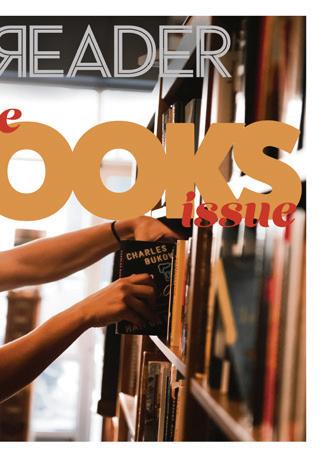









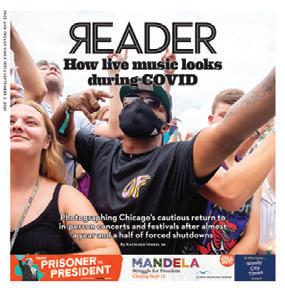
APRIL 28, 2022 - CHICAGO READER 41
@marthabayne
chicagoreader.com
notable shows
Vijay Iyer assembles a superpowered septet to pay tribute to Eve Ewing’s Ghosts in the Schoolyard

CONCERT PREVIEWS THURSDAY28
J@k@l, Fred Lonberg-Holm & Tim Daisy Duo See also Sun 5/1. J@K@L is Lonberg-Holm with Julian Kirshner and Keefe Jackson. 8:30 PM, Elastic Arts, 3429 W. Diversey #208, $15. b
IYER AND FRIENDS Fri 5/6, 7:30 PM, Logan Center for the Arts, 915 E. 60th, $40, $20 under 35, $10 students b
THE CREATIVE AND INTELLECTUAL SPHERES of Eve Ewing and Vijay Iyer are so expansive they’re pretty much impossible to abbreviate. So the news that Iyer is in town for the pandemic-deferred premiere of his musical suite inspired by Ewing’s writing, Ghosts Everywhere I Go, should inspire eager anticipation and knowing nods. Ewing and Iyer are both renowned artists and academics: Ewing is a poet and writer who teaches sociology at the University of Chicago, and Iyer is a scientist turned composer and pianist who teaches at Harvard, where he founded a doctoral program in the music department called Creative Practice and Critical Inquiry. Iyer’s restless, lyrical musical idiom is both concrete and visionary, like a skyline whose beautiful geometries are filled in with bright colors. It’s a snug fit with Ewing’s work, including her poetry collections, 2017’s Electric Arches and 2019’s 1919, and the Marvel comic series for which she writes, Ironheart; her fantastical urban imaginings face toward the future but sit upon history’s high perch. Iyer’s new suite dips into that material, but as its title implies, it’s inspired primarily by Ewing’s Ghosts in the Schoolyard, a 2018 nonfiction study of the catastrophic closure of 49 Chicago public schools under the mayoral administration of Rahm Emanuel. He especially zeroes in on her mentions of violinist and educator Captain Walter Dyett, who built up a south-side musical dynasty while teaching band and orchestra at Wendell Phillips Academy and DuSable High School. For this performance of Ghosts Everywhere I Go, Iyer will lead a juggernaut septet: flutist Nicole Mitchell, guitarist Je Parker, vibraphonist Joel Ross, bassist Nick Dunston, drummer Jeremy Dutton, and vocalists Eden Girma and Julian Otis. —HANNAH EDGAR
Cellist Fred Lonberg-Holm lived in Chicago for 22 years. During that time, he was ubiquitous on the city’s improvisational music scene, playing in bands and ad hoc groupings with so many essential players that any list that could fit in this preview would be ridiculously incomplete. He was also a tireless touring musician who represented the city abroad in partnerships with far-flung jazz luminaries, including Peter Brötzmann, Joe McPhee, and Lotte Anker. Lonberg-Holm’s methods all but demand that he work in a variety of contexts: he likes to amplify his cello’s voice and feed it through a gaggle of electronic effects, and that signal chain produces an array of sounds too broad for any single ensemble to use. Ever since he moved to Kingston, New York, in 2017, he’s returned frequently, sustaining Chicago-based outfits such as the Lightbox Orchestra and Tim Daisy’s Vox4 and bringing new bands to town. For his first visit back since the pandemic began, he’s reuniting four of the former. Ballister, his hard-hitting trio with saxophonist Dave Rempis and drummer Paal Nilssen-Love, played here April 21. On Thursday, April 28, Lonberg-Holm will visit Elastic Arts to resume his partnership with drummer Tim Daisy, which has lasted more than 20 years and spanned bands led by Daisy, Lonberg-Holm, Ken Vandermark, and James Falzone; the methods they’ve explored together include complicated jazz arrangements and chaotic noise clashes. They once worked as a duo in the studio for a single track on Daisy’s 2016 release October Music: Compositions for Duet , but they haven’t yet made a full album that documents such a pairing—a situation that should change this week. In the night’s second set, Lonberg-Holm’s trio J@K@L (with drummer Julian Kirshner and sopranino/tenor saxophonist Keefe Jackson) will revive their particular improvisational chemistry, which involves high-energy explorations of layered timbres and textures. And on Sunday, May 1, at the Hungry Brain, Lonberg-Holm will reconnect with Stirrup, a more tuneful, swinging group with bassist Nick Macri and drummer Charles Rumback. —BILL MEYER
Juana Molina Arthur Moon opens. 8 PM, Old Town School of Folk Music, 4544 N. Lincoln, $27, $25 for members. b
To experience a Juana Molina concert is to be swept away in a most particular sort of rapture. In the late 80s and early 90s, the Argentine singersongwriter had a successful career in television and comedy before changing gears to pursue music. An early proponent of combining South American folk music and electronica, Molina introduced her unconventional style with her 1996 debut album, Rara (whose title means “strange, odd, or weird”). Over the decades since, she’s developed a mesmerizing signature sound that deploys eerie vocal
42 CHICAGO READER - APRIL 28, 2022 ll
VIJAY
PICK OF THE WEEK
week of April 28 MUSIC
Recommended and
and releases with critics’ insights for the
b ALL AGES F
EBRU YILDIZ






















APRIL 28, 2022 - CHICAGO READER 43 Let’s Play! Make time to learn something new with music and dance classes at Old Town School! We offer flexible schedules for all skill levels both in-person and online. oldtownschool.org Sign up for classes today at MUSIC CLASSES FOR ADULTS & KIDS LINCOLN SQUARE LINCOLN PARK SOUTH LOOP & ONLINE OTS_1_2V_ClassAd_072921.indd 1 7/23/21 2:21 PM
MUSIC
experiments within quirky, intimate tunes that juxtapose folk guitar with detuned synthesizers, loops, and drones and sometimes dip into punk or rock; the most recent example, discounting a live album from 2020, is her 2019 four-song EP, Forfun. Molina’s compositions are highly evocative, and any attempt to extract meaning from her lyrics adds only fragments to the whole. This open-endedness has only helped her gain international traction beyond the Spanish-speaking world. In a statement on her Facebook page, Molina says her spring 2022 performances will convey the quiet sense of freedom she experienced during pandemic isolation: “I’ll improvise for you. I’ll start with songs as you know them and then hope I’ll be able to drag you in a tunnel of music.” The nature of Molina’s explorations— cathartic and soothing one moment, exhilarating and unsettling the next—promises to make any tumble down the rabbit hole with her a heady delight.
—CATALINA MARIA JOHNSON
SUNDAY1
Stirrup See Thu 4/28. Stirrup is Fred LonbergHolm, Nick Macri, and Charles Rumback. 9 PM, Hungry Brain, 2319 W. Belmont, $10. 21+
WEDNESDAY4
Patti Smith 8 PM, Metro, 3730 N. Clark, sold out. 18+
Patti Smith hasn’t released a new album since 2012’s Banga , but the Chicago-born punk singer and poet has stayed extremely active as a photographer, activist, and author. She’s published six books in the past decade, and her latest, 2019’s Year of the Monkey, is a riveting memoir. Set in 2016, it’s a picaresque ramble through dreamscapes where a trickster-like motel sign sends her on side quests
and asks leading questions while she navigates aging, a new artistic phase, and the passing of two dear longtime friends, playwright and actor Sam Shepard and producer, rock critic, and songwriter Sandy Pearlman. Honoring lost loved ones has been a recurring theme in Smith’s work since she came out of semi-retirement in the mid-90s following the deaths of her husband, guitarist Fred “Sonic” Smith (of the MC5 and Sonic’s Rendezvous Band), and of her brother and manager, Todd Smith. In Year of the Monkey, the melancholy of Smith’s devotion to and continued communication with the dearly departed is mitigated by an almost joyous lightness. She delves into the kind of glorious symbolist- and Beat-influenced flights of wordcra that helped her rise to fame in the 1970s, and the decades since her earliest albums have given her work more weight and depth than ever.
Smith’s next book, a visual collection titled Book of Days (due in November), will be drawn largely from her popular Instagram account, which she uses to share art, photographs, poetry, political thoughts, and memories that invite people into the ingeniously arranged jumble sale of her mind. Smith isn’t the only author in her band, though. In October, her collaborator of more than 50 years, guitarist and music historian Lenny Kaye, released his latest book, Lightning Striking: Ten Transformative Moments in Rock and Roll . It explores defining events in rock history, starting with a notorious Cleveland showcase hosted by Alan Freed in 1952 and culminating with the rise of grunge in Seattle a er Nirvana broke into the mainstream in 1991. In the “New York 1975” chapter, Kaye writes movingly of Smith’s ability to captivate an audience with her poetry and her cadences. Nearly half a century later, Smith continues to be a commanding presence onstage, and her strength allows her to embrace vulnerability. In 2016 she accepted the Nobel Prize on behalf of Bob Dylan, who couldn’t attend the ceremony. She was so nervous before the committee that she flubbed a line in Dylan’s “A Hard Rain’s A-Gonna Fall” (which I’m pretty sure she can normally sing in her sleep). Smith apologized, started over, and then delivered a majestic performance that raised max-
imum goose bumps with its hard-fought humanity. This concert at Metro is part of an ambitious spring and summer tour, and Smith’s set lists from previous shows have included a mix of new and classic material, along with some deep cuts. In an interview with the Guardian last month, she said she’d like to make one more album; at 75, she clearly has an eye toward her legacy, and she’s facing down this period of her life with her characteristic unflinching wits. —MONICA KENDRICK
FRIDAY6
Vijay Iyer and friends See Pick of the Week, page 42. 7:30 PM, Logan Center for the Arts, 915 E. 60th, $40, $20 under 35, $10 students. b
MONDAY9
Helado Negro 8:30 PM,Thalia Hall, 1807 S. Allport, $25-$32. 17+
For more than a decade, Brooklyn-based artist Roberto Carlos Lange has cra ed down-home pop music as Helado Negro. Each of his seven albums has shown a graceful evolution of his sonic palette, introducing scrappy psych-folk excursions, midtempo synth-pop odysseys, and other elements, but they’re all connected by an overarching gentleness at their core. Lange’s music is so inviting that every record becomes an opportunity to listen closely and feel the refinement in his sunlit aesthetics, in his cozy singing, or in his understanding of his Latino identity. Lange’s latest album, last year’s Far In (4AD), continues this trajectory with its loving invitation to examine and appreciate life’s curiosities. On “There Must Be a Song Like You,” he considers the impossibility of defining a person, using a slick bass groove to capture the slipperiness (and the comfort) of being hard to pin down. Lange takes that theme even further on “Hometown Dream,” a long-
form dance track about moving from city to city and understanding one’s time on earth as a journey of unceasing growth. Drenched in wistful nostalgia and forward-looking bliss, it’s one of most mesmerizing songs on the album.
Despite the laid-back feel of Far In , every element of the album is carefully considered. When Lange sings in Spanish on “Aguas Frías,” the language’s phonology and rhythmic meter align with its dreamy arrangement. The vocal melodies are the most striking element of every Helado Negro album, and on Far In they largely avoid huge interval jumps to ensure the listener is constantly submerged in the songs’ humid atmospheres. Even on boisterous cuts such as “Outside the Outside,” Lange’s hushed vocals (which recall Arthur Russell’s) remain tender and intimate, in short phrases that match the bubbly synths. The wordless, repeated two-bar vocal melody on album highlight “Agosto” reminds me of waking up to birdcalls: calm and simple, it’s a reminder of the joy in small beauties. Lange recently dropped a new single, the gauzy “Ya No Estoy Aquí,” which feels like being wrapped in blankets. His Thalia Hall concert should be just as nourishing as those simple pleasures.
 —JOSHUA MINSOO KIM
—JOSHUA MINSOO KIM
Moritat Imelda Marcos and Courtesy open. 8:30 PM, Empty Bottle, 1035 N. Western. 21+ F
Moritat’s new self-released album, Vermilion , settles in like the night. The Chicago art-rock band’s subtle, magnetic polyrhythms simmer with the allure of a backyard bonfire or an open-air midnight dance party, and their cool, melodious synths feel like a predawn drive on an empty road lit only by stars. Moritat’s core members—Venus Laurel, Corey McCafferty, and Konstantin Jace—rearrange the elements of post-quiet storm R&B at odd angles without disrupting its luminous, restrained thrills. Throughout Vermilion , pitter-pattering drums and plinking keys show their bony elbows even as they hang together in smooth melodic surges. Moritat carefully control the tension in their songs to engi-

44 CHICAGO READER - APRIL 28, 2022 ll
Roberto Carlos Lange, aka Helado Negro NATHAN BAJAR
Moritat COURTESY THE ARTIST
continued
from 42




APRIL 28, 2022 - CHICAGO READER 45 5~5 5~6 THE MAVERICKS ‘EN ESPAÑOL WORLD TOUR 5~13 FRI NILÜFER YANYA TASHA, ADA LEA 5~9 MON HELADO NEGRO SLAUSON MALONE 1 5~17 5~18 5~19 THE MOUNTAIN GOATS WILL SHEFF 5~27 5~28 5~29 KURT VILE & THE VIOLATORS NATURAL INFORMATION SOCIETY 5~16 MON JENS LEKMAN & YOUTH ORCHESTRAS ACROSS THE USA 5~25 WED HOMESHAKE SALAMI ROSE JOE LOUIS 5~22 SUN BONNIE ‘PRINCE’ BILLY PERFORMANCE & CONVERSATION 5~10 TUE MEWITHOUTYOU FAREWELL TOUR TIGERS JAW 5~12 THU DESTROYER ROSALI 5~20 FRI ESTHER POVITSKY 5~26 THU BENDELACREME IS...READY TO BE COMMITTED THE ANTLERS WILD PINK (SOLO) 5~31 TUE SOLD OUT LOW TIX WED 5~11 SLEAFORD MODS SORRY TUE 5~3 THE CAROUSEL TOUR FEAT. ANTHONY GREEN, LAURA JANE GRACE, TIM KASHER, MIKEY ERG SUN 5~1 PEDRO THE LION OCEANATOR COMING SOON TO THALIA HALL SIGN UP FOR OUR WEEKLY NEWSLETTER AT THALIAHALLCHICAGO.COM
neer emotional payoffs: on the 2021 single “Camera,” squared-off panes of shimmering keys compete with thrumming, frazzled rhythms, so that the sudden blossoming of vocal harmonies releases the song’s coiled energy like an ecstatic fireworks display. —LEOR GALIL
ALBUM REVIEWS
Congotronics International, Where’s the One? Crammed Discs congotronicsinternational.bandcamp.com/album/ wheres-the-one
Congotronics International is rooted in Konono No. 1 and the Kasai Allstars, two bands from the Democratic Republic of the Congo that released music through legendary Belgian label Crammed Discs in the mid-2000s. Those groups’ hyperamplified, percussion-heavy sounds, which Crammed released in a series dubbed Congotronics (also the title of Konono No. 1’s 2004 album debut), electrified and inspired a huge number of experimental artists, including Argentine songwriter Juana Molina, San Francisco rock band Deerhoof, New York-via-Oberlin collective Skeletons, and Swedish duo Wildbirds & Peacedrums. Joined by series creator Vincent Kenis, a Belgian musician and producer who’s long worked closely with Crammed Discs, these American and European performers came together with the Congolese groups for the Congotronics vs. Rockers tour in 2011—the resulting ensemble had ten lead vocalists, five guitarists, three likembe players, five percussionists, two bassists, three drummers, and lyrics in multiple languages. The resulting album, Where’s the One? (Crammed Discs), released under the name Congotronics International, is predictably a sprawling
affair; its 23 tracks, recorded and remixed over more than a decade, total 82 minutes. The title refers to the fact that, due to their diverse backgrounds, the musicians had trouble figuring out where the first beat in each measure actually fell. In the end, they managed to create songs of exhilarating focus, such as the sweet dance-floor blast of “Super Duper Rescue Allstars” and the fuzzy barrage of “For Augustin.” On “Kule Kule Redux,” the feedback blare of Kinshasa sound systems and the feedback blare of postpunk guitar merge into a single boogie noise fire, while “Where’s the One” underlines the African roots of Juana Molina’s delightfully hypnotic looping rhythms. Where’s the One? feels even more immense, joyful, and perfectly imperfect than the globe. —NOAH
BERLATSKY
Defcee & BoatHouse, For All Debts Public and Private Closed Sessions
defcee.bandcamp.com/album/for-all-debtspublic-and-private

If you need an introduction to Defcee, you haven’t been paying attention to underground hip-hop in Chicago. The rapper had a banner year in 2021, thanks to three collaborative releases that nudged him further into the national spotlight: June’s We Dressed the City With Our Names, a collaboration with beat maker August Fanon; September’s Sunday Sessions by defprez, aka the duo of Defcee and MC CRASHprez; and November’s Trapdoor , made in partnership with shit-hot producer Messiah Musik and released through Backwoodz Studioz, a hub for abstract east-coast rappers. On the new For All Debts Public and Private, released by hometown indie Closed Sessions, Defcee isn’t kidding around. Closed Sessions’ in-house beat maker, BoatHouse, produced the entire album, and his polished take on boom-bap mirrors Defcee’s diligent professionalism. Defcee isn’t flashy on the mike, but he’s a linguis-

tic alchemist, molding alliterative phrases that flash out unpredictably as he rolls efficiently through his bars. He locks into the watery, stretched-out soul sample on “Moving Targets” to indict the toxic competitiveness that capitalism forces on working rappers, fueled by a resolute poise that could gas up the entire scene.
—LEOR GALIL
Supa Bwe, No Thanks Freddy Got Magic stem.ffm.to/nothanks
Supa Bwe’s ear for melody and taste for sweet hooks make him one of the city’s best rappers. Since breaking out in 2014, he’s amassed a cult audience with performances that blend screamo intensity and R&B sensuality, and he was doing it years before Soundcloud rap introduced a cohort of shouty rappers who sounded like they belonged on a Warped Tour side stage at 3 PM. Supa leans further into pop with his new album, No Thanks (Freddy Got Magic). On “You Don’t Listen” he polishes his blunt verses with a hint of Auto-Tune, and his sturdy, to-thepoint flow plants the song in your head like an earwormy radio hit. He’s also put a new sting into his aggressive shouts, as much with content as with delivery: he’s now focusing much more intently on indictments of white supremacy. Supa has delivered thoughtful dissections of racism before (on the 2014 Hurt Everybody single “Treat Me Caucasian,” for instance), but throughout No Thanks he goes even further, harnessing the language of the policeabolition movement (“ACAB”) and Black revolutionaries (“Hellcat”). These explicitly political verses resonate as powerfully as the best work in his back catalog. Supa has lots of people in his corner too, and plenty of them show up on No Thanks , including Jamila Woods, Mick Jenkins, SheGo Turbo, Chance the Rapper, and Twista. The album makes a great case that Supa also belongs in the top tier of Chicago hip-hop. —LEOR GALIL v

46 CHICAGO READER - APRIL 28, 2022 ll
Defcee (le ) and BoatHouse JONATHAN “KAYODIDTHAT” JAGIELLO
MUSIC
more music listings at chicagoreader.com/musicreviews 5/4 OPLIAM with special guest Vision in the Rhythm 5/11 Paulo Padilha WORLD MUSIC WEDNESDAY SERIES FREE WEEKLY CONCERTS, LINCOLN SQUARE OLDTOWNSCHOOL.ORG 4544 N LINCOLN AVENUE, CHICAGO IL OLDTOWNSCHOOL.ORG • 773.728.6000 THURSDAY, APRIL 28 8PM Juana Molina In Maurer Hall THURSDAY, MAY 5 7PM Identity Dance Concert - Fearless with live music featuring Chromabeats In Szold Hall THURSDAY, MAY 5 8PM Steven Page (formerly of Barenaked Ladies) In Maurer Hall FRIDAY, MAY 6 7PM Chicago Immigrant Orchestra / Zeshan B. at the American Islamic College Auditorium MONDAY, MAY 9 7:30PM Chicago Cabaret Professionals Musical Mondays Pop Goes the Cabaret • In Szold Hall WEDNESDAY, MAY 18 9:30PM Valerie June with special guest Chastity Brown • In Maurer Hall SUNDAY, MAY 22 7PM Matt Andersen In Szold Hall TUESDAY, MAY 24 8PM Bombino In Maurer Hall WEDNESDAY, MAY 25 8:30PM Concert for Ukraine: A Night of Ukrainian Song and Dance In Maurer Hall UPCOMING CONCERTS AT NEW SHOWS JUST ANNOUNCED • ON SALE NOW 5/25 Concert for Ukraine: A Night of Ukrainian Song and Dance 6/16 Laura Veirs
Supa Bwe COURTESY THE ARTIST
continued from 44
Find



















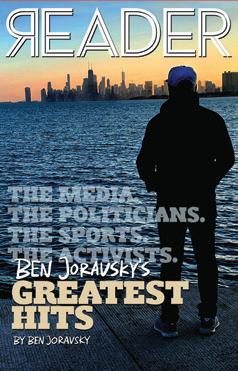
APRIL 28, 2022 - CHICAGO READER 47 Food & Drink A weekly newsletter featuring exclusive new writing by our critic Mike Sula and the latest restaurant reviews, chef profiles, and more from our site. Hot off the grill every Friday. chicagoreader.com/newsletters SANDY NOTO FOR CHICAGO READER 3730 N CLARK ST METROCHICAGO.COM @METROCHICAGO SMARTBARCHICAGO.COM 3730 N CLARK ST | 21+ FRIDAY MAY 06 Obscure + Format welcome LUIS FLORES (live) DJ HYPERACTIVE NOCH FRIDAY APR 29 MATRIXXMAN JUSTIN AULIS LONG JAQ ATTAQUE SATURDAY APR 30 LTJ BUKEM ARMANNI REIGN STUNNA TOYACOYAH FRI MAY 06 + SAT MAY 07 / 7:30 PM / 5+ ASHE: THE FAULT LINE TOUR + The Brook and The Bluff FRIDAY APR 29 / 9PM / 18+ SEAN HEALY PRESENTS KOTA THE FRIEND: FLIGHT NIGHT with Bri ney Carter / King Trey Joel Q / Daylight Tone / Gatson Kuhlahbee / Brandon Ross THURSDAY MAY 12 / 8PM / 18+ OBSESSED PRESENTS BOULET BROTHERS’ DRAGULA Season 4 Tour THURSDAY MAY 12 / 9PM / 21+ @ SLEEPING VILLAGE / METRO PRESENTS ANDY STOTT + Debit FRIDAY MAY 13 / 7:30PM / 5+ THE REGRETTES + Alex Lahey SAT MAY 14 COLD WAVES PRESENTS FRONT LINE ASSEMBLY + REIN / Choke Chain LUCIUS RUPAUL’S DRAG RACE BRITISH INVASION ROCHELLE JORDAN @ SLEEPING VILLAGE SONS OF THE SILENT AGE FURBALL IML: CHICAGO DEHD SUPERCHUNK EMMIT FENN MAY 20 MAY 21 MAY 26 MAY 28 MAY 28 JUN 04 JUN 06 JUN 08 Laid Back | Cold Beer | Live Music @GMANTAVERN GMANTAVERN.COM 3740 N CLARK ST 21+ TUE MAY 03 ANGEL IN REALTIME TOUR GANG OF YOUTHS + Casual Male TUE MAY 03 ANGEL IN REALTIME TOUR GANG OF YOUTHS + Casual Male SAT MAY 21 LATE SHOW ADDED! RUPAUL’S DRAG RACE British Invasion Tour WED MAY 11 DAN ANDRIANO & THE BYGONES + Emily Wolfe 235 pages / perfect bound / 5.5” x 8.5” size Available in paperback and PDF download chicagoreader.com/store Ben Joravsky’s Greatest Hits is a collection of profiles and features hand-picked by Ben from his 40 years of writing for the Reader. Each article offers a distinctive portrait of an activist, politician, writer, or sports personality who has left an indelible imprint on Chicago.
EARLY WARNINGS
Igor & the Red Elvises 7/7, 8:30 PM, Reggies Music Joint Joystick featuring DJ Eddie Martinez, DJ Tony Moran 8/6, 9 PM, Aragon Ballroom Kangaroo Court, Lollygagger, Scarlet Demore 5/19, 8 PM, Subterranean, 17+
The King Khan & BBQ Show, Miranda & the Beat 9/4, 8 PM, Lincoln Hall, 18+ Lady Starlight, Justin Aulis Long, Jeff Derringer 5/21, 10 PM, Smart Bar Lauv, Hayley Kiyoko 8/12, 7:30 PM, Aragon Ballroom b Legendary Pink Dots, Orbit Service 11/16, 8 PM, Beat Kitchen
Legions of Metal Fest day one featuring Nasty Savage, Slough Feg, Silver Talon, and more 5/13, 5 PM, Reggies Rock Club, 17+
NEW
Charlotte Adigéry & Bolis
Pupul 5/14, 8:30 PM, Empty Bottle
Alok 5/19, 10 PM, Prysm Nightclub
American Music Festival day one featuring Son Volt, Jackie Venson, Aaron Lee Tasjan, Jon Dee Graham, Waco Brothers, Mike Clark & the Sugar Sounds, S.G. Goodman, Heavy Sounds, Michelle Billingsley 7/1, 5 PM, FitzGerald’s, Berwyn b
American Music Festival day two featuring Rebirth Brass Band, Marshall Crenshaw, Daddy Long Legs, Lilly Hiatt, Chicago Farmer & the Fieldnotes, Chicago Soul Jazz Collective with Dee Alexander, Fox Crossing String Band, Sarah Borges, Jonah Tolchin, Claudettes, Los Gallos, and more 7/2, 1 PM, FitzGerald’s, Berwyn b American Music Festival day three featuring Alejandro Escovedo, Ike Reilly Assassination, Lydia Loveless, C.J. Chenier & the Red Hot Louisiana Band, Riley Downing, Deeohgee, Sugaray Rayford, Kevin Galloway, Mario Abney & the Abney Effect, Miss Tess, Jonas Friddle, Wild Earp, and more 7/3, 1 PM, FitzGerald’s, Berwyn b
American Music Festival day four featuring North Mississippi Allstars, Marcia Ball, Robbie Fulks, Joe Pug, Riley Downing, Terrance Simien, Shamarr Allen, Yawpers, Cordovas, Rachel Baiman, Esther Rose, Gerald Dowd, William Harries Graham, Lawrence Peters Outfit, Oak Park Fiddle Camp 7/4, 1 PM, FitzGerald’s, Berwyn b
Anika 5/23, 8:30 PM, Empty Bottle
Barrie, Girl K 5/18, 8 PM, Schubas, 18+
Julianna Barwick, Malibu 5/12, 8 PM, Lincoln Hall, 18+
Tab Benoit, Larry McCray 6/11, 9:30 PM, House of Blues, 17+
Bleu Clair 5/14, 10 PM, Prysm Nightclub
Bob Log III, Hustle, Baron Von Future 6/10, 8 PM, Beat Kitchen, 17+
The Body, Midwife, Rxm Reality 5/27, 10 PM, Empty Bottle
Bono Bros Band 5/12, 8:30 PM, FitzGerald’s, Berwyn Bowling for Soup, Less Than Jake, Aquabats 7/8, 6 PM, House of Blues b Butchered, Nowhere Fast, Barren Plains 5/21, 9 PM, Gman Tavern
Calexico 10/7, 8 PM, Metro, 18+
Carpenter Brut 8/27, 9 PM, Metro, 18+
Marc Cohn 5/17-5/18, 8 PM, City Winery b
Cold Waves night one featuring TR/ST, the KVB, Actors, Kontravoid, Leathers, New Canyons 9/22, 7 PM, Metro, 18+
Cold Waves night two featuring Covenant, Kite, Empathy Test, Spike Hellis, Ghostfeeder, Rare DM 9/23, 7 PM, Metro, 18+
Cold Waves night three featuring Revolting Corpse, Stromkern, Rein, Haex, Cyanotic, Haloblack 9/24, 7 PM, Metro, 18+
Colette’s Birthday featuring Colette, DJ Heather, Pete Moss, Dajae 5/14, 10 PM, Smart Bar
Crown the Empire, D.R.U.G.S., Word Alive, Until I Wake 6/14, 7 PM, House of Blues, 17+
Darius, Cezaire 5/13, 9 PM, Lincoln Hall, 18+
Davido 6/23, 8 PM, Aragon Ballroom, 17+
Deadmau5, Nero (DJ set), Lamorn, Morgin Madison 9/23, 6:30 PM, Huntington Bank Pavilion b
DKB 6/12, 6:30 PM, Concord Music Hall b
Elder Island, Jordann 5/18, 8:30 PM, Lincoln Hall, 18+
Ensemble Español’s Duende Flamenco featuring La Lupi, Curro de María, Paco Fonta, Jose Moreno, and more 6/8, 8:30 PM, Maurer Hall, Old Town School of Folk Music b
Eric Wagner: A Night of Remembrance featuring the Skull, Damien Thorne, and more 6/18, 9 PM, Reggies Rock Club, 17+
Every Shiny Thing: A Tribute to Joni Mitchell featuring Andrea Bunch 6/3, 8 PM, Maurer Hall, Old Town School of Folk Music b
Flasher 6/25, 8:30 PM, Empty Bottle
Ghastly 5/20, 10 PM, Prysm Nightclub
Giant Rooks 5/16, 7:30 PM, Schubas, 18+

Grateful Shred 5/15, 8 PM, Thalia Hall, 17+
Chris Greene Quartet 5/29, 7 PM, SPACE, Evanston b
Hot Milk, Doll Skin, Guardrail 5/16, 6:30 PM, Subterranean b
House of Love 10/23, 8 PM, Lincoln Hall
Charlie Hunter & Scott Amendola 5/20, 7 PM, SPACE, Evanston b
Hyde Park Summer Fest featuring Busta Rhymes, Lupe Fiasco, Marsha Ambrosius, BJ the Chicago Kid, DJ Jazzy Jeff, Terry Hunter, Jay Illa, Boolu Master, Mustafa Rocks, and more 6/11-6/12, Midway Plaisance Park b
Legions of Metal Fest day two featuring Riot, Brocas Helm, Medieval Steel, and more 5/14, 3 PM, Reggies Rock Club, 17+
Coi Leray 6/8, 6:30 PM, Concord Music Hall b Lithia, Uma Bloo (solo), Sick Day (solo) 5/15, 8 PM, Gman
Tavern
Lizzo, Latto 10/16, 8 PM, United Center b MC Magic, Lil Rob, Jayroxxx, Los Terricolas 8/27, 7 PM, the Vic b
Tommy Malone of the Subdudes, Liz Barnez 6/17, 8 PM, SPACE, Evanston b Manifest featuring Krytogram, Abigail, Zooey Glass, Kirk 5/13, 10 PM, Smart Bar Billie Marten, Sarah Weddle 5/14, 8 PM, Schubas, 18+ Michael McDermott 5/14, 8 PM, City Winery b MCND 6/10, 7 PM, Bottom Lounge, 17+
Sergio Mendes 10/2, 5 and 8 PM, City Winery b Monalisa & Rodrigo 6/29, 8:30 PM, Maurer Hall, Old Town School of Folk Music Fb
Mystery Actions, Watermelon, Exedo 5/13, 9 PM, Gman Tavern
National Tap Day Chicago Style featuring Reggio “the Hoofer” McLaughlin, Arthur Duncan, Sid Brown, and more 6/4, 7:30 PM, Maurer Hall, Old Town School of Folk Music b
No Trigger, Bollweevils, Knoxious 6/16, 8 PM, Reggies Music Joint Novo Amor 9/28, 7 PM, Metro b
Obisoulstar 6/30, 8 PM, City Winery b Papooz, Jackie West 5/16, 8 PM, Lincoln Hall, 18+ Pinebender, Allen Epley 5/13, 8:30 PM, FitzGerald’s Poptropicaslutz!, Lucas Lex 5/15, 7 PM, Beat Kitchen b
b ALL AGES F
GOSSIP WOLF
Ariel Posen 5/16, 8 PM, City Winery b
Rhett Price 7/9, 9 PM, Reggies Music Joint
Rata Blanca 10/1, 10 PM, Bottom Lounge, 17+ Ravyn Lenae 6/22, 7:30 PM, Metro b
Redmonds, Petty Union 5/19, 8:30 PM, FitzGerald’s, Berwyn Rlyr, Djunah, Salvation 5/13, 10 PM, Empty Bottle
Saint Marlboro, Laughing Hearts, Beach Trash 5/18, 7 PM, Subterranean, 17+ Sir Chloe, Moon Kissed 5/12, 8 PM, Subterranean, 17+ Stoner, Mario Lalli & the Rubber Snake Charmers, Cloud Cruiser, Purepilot, Ricky Liontones 9/1, 8 PM, Reggies Rock Club, 17+ Streetlight Manifesto 11/18, 8 PM, Radius Chicago b Teenage Wrist, So cult, Soul Blind 6/15, 8 PM, Cobra Lounge, 17+ Thousand Below, Savage Hands, Sleep Waker 5/13, 8 PM, Beat Kitchen, 17+ Tora, So max 5/19, 9 PM, Schubas, 18+ Trdml, Ivy Hollivana, Cam Stacey 5/12, 8:30 PM, Empty Bottle
Value Select, Jazz Emu 5/12, 7 PM, Schubas b What It Is featuring Robert Owens, Shaun J. Wright 5/20, 10 PM, Smart Bar Widowspeak, Dan Wriggins, V.V. Lightbody 5/14, 8 PM, Beat Kitchen, 17+ Yam Haus 5/12, 8 PM, Beat Kitchen, 17+
Zegema Beach Records Fest night one featuring State Faults, Gillian Carter, Massa Nera, Hundreds of AU, and more 6/11, 5 PM, Beat Kitchen, 17+
Zegema Beach Records Fest night two featuring Hawak, Meth, Life in Vacuum, Locktender, Heavenly Blue, and more 6/12, 5 PM, Beat Kitchen, 17+
Zimmermen 5/14, 9 PM, FitzGerald’s, Berwyn
UPDATED
Peter Hook & the Light 8/198/20, 8 PM, Metro, 8/20 sold out, 18+ Hanson 8/13, 7:30 PM, House of Blues, venue changed b Lucius, Celisse 5/20, 8 PM, Metro, venue changed, 18+ v
GOSSIP WOLF DOESN’T like to speculate about which band breakups will stick (it’s no fun to be wrong), but when local indie-pop goofballs Baby Teeth announced their final show in 2012 , it seemed unlikely that Chicago had heard the last from them. In the years that followed, singer-songwriter Abraham Levitan , front man of the trio, told this wolf more than once that he hoped to play again with bassist Jim Cooper and drummer Peter Andreadis—and lo and behold, Baby Teeth returned to gigging in 2018. It still took a while for them to get back to releasing fresh jams, and the new single “Don’t Go Outside” is only their second since then. It weds Levitan’s knack for describing the despair of encroaching middle age with a dollop of Cars-style new-wave sheen—resulting in what’s surely one of the most rousing odes to social claustrophobia ever written! On Saturday, May 7, Baby Teeth will headline the Hideout with opener Judson Claiborne
It was only a year or so ago that Gossip Wolf slathered praise on the debut LP from Spread Joy, whose mix of postpunk and no wave immediately made them standouts in the city’s DIY punk scene. On Friday, May 13, the four-piece will drop their second album, II, and its lead single, “Repetition,” packs one heck of a wallop—its devilishly satisfying riff would’ve fit right in on Wire’s Chairs Missing. Spread Joy will celebrate the release with a show at the Hideout on Wednesday, May 11 , with openers Floatie and Spllit
On Saturday, April 30, Terra Squad Footwork Company will host a footwork celebration at 1456 E. 70th that doubles as a tribute to a fallen member— Jeremiah “Miah the Great” Sterling , gunned down in July 2010. “He was filled with high energy, loved to laugh, and wanted to succeed as a DJ/footworker,” writes Terra Squad’s King AGee DJ Clent , DJ Phil , and DJ Corey spin. The event runs from 5 to 9 PM, and admission is a $7 donation.
—J.R. NELSON AND LEOR GALIL
Got a tip? Tweet @Gossip_Wolf or e-mail gossipwolf@chicagoreader.com.

48 CHICAGO READER - APRIL 28, 2022 ll
Never miss a show again. Sign up for the newsletter at chicagoreader. com/early
Flasher AMY BREESMAN
A furry ear to the ground of the local music scene
CHICAGO SHOWS YOU SHOULD KNOW ABOUT IN THE WEEKS TO COME
WOLF BY KEITH HERZIK















APRIL 28, 2022 - CHICAGO READER 49 LIVE MUSIC IN URBAN WINE COUNTRY 1200 RANDOLPH STREET, CHICAGO, IL 60607 | 312.733.WINE don’t miss... Coming Soon... Asleep at the Wheel 5.8 CeCe Peniston 5.2 Sondre Lerche with mmeadows Marc Cohn 5.18 5.15 5.10 TAKE ME TO THE RIVER ALL-STARS NEW ORLEANS 5.14 MICHAEL MCDERMOTT 5.16 ARIEL POSEN 5.20 BILAL 5.22 BEATLES BRUNCH 5.225.23 THE CAROLE KING & JAMES TAYLOR STORY 4.284.29 ALAN DOYLE WITH CHRIS TRAPPER 5.1 MIDNIGHT SUN 5.3 SWEET WATER WARBLERS 5.5 EILEN JEWELL 5.9 ERTHE ST. JAMES 5.25 YAEL NAIM 5.265.27 THE STEELDRIVERS 5.29 TERISA GRIFFIN 5.30 THE LINDA RONSTADT EXPERIENCE 5.31 NATALIE CRESSMAN & IAN FAQUINI 6.1 K'JON 6.2 CATHY RICHARDSON 6.3 SHAYNE SMITH 6.5 GREAT MOMENTS IN VINYL plays Crosby, Stills & Nash 12 PM 6.6 KAKI KING 6.146.15 MIKI HOWARD 5.17 with Geoffrey Baer NEW SEASON : White Castle is modeled after what iconic Chicago Landmark? #quizWTTW wttw.com/quiz THURSDAYS beginning APR 21 8:00 pm
SAVAGE LOVE
SAVAGE LOVE
My wife wakes up at 3 AM to masturbate
Quickies on topping, whipped cream, and chastity cages
By DAN SAVAGE
Q : I’m a heavy sleeper, and my wife knows that, but not so heavy that I don’t wake up when she periodically masturbates next to me and has the bed shaking pretty hard. She doesn’t know this wakes me. How do I handle this? Do I offer a hand (or a dick) the next time? Talk to her when she’s not having her moment and ask if she feels like our sex life is lacking? Or just let it go and continue to pretend that I’m still asleep when this happens? Our sex life seems healthy to me otherwise.
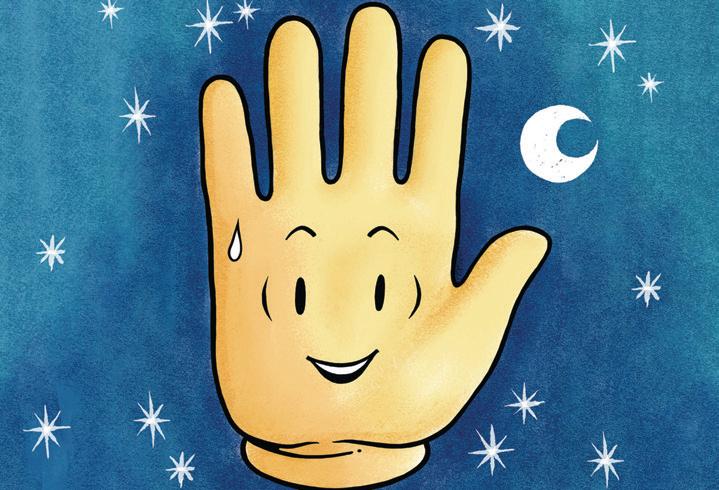
—NOCTURNAL INCIDENTS THAT ERUPT NECESSITATE INQUIRIES TO ELUCIDATE
A : The wife masturbating in the middle of the night isn’t by itself evidence your sex life is lacking, NITENITE. She’s most likely waking up horny at 3 AM and rubbing one out to get back to
sleep. You can and should tell her over breakfast—with a loving and supportive smile on your face—that you sometimes wake up when she’s masturbating, and that you’re happy to help her out. But if all your wife wants and/ or needs at 3 AM is a quick orgasm, she may not be interested in a full-blown sex session. And if “helping her out” means she’s obligated to get you off before she can go back to sleep, NITENITE, don’t be surprised if she passes (and slips out of bed the next time she needs to have a wank).
Q : Gay man here with a question about topping. I was a top with my college boyfriend but switched to being mostly a bottom in my early 20s. I’m in my late 30s now, and recently got out of a decade-long relationship, so I’ve been
doing a lot of exploring and rediscovering what I want in bed. While I’m very experienced as a bottom, I feel a bit like a fish out of water when I’m topping. The guys I’ve fucked have all been very complimentary, so it doesn’t seem to be a problem with my technique, but it’s just not as intense for me. Also, I’m uncut and I find that if I’m pushing deep inside someone then my foreskin pulls all the way back while I’m inside to the point that it hurts. (This is especially a problem when a guy rides me.) I’m with a new boyfriend who has enjoyed bottoming for me, but all of this is kind of playing with my head so I can’t just relax and enjoy myself when topping. Should I just accept that topping isn’t for me?
—SUBPAR ORGASMS FROM TOPPING
A : You could accept that topping isn’t for you and swear off topping forever . . . but that seems a little dramatic, SOFT, and a whole lot drastic. How about accepting this instead: While you prefer bottoming to topping and your orgasms are better when you bottom, you also enjoy topping occasionally, so long as you don’t push too far in and/ or get ridden too hard. You might also wanna accept the compliments you’ve been getting about your topping skills/style. Instead of assuming the guys you’ve topped are lying to you, give them the benefit of the doubt and assume they’re telling the truth: you’re a good top and bottoming for you is a good time. And with more experience, SOFT, you’re likely to get even better at it, earn more praise, and grow to enjoy topping more.
Q : I am a 60-year-old woman who has had a lot of lovers. My current lover does not enjoy cunnilingus, which happens to be the only reliable way to get me off. How can I make cunnilingus more enjoyable for him? I thought about getting a can of whipped cream to “sweeten the deal,” but will that work? —EXCITING
ADDITIVES THAT MAKE EATING PUSSY A LARK
A : It won’t work. First, putting whipped cream on your clit and labia isn’t good for pussy—and since whipped cream rapidly melts a er being applied to the body, EATMEPAL, it’s not going to look sexy or taste good for long. Minutes a er emptying that can of whipped cream, you’re gonna look and smell like a newborn puked on your lap. Chocolate sauce, flavored lubes, whipped
cream—none of those things have the power to turn someone who doesn’t like eating pussy or sucking dick into someone who does. Pussy is not a sundae, dick is not a candy bar. If cunnilingus is the only thing that reliably gets you off, it’s a new lover you need, EATMEPAL, not a dairy product.
Q : I’m a male who is curious about wearing a male chastity cage. I’m on bloodthinning medications and I very rarely get erections due to my health issues, but I want to experience the feeling of wearing a cage. Are there any long-term effects from wearing a cock cage for short periods of time that I need to know about? I am just curious how it would feel wearing one.
—LOOKING INTO MYSTERIOUS PLEASURES
A : You’ll be fine, LIMP. I’ve spoken to a few urologists over the years about the risks of chastity cages for men, and their only concern was potential damage to the erectile tissues when a dick gets hard (or tries to) in the confines of a cage. If you rarely get hard—or don’t get hard randomly—there’s no danger in wearing one even for extended periods of time, so long as it’s not too tight, LIMP, and you keep it clean.
Q : I’m a 20-year-old woman who just started a new job. One of my new coworkers is a 20-something man who doesn’t speak much English, but he’s made it very clear that he’s attracted to me. I found him on Facebook and realized he has a girlfriend in another country. So, as it turns out, he’s in a threeyear-long relationship, but he can’t be with her currently. I’ve always considered men in relationships to be strictly “off-limits,” but I’ve got an intense crush on this man and wanna get with him. I’m only interested in
hooking up. I’m not looking for a commitment from him at all. Should I let him know I am attracted to him too and possibly ruin his relationship? —POSSIBLE
WRECKING BALL
A : Unless you’re planning to post to Facebook about fucking this guy and tag his girlfriend back home, I don’t see how fucking you—even if he’s not supposed to be fucking anyone while they’re apart—will automatically ruin his relationship. Here’s hoping he’s allowed to fuck other women while they’re separated like this, PWB, and here’s hoping she’s allowed to fuck other guys. But even if he were to break the rules to get with you, PWB, it doesn’t mean that he would break her heart . . . so long as you’re capable of being discreet.
Q : I learned that you helped pegging get its name. But is there a name for a man using a strap-on on a woman?
—STRAPPED ON DUDE
A : In 2001 my readers decided—in a free and fair election—to give the name “pegging” to the act of a woman fucking a man in the ass with a strap-on dildo. Some pegging purists have argued that the word should continue to mean that and only that, but language evolves and changes. These days women peg men, men peg women, women peg women, men peg men, and enbys peg all comers.
Q : Is it okay to get a quick “happy-ending” massage once a month if you are getting almost no sex in the marriage? —REEVALUATING UNDERSTOOD
BOUNDARIES
A : It’s OK with me. v Send letters to mail@ savagelove.net. Download the Savage Lovecast at savagelovecast.com.
50 CHICAGO READER - APRIL 28, 2022 ll
NEWTON
@fakedansavage JOE






























APRIL 28, 2022 - CHICAGO READER 51 CALL 1-855-927-2570 promo code N7017 * Prices are per person based on double occupancy plus up to $299 in taxes & fees. Single supplement and seasonal surcharges may apply. Add-on airfare available. Free date changes prior to final payment. Deposits and final payments are non-refundable. Onboard Credit requires purchase of Ocean View or Balcony Cabin. O ers apply to new bookings only, made by 6/30/22. Other terms & conditions may apply. Ask your Travel Consultant for details. BEST OF HAWAII FOUR-ISLAND TOUR GRAND ALASKAN CRUISE & TOUR Oahu • Hawaii Island • Kauai • Maui — Enjoy a fully guided 4-island Hawaiian vacation with centrally located lodging in Waikiki on Oahu, and beachfront lodging on the “Big Island” of Hawaii, Kauai, and Maui. Guided throughout by our friendly Tour Directors—your local experts. Includes 3 inter-island flights. Seattle • Vancouver • Ketchikan • Juneau • Skagway • Glacier Bay • Anchorage • Denali • and more Visit Denali and Glacier Bay on the same incredible trip! Cruise through the Gulf of Alaska and the Inside Passage as you discover the best of the Frontier State by land and by sea. 12 days, departs year-round 12 days, departs July - Sep 2022 FREE ONBOARD CREDIT FREE DATE CHANGES FROM $2,549 $2,299 * FROM $1,949 $1,699 * 600+ Tours starting from $1,200 pp Speak to an expert at: 866-502-2279 Hours: 9 am - 7 pm EST Monday - Friday AVAILABLEATRISE
JOBS
MANUFACTURING
PROCESS ENGINEERPower Plant Services in Melrose Park, IL seeks qualified Mfg Process Eng. Collaborate w/ eng teams & mfg facilities to develop processes & equipment to support product mfg & new product launches. Masters or foreign equiv in Mech Eng, Mfg Eng or in closely rltd fld of study (Will accept Bachelors in above flds + 5 yrs of progressive exp in lieu of Masters) each alt req w/ at least 2 yrs of pro exp in: (i) Utilizing SolidWorks AutoCAD &/or Mastercam to design, develop & model Computer Numerical Control (CNC) machinery, products & mfg processes; (ii) performing root cause investigations, Failure Mode & Effect Analyses (FMEAs) & implementing Corrective Actions/Preventative Actions (CAPAs) to improve mfg processes; & (iii) gathering, maintaining, formatting, compiling & manipulating tech data, incl customer design drawings, specs, materials test results & eng design changes; & (iv) using ERP systems. Emp will accept any suitable combo of edu, training, or exp. 40 hrs/wk. Respond by mail: Power Plant Services, Attn: Victoria Alvino, 3131 W. Soffel Ave., Melrose Park, IL 60160. Refer to ad code: PPS-0721.
ENGINEERING
Yum Connect, LLC. has an opening in Chicago, IL for Senior Node.JS Engineer – eCommerce Platform to develop, optimize and refactor Node.js based web services. Telecommuting permitted. Ref job code C#5719408 & mail resume to: Yum Connect, LLC. Attn: HR, 3301 Stober Road, Louisville, KY 40213.
TransUnion, LLC seeks Advisors for Chicago, IL location to independently architect, design, analyze & dev high availability & highly scalable sw apps. Master’s in Comp Sci/Comp Eng/any Eng or Tech field +2yrs exp. OR Bachelor’s in Comp Sci/Comp Eng/any Eng or Tech field +5yrs exp req’d. Req’d Skills: SME in ETL applications; hands on exp dev Ab-Initio solutions (Express>IT, continuous flows, control center) incl on Cloud, meta-programming, vectors, parallelism, Hadoop, Linux, Shell scripting, Autosys, ACE, BRE, Metadata Hub, SQL, Hive, Spark, Oracle, Agile. Send resume to: A. Goodpasture, REF: AP, 555 W Adams St, Chicago, IL 60661.
Claire’s Stores Inc. seeks SVP, Inventory Management & Allocation in its Hoffman Estates, IL location. Minimum Requirements: Master of Business Administration degree required. In lieu of a Master’s will accept a Bachelor’s plus 5 yrs of progressively responsible exp. 5 years of exp in the position offered or 5 yrs of exp as a VP, Planning & Allocation – Localization. Related exp must include experience developing well supported business solutions using operations research analysis & statistical analysis to provide specific recommendations to enable the company to make critical business decisions; implement automation in business processes to improve profitability by creating solutions to leverage data points daily across product lines to determine the precise allocation of inventory to meet customer dem&; leading the strategic direction of localizing merchandise across business units; lead the growth of E-commerce through merchandise planning, assortment/ item strategy & planning, & markdown strategy & execution. Please send resumes to Tara Sarrazin, Senior Corporate Recruiter, 2400 West Central Road, Hoffman Estates, IL 60192
Lend Lease (US) Services, Inc. seeks Dvlpmnt Prjct Mngr - Construction, in Chicago, IL to design prjct management of construction projects, from pursuit to when prjct focus shifts to construction. 20% domestic travel to job sites. Send CV & cover letter to usmobility @lendlease.com, ref #sagqt
BA ServiceNow Manager – (Chicago, IL) RSM US LLP: Prov analysis, devel & documentation of technical & digital improvement opps. *May work remotely from anywhere in US. Reqs: Bachelor’s (or frgn equivt) in Info Tech, Management Info Systs, Comp Sci or rel field; 5 yrs exp as a Technical Consultant, IT Analyst, or a rel position. Up to 10% travel required Email resumes to: Attn: C Volkening – Ref # 2455, claudine.volkening@ rsmus.com
SR. TECHNICAL SALES ENGINEER (job site: Chicago, IL). Mail resume to Jamie Beehn, Ocient, Inc., 100 N. Riverside Plaza, Ste 800, Chicago, IL 60606; email: jbeehn@ocient.com.
Principal Mechanical Engineer – Screen emerging tech, demo products/services in pilot projects, transition findings into measures for natural gas and electric utility. Duties: obtain info needed for emerging tech due diligence process; lead manufacturers, contractors, users in pilots; lead/assist in design/ execution of lab and field emerging tech pilots, incl data acquisition/analysis; design mech solutions, incl eval under lab and field environments; resolve project level issues; become an expert for emerging tech; develop tech understanding, grasp of economics, and market awareness for emerging tech; coordinate w in-house contracting, purchasing, and accounting. Reqd: MS in Mech Eng w thesis or comp research publication in the energy, thermodynamics, or fluids; 2 yrs exp w instrumentation and data acquisition systems for field demonstrations and audits, analytical assessments and modeling of energy saving tech for res/comm/indust buildings incl HVAC and heat recovery, and project management; 1 yr exp in utility energy efficiency programs focused on IL or CA, incl development and execution of pilot studies and workpaper development. Exp may be concurrent. Must have perm US work auth. Dir inquires to Institute of Gas Technology, 1700 S. Mount Prospect Rd., Des Plaines, IL 60018, Attn: A. Carter, HR.
Accountant: Analyze financial info & prep. financial reports to determine or maint. records of assets, liabilities, profit & loss, tax liability, or other financial activities w/in organization. Prep. indiv. & corp. taxes. Req. Bachelor Deg. in Accounting or Finance. Send Resume to Small Business Accountax, Ltd., Attn: Hassan Gilani, 2608 W Peterson, Ste. #201, Chicago, IL 60659. Not a remote pos./no add’l. travel. FT pos.
BUSINESS Hydy Inc is accepting resumes for Director of Product Management in Chicago, IL. Work cross-functionally to identify product management strategy that aligns with business requirements. Telecommuting permitted. Mail resume to Hydy Inc., Attn: Tiffany Cross, 444 W Lake St. Suite 1700, Chicago, IL 60606. Must reference Ref. GR-IL.
Relativity (Chicago, IL) seeks Sr. Software Engineer to design, configure, test, & implement features for the assigned Review Interface platform. Option to work remotely. Submit resumes to Recruiting@relativity. com, to be considered, reference Job ID:21-9018 in the subject line.
Assistant Professor of Instruction in Italian Northwestern University Evanston, IL
Teach courses in Italian and conduct research in the areas of Italian Studies, Language Pedagogy and Film Studies. Must have a Master’s degree in Italian, Italian Studies, or Italian Studies and Comparative Literature. If qualified, please email your resume to elizabeth .murray@northwestern. edu and reference code APII0422.
ES&A Technical Senior Associate, Huron Consulting Services LLC, Chicago, IL: Gather rqrmnts, design, code, debug, analyze performance, package, & deploy high-quality, scalable codes and solutions to the client’s Salesforce. com org. Collaborate & interact w/ stakeholders to establish-client specific business needs & translating these into technical solutions. Develop Apex & Visualforce new functionalities & enhancing existing functionalities. Must have a Bach’s in Comp. Sc., Info. Systems, Info. Tech., or rel & 5 yrs of exp w/: (i) Coding in any of the following tech: Java, .NET, PHP, Python, Ruby, or the Force.com framework (Apex & Visualforce); (ii) App. dvlpmnt & integration using Salesforce.com’s SOAP, REST, & Bulk API; (iii) Customizing Salesforce app. using Triggers, Apex Classes, & Visualforce; (iv) Salesforce configuration including Workflow, Validation Rules, Approval Process, Assignment Rules, Security, & Access Control; (v) Salesforce lightning component dvlpmnt; & (vi) Designing & developing integrations between Salesforce.com apps & other systems using SOAP & REST API. Exp may be gained concurrently. Must also have at least 4 of the Basic Salesforce Developer & Admin Certifications (including but not limited to PD1, ADMIN 201, DEV 401, & App Builder). 80% travel to unanticipated worksites throughout NA. Telecommuting allowed when not traveling. Individuals may reside anywhere in the United States. To apply, send resume to: apply@hcg. com.
The Univ of IL at Chicago, Offc of the Vice Chancellor for Research, located in a large metropolitan area, is seeking a full-time Information Technology Technical Associate (Sr. Application Developer) to assist the department with the following responsibilities: Under direction and supervision, assist department with the design of public facing, mission critical, largescale applications to meet functional, performance, reliability, and availability requirements. This role performs complex software design activities and integrating multiple technologies. Lead the design and development teams in the proper application of system designs for current and future technologies. Provide technical architectural oversight and help facilitate continuous SDLC improvement for applications being developed by recommending the right combination of tools, architecture and process that will help custom application development team maximize quality, output while minimizing cost and time to deliver. Serve as the subject matter expert in application architecture, design, project management and system integration. Perform other duties as assigned. No travel is required for this position. Requires a Bachelor’s degree or its foreign equivalent in Computer Science, Information Technology, or related field of study, & 5 yrs of professional IT Development experience in developing and/or modifying new and existing applications, including requirement analysis, design, code, test, debug, and implementation and maintenance. Also requires experience with C#, .Net Entity Framework, .Net API, database programming in SQL, and Oracle and/or MySQL. For fullest consideration, please submit CV, cvr ltr, & 3 references by 5/24/2022 to the Search Coordinator via email at DBENTL2@uic.edu or via mail to UIC/OVCR, 1737 W Polk St, M/C 672, Chicago IL 60612. The Univ of IL is an Equal Opportunity, Affirmative Action employer. Minorities, women, veterans, & individuals w/ disabilities are encouraged to apply. The Univ of IL may conduct background checks on all job candidates upon acceptance of a contingent offer letter. Background checks will be performed in compliance with the Fair Credit Reporting Act.
Vice President. Job location Elk Grove, IL. Send resume w/this ad to Code 288-VP, Y. Mori, Nichifu America, Inc., 2677 American Lane, Elk Grove Village, IL 60007
The Northern Trust Company seeks a Sr. Lead, Software Engineering to design major systems and subsystems utilizing available technology, tools, and designs. Conduct feasibility studies and define system requirements for complex data processing projects. Prepare project phase reports, including requirements, feasibility, definition, and design. Write complex queries, reviewing and validating requirements. Collaborate with business unit partners to determine the most effective computer utilization to solve business problems. Assess and ensure compliance with all audit requirements, including change control procedures and data security. Position requires a Bachelor’s degree in Computer Science, Engineering, Information Systems, or a related STEM field, followed by 10 years of progressively responsible experience with software design, development, testing, and implementation. Experience must include a minimum of: 5 years of experience with system development lifecycle; 5 years of experience with systems analysis and application program development; 5 years of experience with project feasibility, requirements definition, and project leadership; 5 years of experience preparing design documents for new requirements with solution and system enhancements; 5 years of experience performing unit testing; 5 years of experience translating business requirements into technical specifications; 5 years of experience working with and understanding asset management business; 5 years of experience with integrated vending systems, performing code reviews, and testing vended and custom-developed applications; and 5 years of experience with Oracle Database, SQL, UNIX Shell scripting, and XML.
Job location: Chicago, IL. To apply, please visit https://careers.northerntrust.com and enter job requisition number 22026 when prompted.
Alternatively, please send your resume, cover letter, and a copy of the ad to: K. Clemens, 50 South LaSalle Street, Chicago, IL 60603.
ADULT SERVICES
Danielle’s Lip Service, Erotic Phone Chat. 24/7.
Must be 21+. Credit/ Debit Cards Accepted. All Fetishes and Fantasies
Are Welcomed. Personal, Private and Discrete. 773-935-4995
RESEARCH
Have you had an unwanted sexual experience since age 18? Did you tell someone in your life about it who is also willing to participate? Women ages 18+ who have someone else in their life they told about their experience also willing to participate will be paid to complete a confidential online research survey for the Women’s Dyadic Support Study. Contact Dr. Sarah Ullman of the University of Illinois at Chicago, Criminology, Law, & Justice Department at ForWomen@uic.edu, 312-996-5508. Protocol #2021-0019.
RENTALS
Huge Artist/Work Studio for Rent $1800 a month plus utilities in Wicker Park - 3000 sf includes finished basement, garage door and high ceilings: Call Celia at 630.788.3143
MARKET–PLACE
MOVING SALE!
Wicker furniture, Oval tile-top dinner table w/six arm chairs, garden tools, children’s books, educational games, small appliances, collectibles, and much more. 10am2pm - Sat. 4/30 and Sun. 5/1. 1641 West Barry, Chicago, IL
PROFESSIONALS & SERVICES
CLEANING SERVICES CHESTNUT ORGANIZING AND CLEANING SERVICES: especially for people who need an organizing service because of depression, elderly, physical or mental challenges or other causes for your home’s clutter, disorganization, dysfunction, etc. We can organize for the downsizing of your current possessions to more easily move into a smaller home. With your help, we can help to organize your move. We can organize and clean for the deceased in lieu of having the bereaved needing to do the preparation to sell or rent the deceased’s home. We are absolutely not judgmental; we’ve seen and done “worse” than your job assignment. With your help, can we please help you? Chestnut Cleaning Service: 312-332-5575. www. ChestnutCleaning.com
52 CHICAGO READER - APRIL 28, 2022 ll
CLASSIFIEDS JOBS ADMINISTRATIVE SALES & MARKETING GENERAL REAL ESTATE RENTALS FOR SALE NON-RESIDENTIAL PROFESSIONALS & SERVICES CLEANING RESEARCH ADULT SERVICES WANT TO ADD A LISTING TO OUR CLASSIFIEDS? Email details to classified-ads@chicagoreader.com










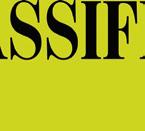
APRIL 28, 2022 - CHICAGO READER 53 e Chicago Reader is now biweekly More than 60,000 copies will be available at nearly 1,200 locations across the city and suburbs. Find one near you and/or download the current issue: chicagoreader.com/map Upcoming Issues: The Sound Issue Pride Issue/WCT Insert Summer Theater/Arts Preview Cannabis Conversations Food & Drink Issue Apr. 28, 2022 May 12, 2022 May 26, 2022 June, 9, 2022 June 23, 2022 July 7, 2022 July 21, 2022 Early Warnings See which artists are coming to Chicago with this essential music calendar of forthcoming shows and concerts—inboxed every Tuesday chicagoreader.com/newsletters KIRK WILLIAMSON chicagoreader.com/classifieds Reach local buyers and find what you’re looking for anytime, anywhere.









































54 CHICAGO READER - APRIL 28, 2022 ll Outside Noise Reduction Keeps Bugs & Spiders Out Reduce or Eliminate Fog & Water Noise from Outside? Visit stormsnaps.com or noisewindows.com sales@stormsnaps.com Alpina Manufacturing, Chicago, IL 1-800-915-2828 Soundproofing Window Inserts the platform The Chicago Reader Guide to Business and Professional Services To advertise, email ads@chicagoreader.com home improvement legal books Fun, Clean, Picture Frame assembly JOB $18/hour Tired or bored of clicking away on a keyboard working at home? Keep your hands and mind busy with a fun, safe, clean assembly job. You’d have your own large assembly zone, at least 15-20 feet away from others, so we’re really safe here. Top rated rm Alpina Manufacturing LLC founded in 1992 Beautiful campus in Galewood, near Mars candy, 3 blocks north of Oak Park. We build and sell display framing systems to customers nationwide including Wal-Mart, Verizon, Circle K gas stations, Hospitals. Full time, Part time, Flex hours for working parents or students. We train, no travel, work in Galewood. Open to any backgrounds. Excellent pay, friendly caring management. Stop in anytime between 7am and 4pm M-F ask for Izzy to apply and check us out. Alpina Manufacturing 6460 W Cortland St., Chicago, IL 60707 business consulting entertainment Brigi e Schmidt Bell, P.C. 847-733-0933 lawyers@bsbpc.com Brigi eBell.com Brigi eSchmidtBellPC Considering Divorce? We Can Help. Collaborative | Prenuptual Divorce | Mediation insurance services health and wellness YOUR AD HERE dance JOIN US! WWW GECHAMBER COM What Greta said . . . shop local 5301N.ClarkSt.Fl.2 CHICAGODANCESUPPLY.COM 773-728-5344 A Matter of Consequences by Michael W. Falls Available on Amazon and Booklocker A Classic Chicago Mystery Customized Massage Therapy, Intuitive Energy Work, and Holistic Talk Therapy 2514 W Armitage Ave, Suite 211 Chicago, IL 60647 773-697-9278 www.intuithealing.com Open Thursday-Monday BY APPOINTMENT ONLY your heading here


















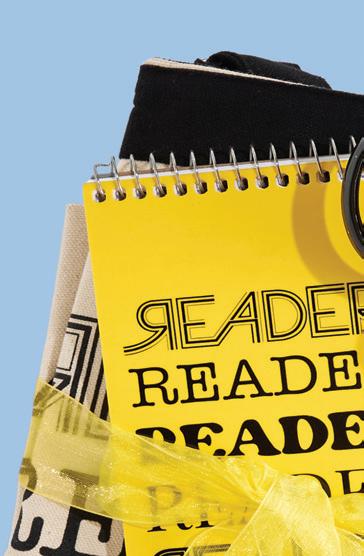



















APRIL 28, 2022 - CHICAGO READER 55 the cannabis platform a Reader resource for the canna curious www.neuromedici.com 312-772-2313 Findouttoday ifmedical cannabisorinfusiontherapyis rightforyou.Telemedavailable! Yourpartnersinhealthandwellness. Serving medical cannabis patients since 2015. To advertise, email ads@chicagoreader.com CBD / cannabis recipes, psychedelic drawings to color, word puzzles to stimulate your brain, growing tips, and more! chicagoreader.com/420book The Budrista platform is a cannabis industry and lifestyle project. Its purpose is to support the healthy and balanced lifestyle of cannabis industry workers. Budrista functions through various outlets such as educational programming and recreational events. By signing up, you’ll have first access to our events and programming! SOMETHING READER FOR EVERYONE! store.chicagoreader.com
Yana Kunichoff
Jackie Serrato
Maya Dukmasova
Taylor Moore
Rebecca Burns
Siri Chilukuri
Michelle Kanaar
Carlos Ballesteros
Brianna Wellen
Darryl Holliday
Cody Corrall
Josh Terry Austin Brown
Pat Sullivan
Adam Mahoney
Mike Boyd
Bridgette Redman
Ted Cox
Ben Austen
Catey Sullivan
Nora Paul
Raven Geary Brady Gerber
Aimee Levitt
Darshita Jain
Michael Izquierdo
Adam M. Rhodes
Bobby Vanecko
Aaron Cohen
Sam Stroozas
Martha Bayne
Amy Qin
Emily McClanathan
Morgan Elise Johnson
Sam Worley
Ed Blair
Jake Austen
Monica Kendrick
Sandra Treviño
Erik Adams
Jack Riedy
J.R. Nelson
Adam Przybyl
Irene Romulo
Gwen Inhat
Sarah Conway
Arionne Nettles
Kaleb Carter
Robert M. Marovich
Jonathan Dale
Mark Guarino
Nico Lang
David Jones
Rebecca Kincaid
Kate Schmidt
Mina Bloom
Stephania Rodriguez
Lior Philips
Bret McCabe
Donald Liebenson
Hannah Edgar Dmitry Samarov
Maia Spoto
Whet Moser
Kerry Cardoza
Tal Rosenberg
Mike LeSuer
Taylor Glascock
John Wilms
Kevin Warwick
Tiffany Walden
Freddy Martinez
Marc Daalder
Amanda Whitlock
Jaclyn Jermyn
St Sukie de la Croix
Quinn Myers Kelley Tatro Brandon Wall
Cameron Kelsall Casey Toner Nader Issa
Carrie Shepherd Patrick Lyons Tonia Hill
Jesus J. Montero
Andrew Fan
Matthew Sigur
Paco Alvarez
Eric Bennett Zack Miller
Emily Lipstein
Alejandro Hernandez
Evan F. Moore
Nancy S. Bishop
Heather Lalley
Jes Skolnik
Mark Yarm
Grace Del Vecchio
Eric Vilas-Boas
Maira Khwaja
Rachel Fernandez Scott Gordon
Niko Stratis
Steven Spoerl
Anna White
Michael Rancic

Elizabeth Tamny
Jonathan Eig
Emma Oxnevad
Kathleen Sachs
Alex Arriaga
Jenni Spinner
Aaron Cynic
Tracey Lindeman
Marissa Oberlander
Parker Molloy
Dan Kelly
Gregory Pratt
Ryan Rosenberger
Atavia Reed
KT Hawbaker
The People’s Fabric
Rich Miller
Michael Workman
Megan Kirby
Ricky O’Donnell
Corli Jay Jhmira Alexander Elisa Shoenberger
Claire Bushey
Clarissa Donnelly-DeRoven
Max Grinnell
Noah Berlatsky
Amanda Finn Jamie Nesbitt Golden
Patrick Masterson
Chicago Free Media
Paul Dailing
Bea Malsky
Sheri Flanders
Jacoby Cochran
J. Howard Rosier
Sean Larson
Aaron Gettinger
Maya Holt
Tatiana Walk-Morris
Annette LePique
Michaelangelo Matos
Heather Corinna
Hanif Abdurraqib
Josh Flanders
Lillian Stone
Jared Holt
Jennifer Bamberg
Laura Adamczyk
Adam Morgan Deborah Douglas
Sara Amato
Dennis Lee
Stephen Walker
Michael Nagrant
Mark Misulonas
Mike Vanderbilt Michael Gebert
Nikita Amir
Patrick Murfin
Brooke Binkowski
Russell Leung
Robert Loerzel Mick Dumke
Charmaine Runes
Sam Stecklow
Erin Hegarty
Brian J. Bowe
Jill Hopkins
Kate Gallagher
Susan Thomas
Joshua Minsoo Kim
Jim Kopeny
Wendy Fox Weber
Meribah Knight
Miranda Perez
Derrian Carter
Alec Karam
Alison True
Eli Enis
Kenyatta Victoria Isra Rahman Gregory Gillam
Dave Roknic
Kiki Yablon
Myron Meisel
Kate Scott Daly
Madeline Buckley
Sean Margaret Wagner
Tempestt Hazel Jared Rutecki
Joel Reese Dan Sinker
Jennifer Swann
Bryan Boyer Bill Savage Rex Huppke John Dugan
Jennifer McLaughlin
Anjulie Rao
Maggie Sivit
Marykate O’Meara
Elvia Malagón
Steven Krakow
Maureen Kelleher
Christopher Piatt
John M. Cunningham
Justin Laurence Irv Leavitt
Megan Sauer
Carrie Maxwell
Caroline (Coco) Picard
Brian Gunderson
Amanda Hess
Eiren Caffall
Jen Torwudzo-Stroh
Ryland Pietras
Megan Stielstra
Sarah Lazare
Stephanie Casanova
Jason Cohen
Matt Harvey
Cam Rodriguez
Dan Jakes
John Carruthers
Jack Probst
Zachary Long Olivia Stovicek Mari Cohen Emeline Posner
Kris Vire
Kim Wilson Buck Hayley Schueneman
Peter Margasak Dave Awl
Andrew Davis
Stacy Fernandez Alyssa Edes John Huston Katie Koranda Don McLeese Tony Peregrin Colleen Morrisseey Matt Brun Jennifer Brandel Laurie Fanelli Christine Fernando Brittany Trang Irene Hsiao Matthew Simonette Matt Chapman Heather Kenny
Trenton Roberts Lloyd DeGrane Jason Schumer Jonathan Rosenthal
Lily Wachowski Deborah Pugh David Murray Cecilia Reyes
Kristen Lambert Jacob Arnold Jeff Terich Sammi Skolmoski Justin Agrelo Jack Silverstein
Dana Brozost-Kelleher Maureen O’Donnell
Mark Braboy
Rachel Hinton Monica Reida Nina Li Coomes Caroline Patton
Marcus Gilmer
Hannah Faris Jason Lo Henry Redman Natalie Frazier Sam Allard
Maria Ines Zamudio
Paul Engleman
Dan Mihalopoulos Mariann Stephens
Andrew Gill
persephone van ort Chris Thompson David Roth
Elizabeth Blasius
Jake Malooley Jack Helbig
Ata Younan
Laura Wagner Eric Zornd
William Meyer
Katie Foran-McHale
Jessica St. Ama Rima Parikh Sarah Collins
Devin Schiff Kim Kelly Nina Corcoran Kris Karnopp Gabriel Aikins Gavin Good Joe Guszkowski Matt Schur India Daniels Kelly Kleiman Joshua Irvine Nate Marshall Paul Biasco Joshua Irvine Matthew Ritchie Laura Pearson Colin Boyle
Zachary H Lipez Leah Geisler James Edwards Gina Fattore
Sue Kwong Jake Berent Neil Tesser Blair Paddock Megan E. Doherty
Morgan McFall-Johnsen
Laura Casey
Tyra Triche
Boutayna Chokrane Robin Amer Alma Campos John Kroll
Maya Schenwar
Justin McGown Samantha Smylie Drew Hunt
Jeff Schuhrke
Renaldo Migaldi Julian Ramirez
Kip Kania Jessica Mlinaric Michelle Bruton
Jeremy Gordon Devlyn Camp
Ricardo M. Lopeze
Lisa Shames
F. Amanda Tugade S. Nicole Lane Mareva Lindo
Amethyst J. Davis Clare Lane
Alex V. Hernandez
Lloyd Sachs Julia Thiel Danette Chavez Kate Dries Milo Cain Caleb Brennan Sofi LaLonde Noah Simon Matthew Shanahan John Greenfield Seth Putnam
Ashley Bardhan Dan Hyman Dillon Edlin
David Anthony Peter Zimmermano Kaylen Ralph Annie Zaleski Mike Tish
Shy Thompson Lynda Lopez John Cotter
Naomi Waxman Ray Pride
Ellery Jones Josh Modell Benji Hart
Lindsay Eanet Rae Nudson
Rosamund Lannin Annie Howard
Jonathan Ballew Annie Johnson
Meggie Gates Elena Bruess
Jacqui Shine
Brandon Sward Matt Schimkowitz Aaron Hunt
Mána Taylor Tom Schuba Andrew Hayward
Francisco Ramirez Pinedo Griffin Krueger Miles Kampf-Lassin Ines Bellina
Thank you to all of our supporters in media and the labor movement who helped the Reader Union win our campaign to save the Reader. Special thanks to all the journalists and media makers who signed an open letter in support of our demand to Free the Reader! We could not have won without you.






























 By ISA GIALLORENZO
By ISA GIALLORENZO














































































































 BY ISA GIALLORENZO
BY ISA GIALLORENZO













































 @dalejondale
@dalejondale











 told to PHILIP MONTORO
told to PHILIP MONTORO

























































































































 —JOSHUA MINSOO KIM
—JOSHUA MINSOO KIM




































































































































